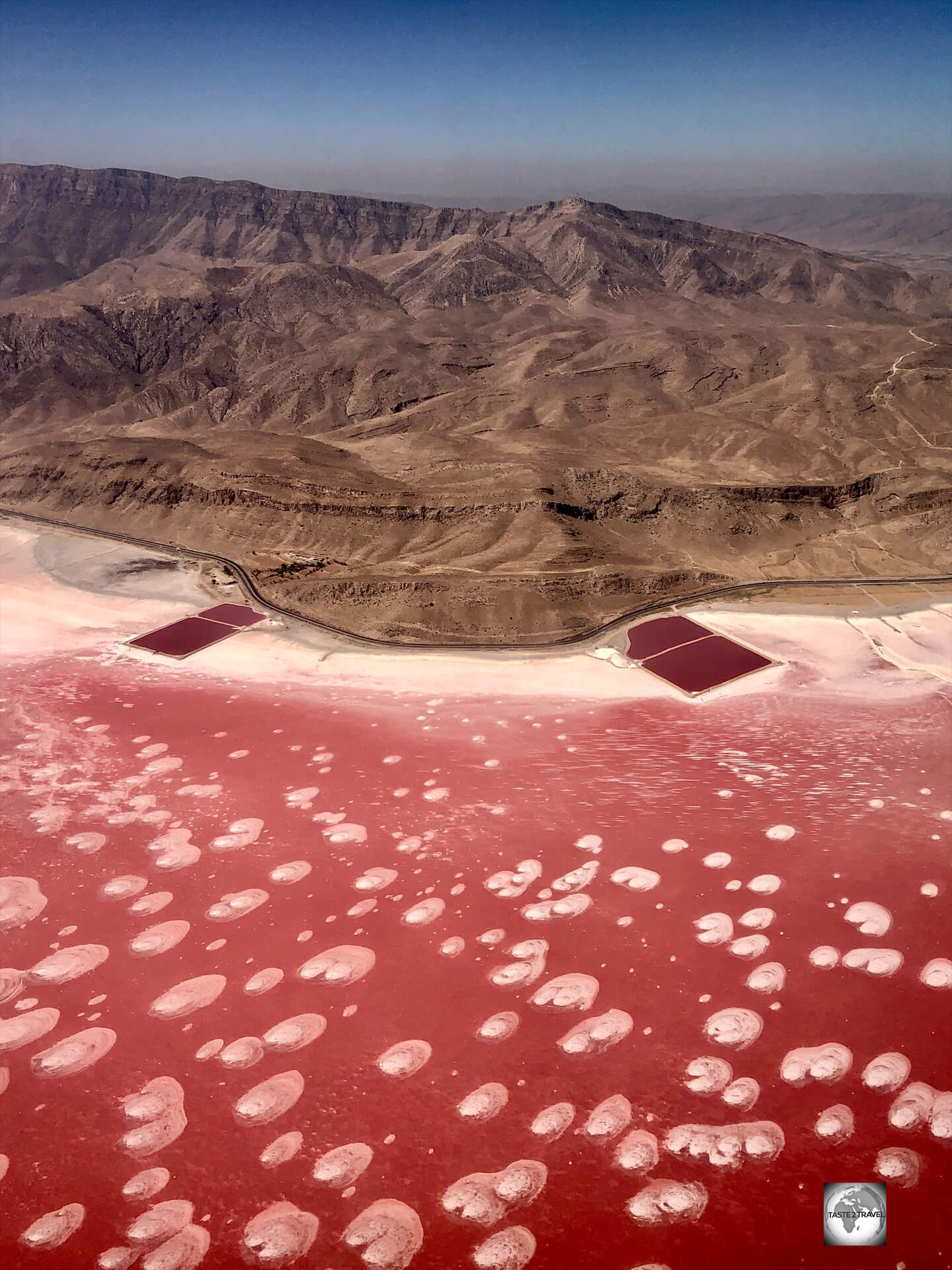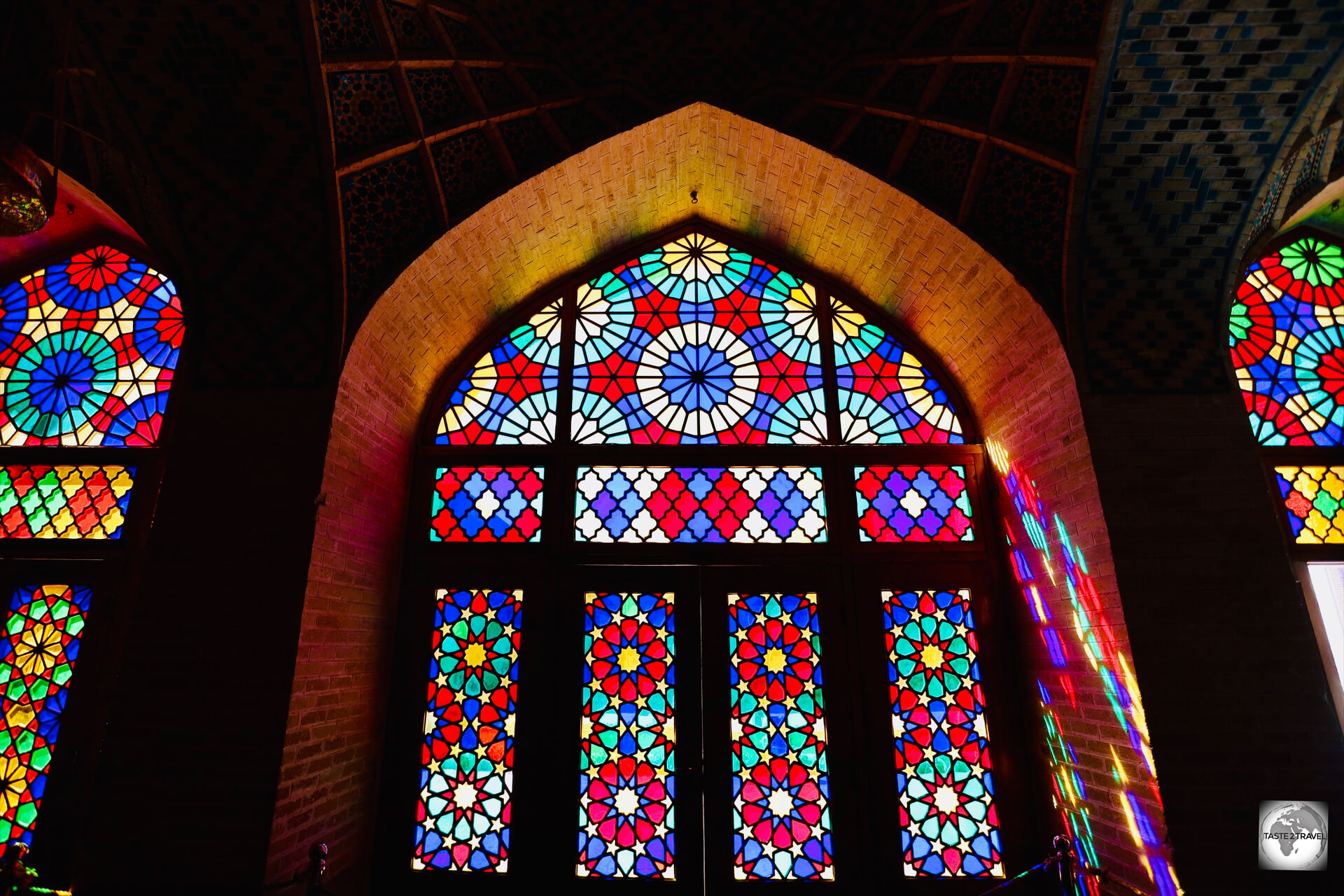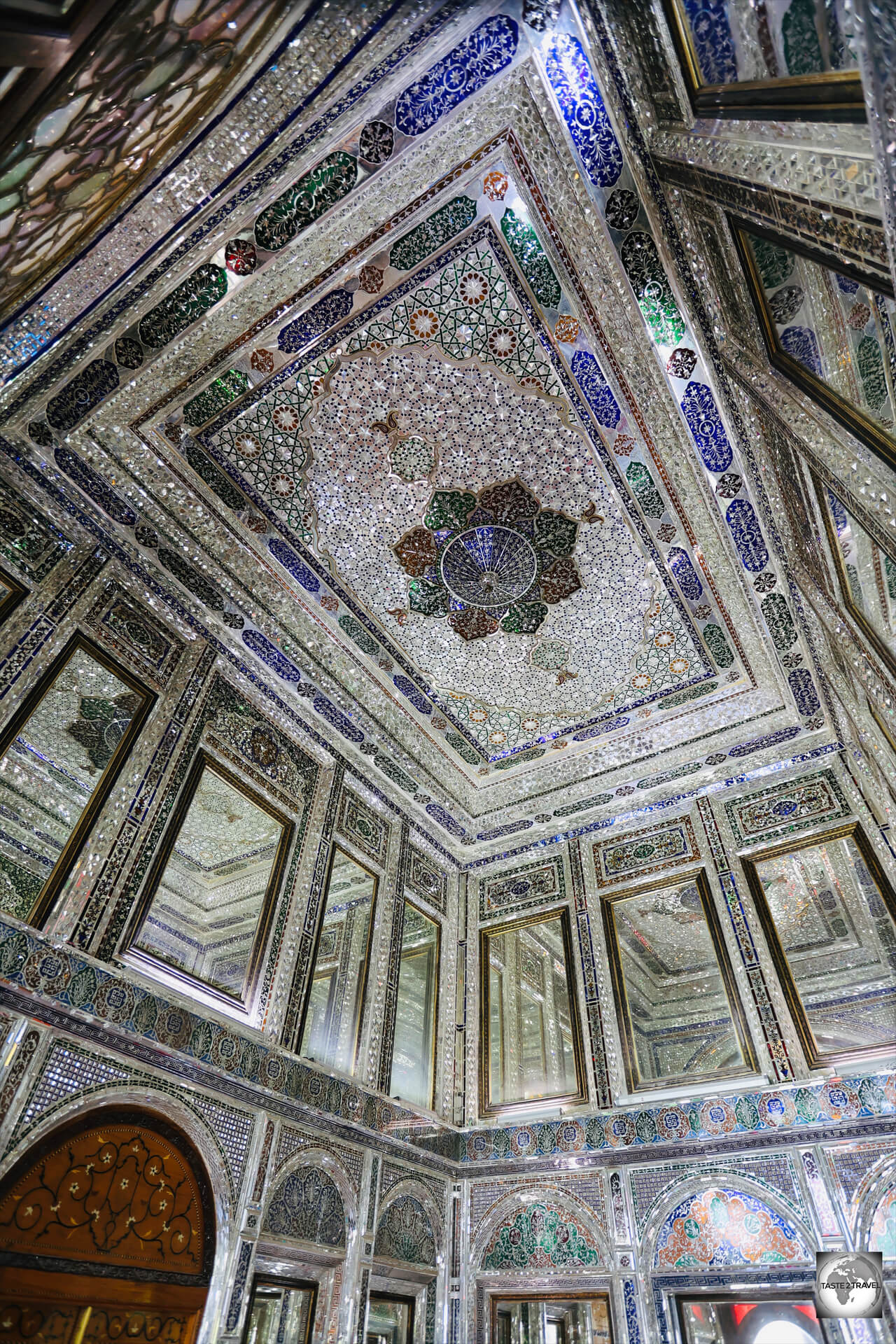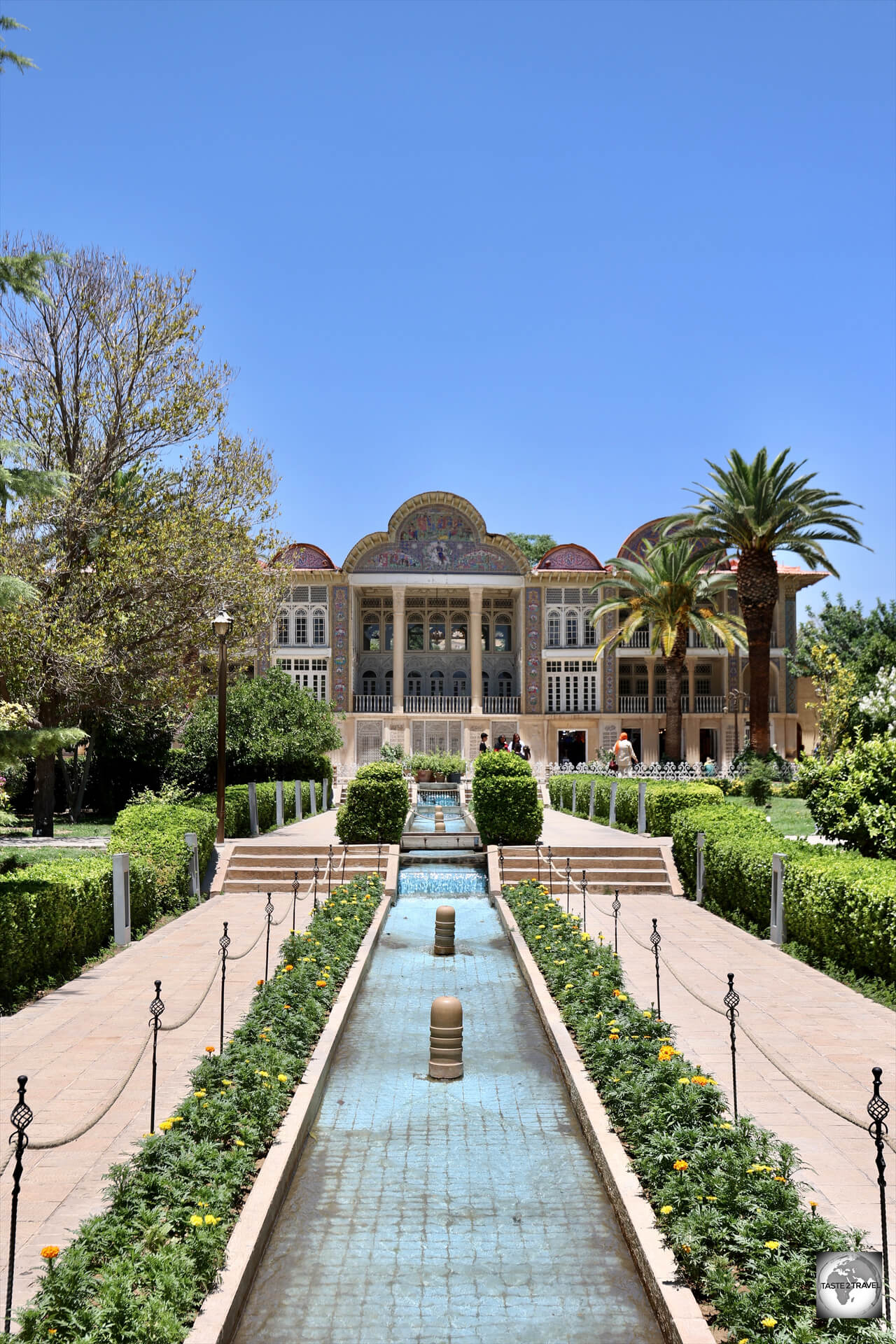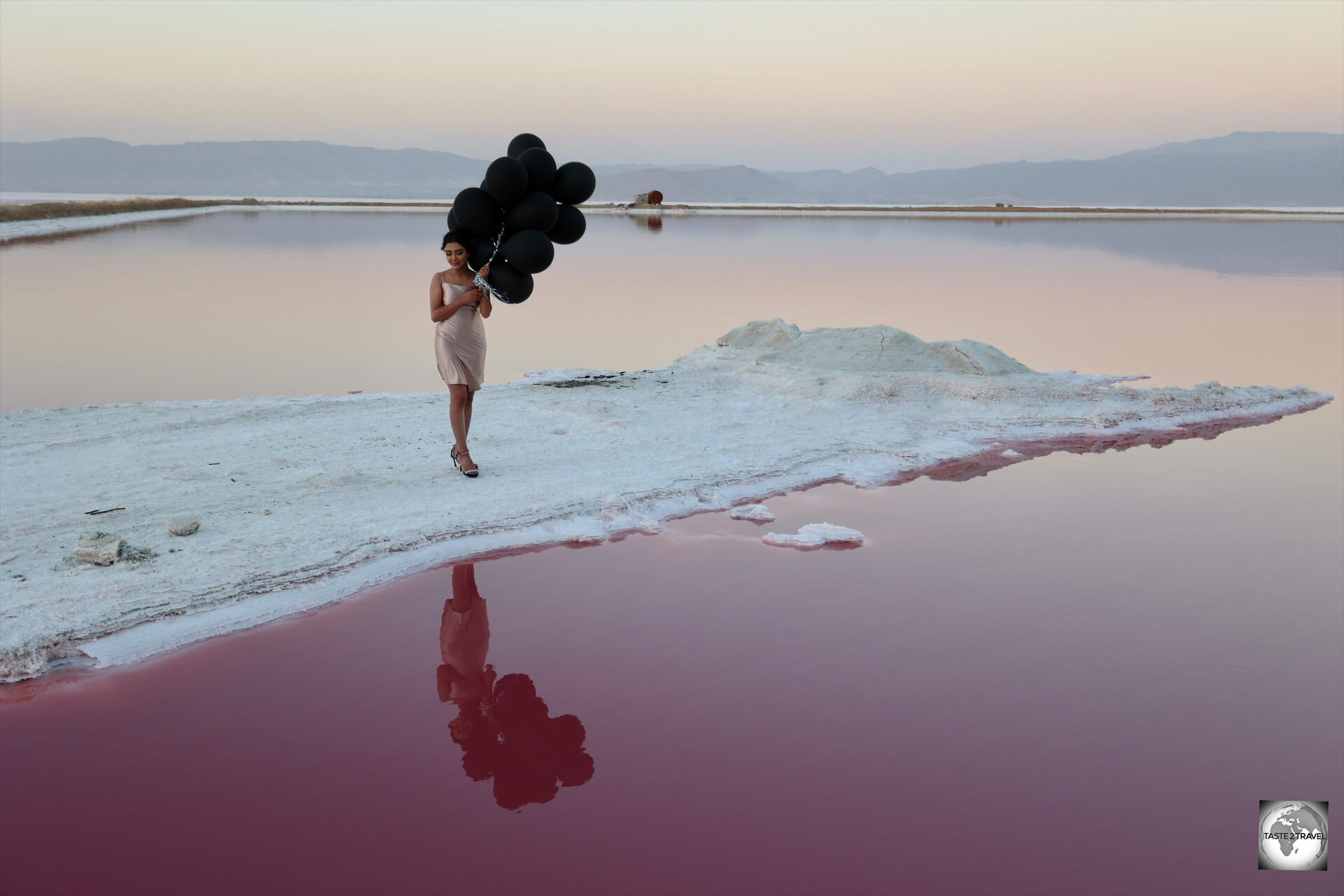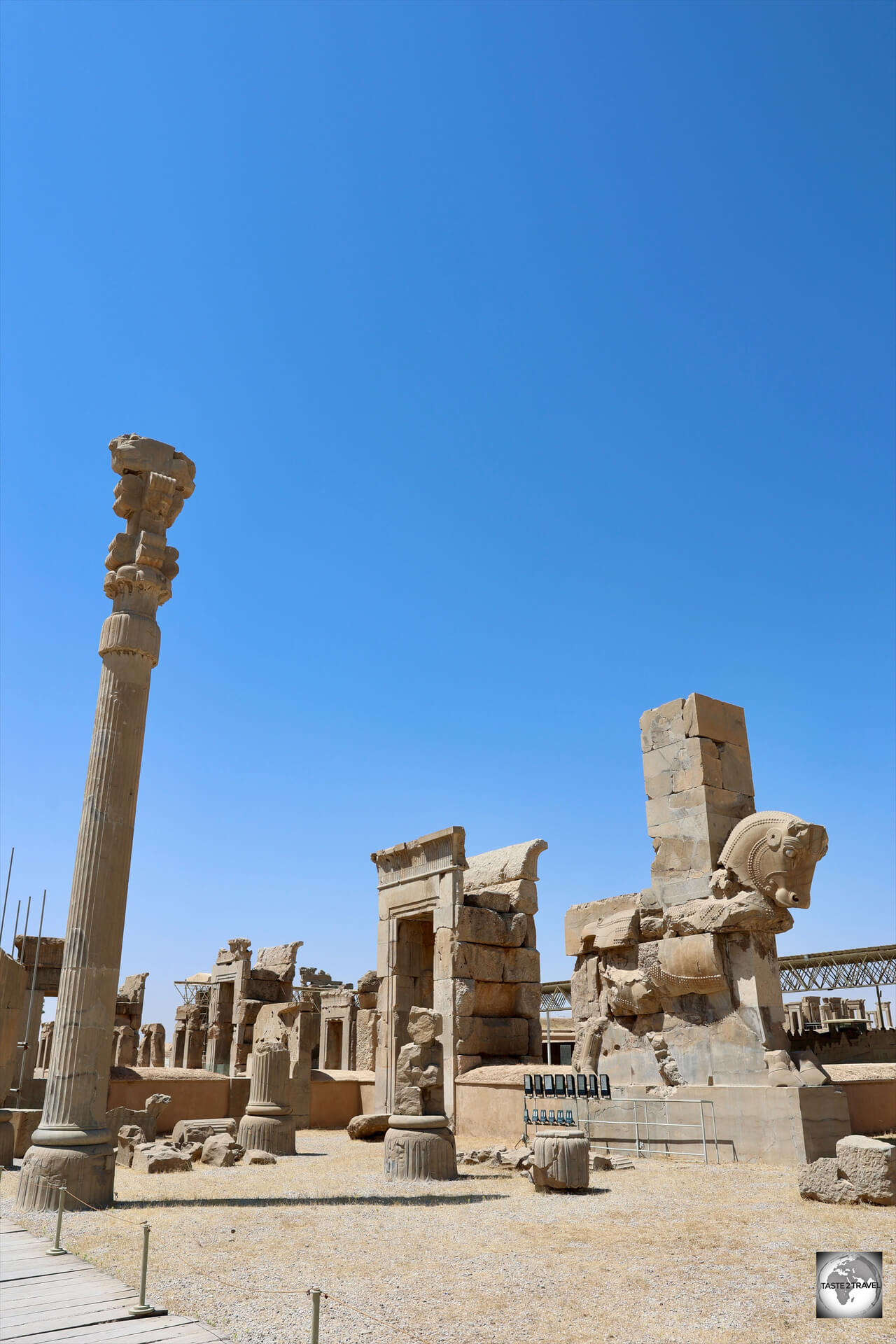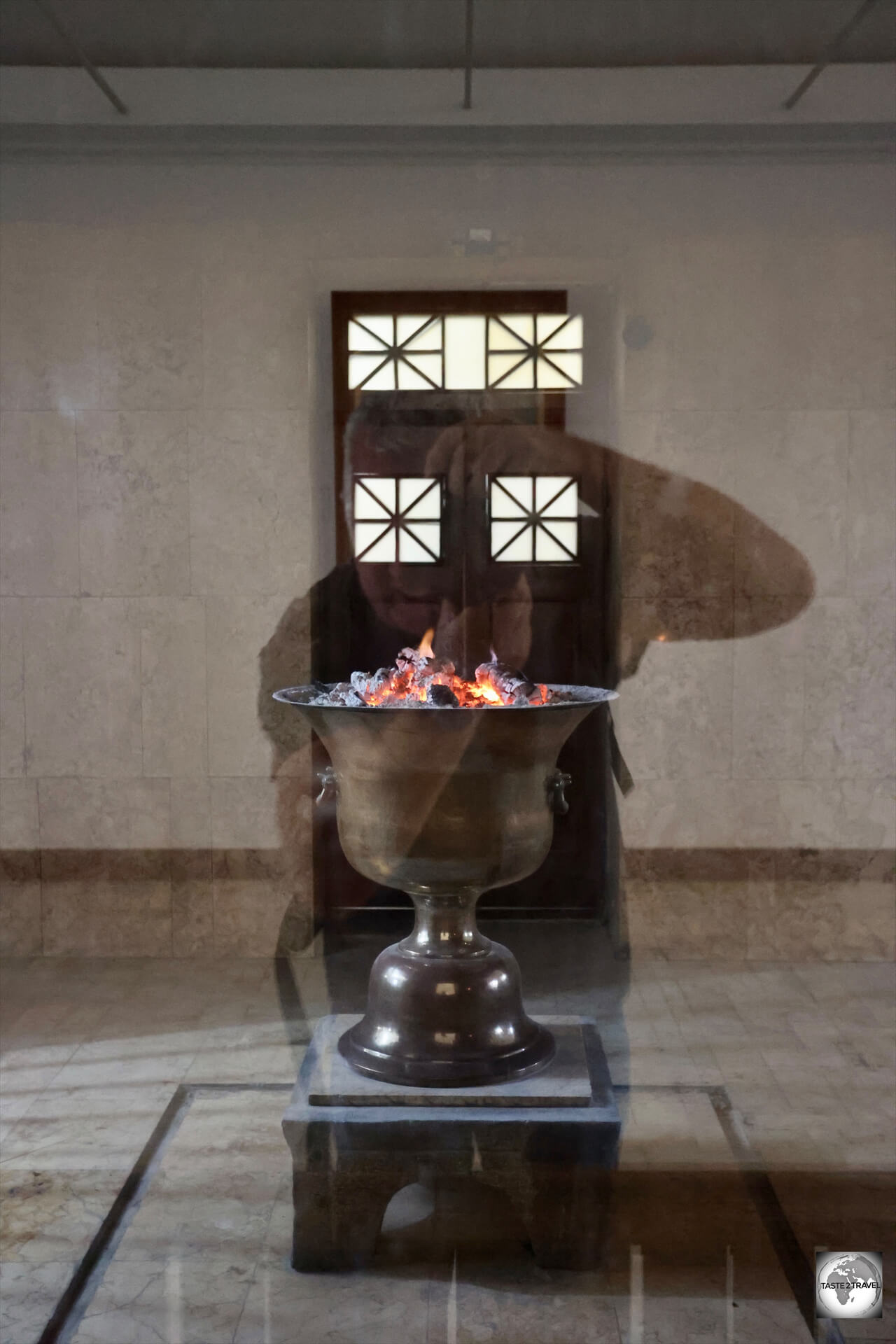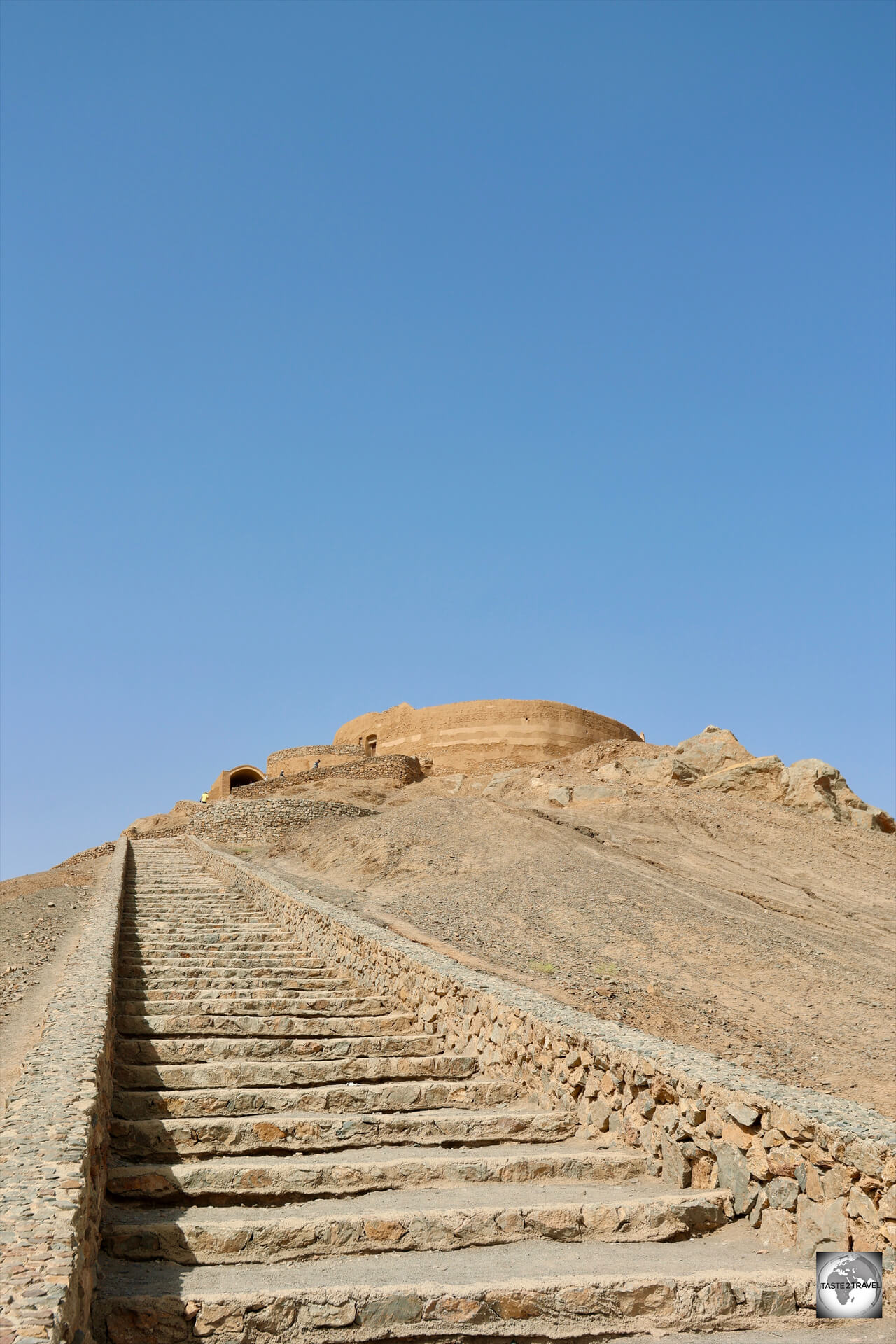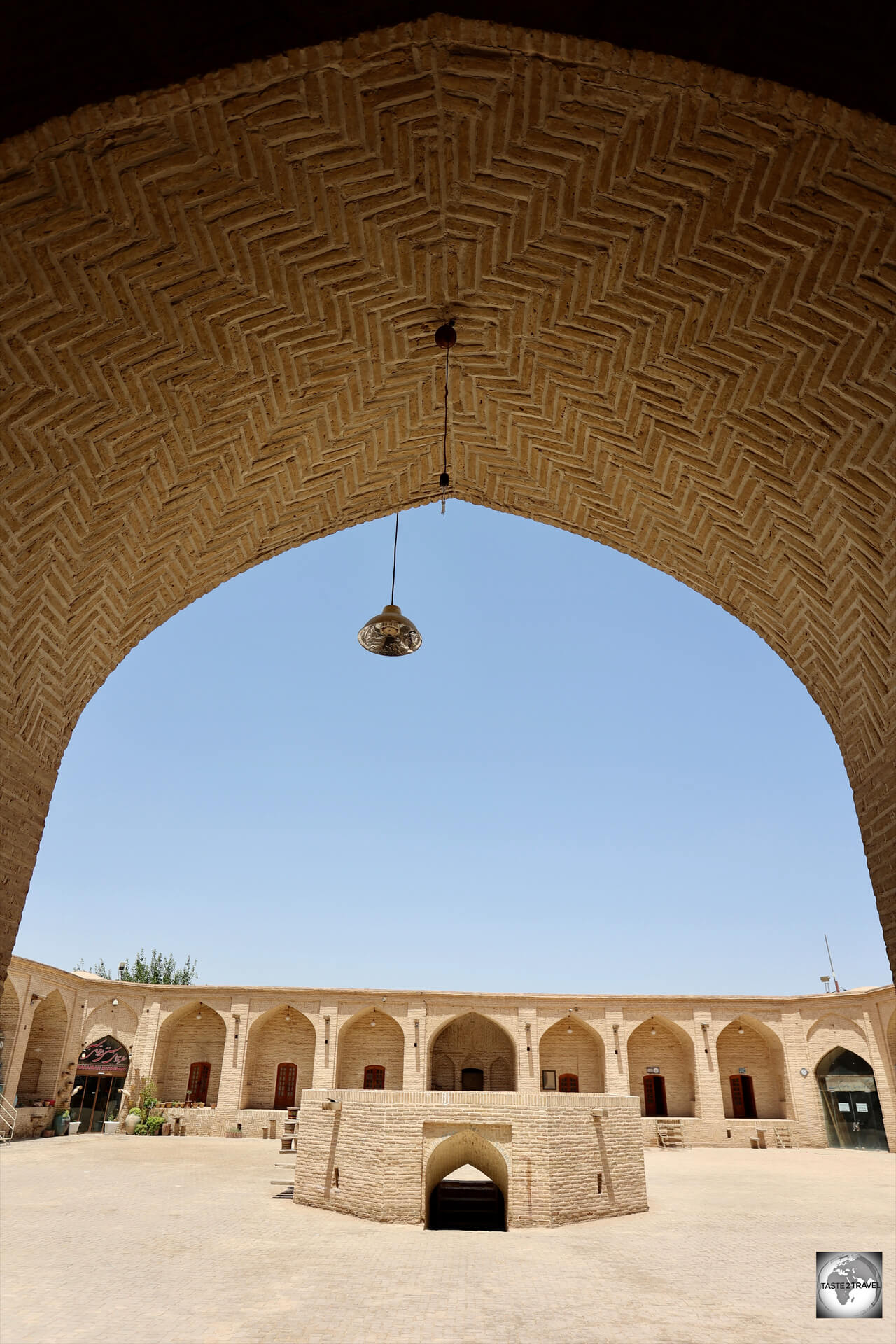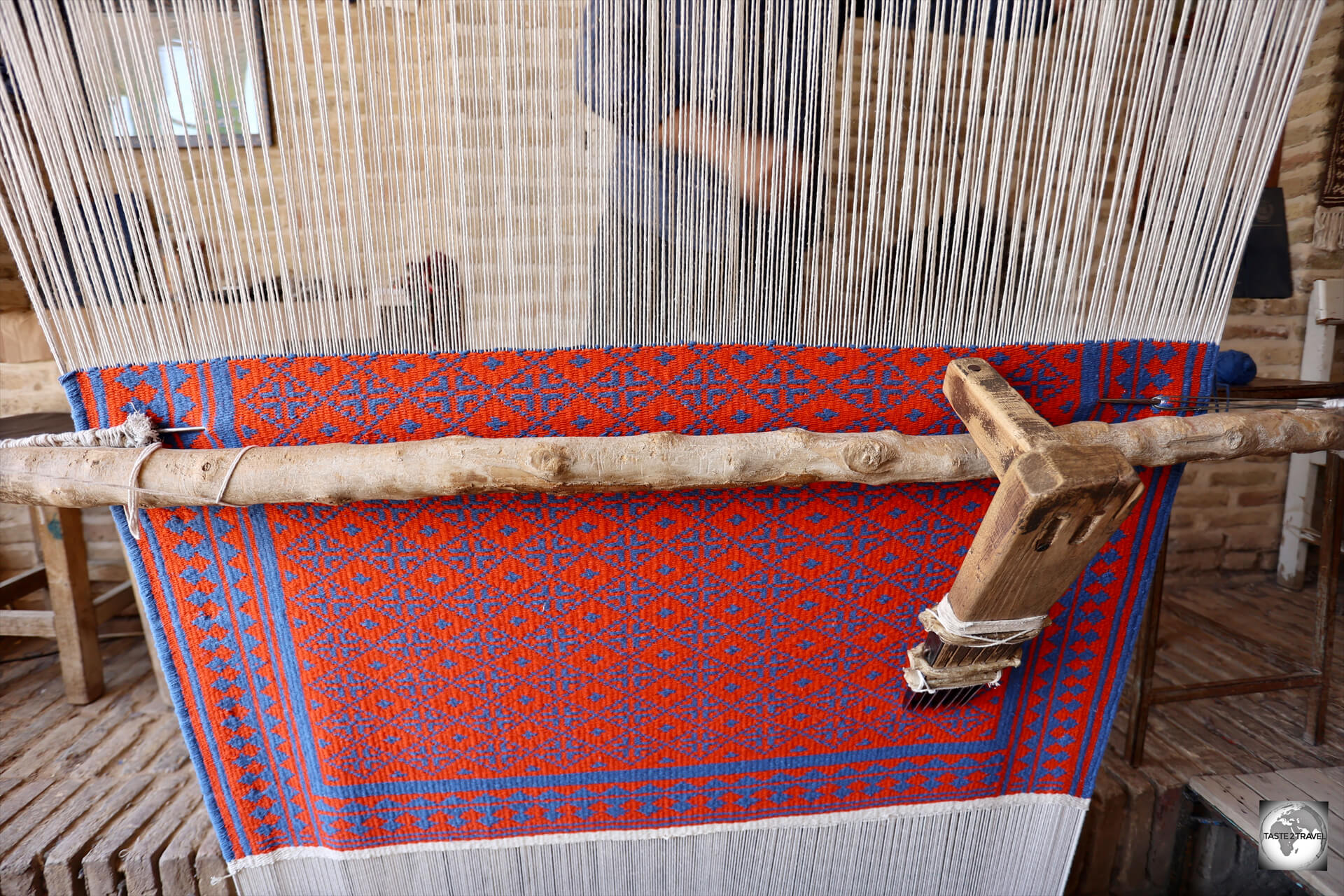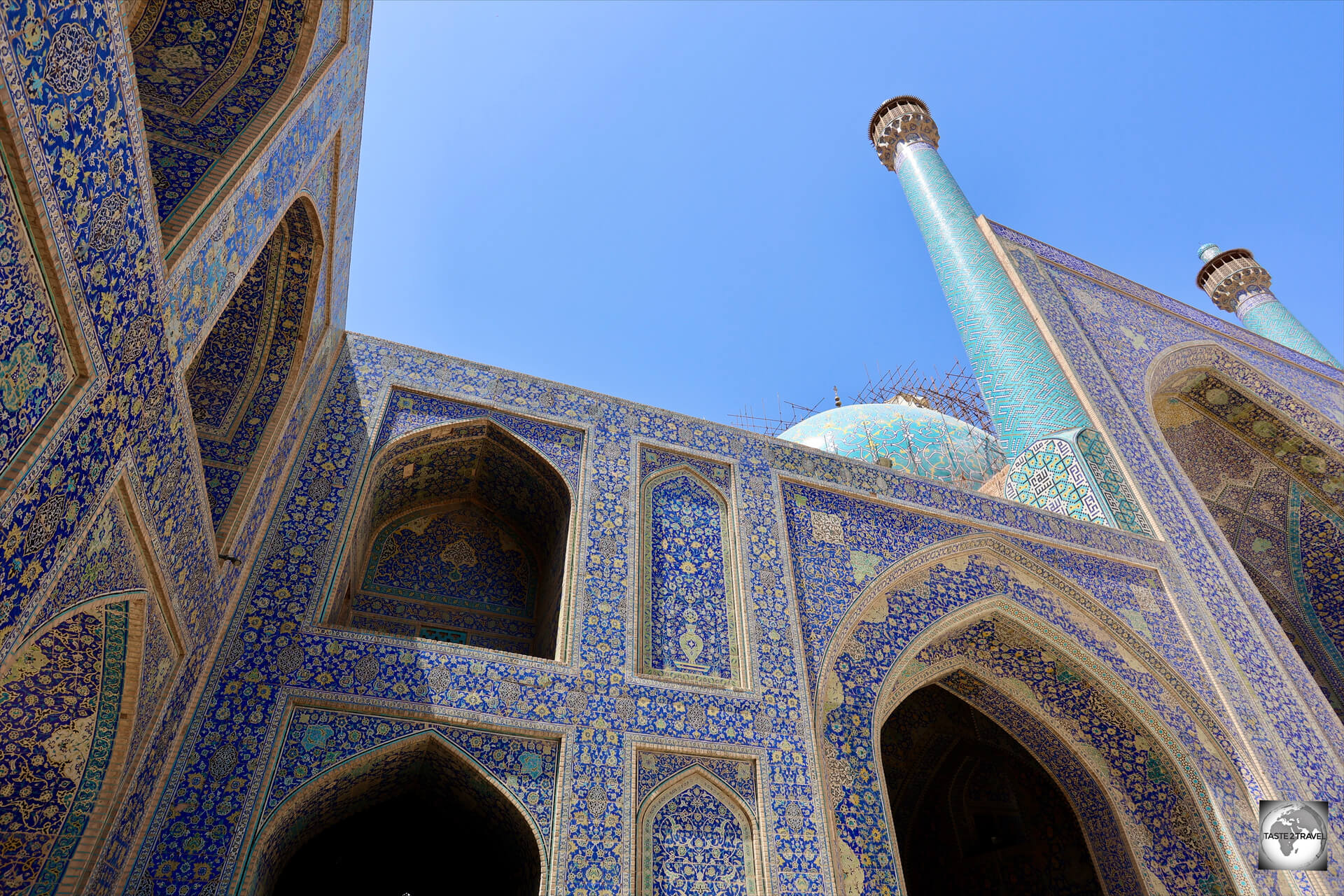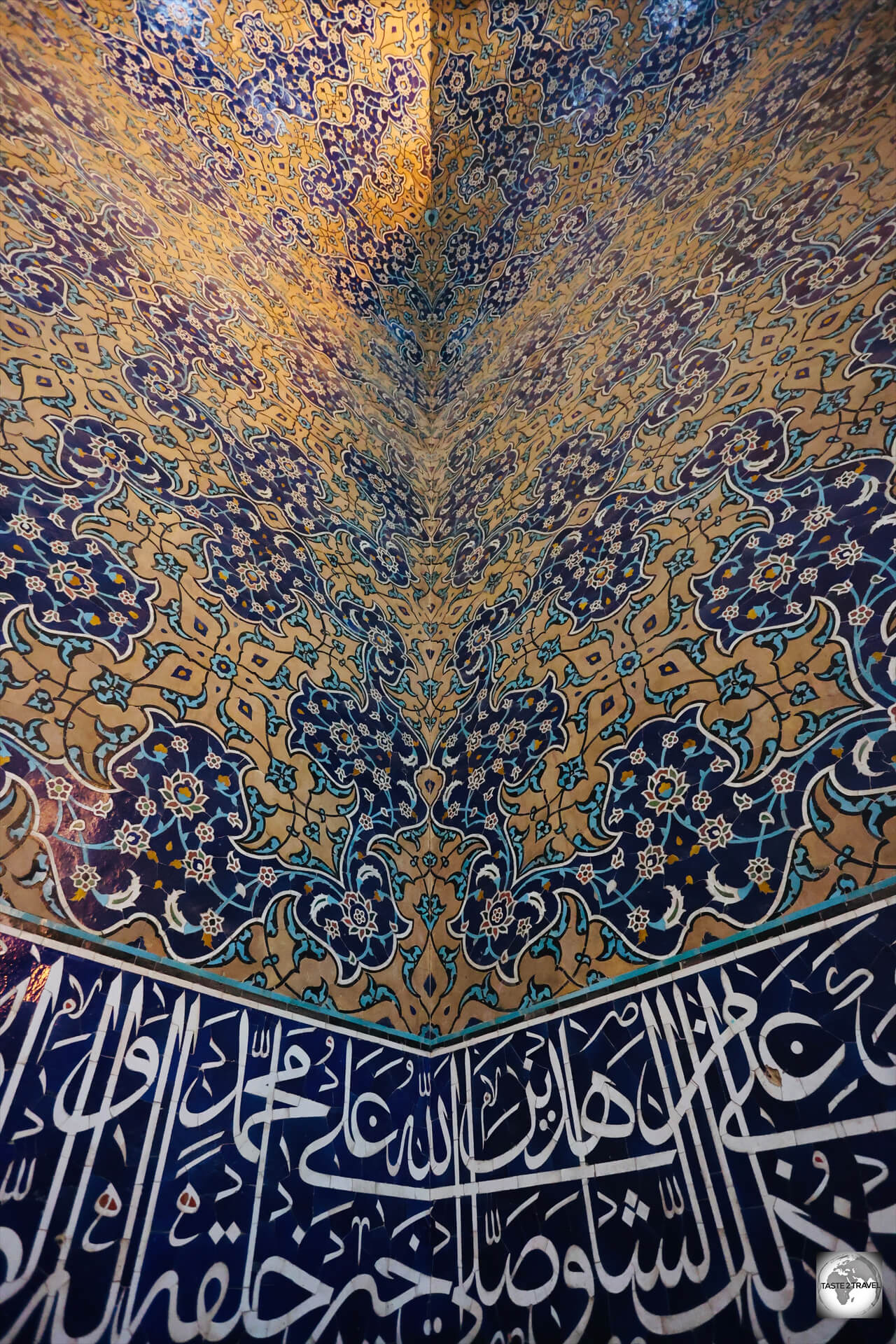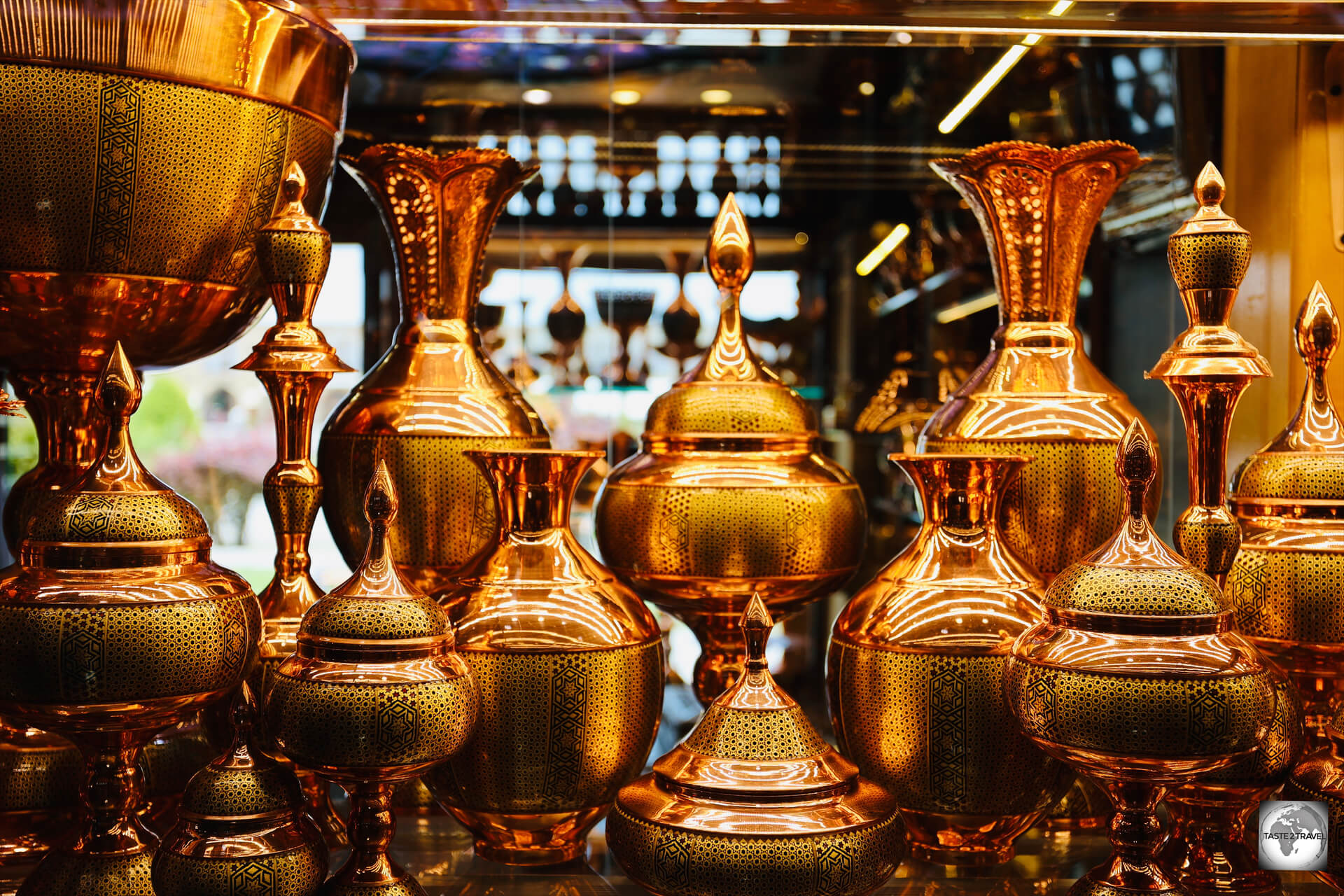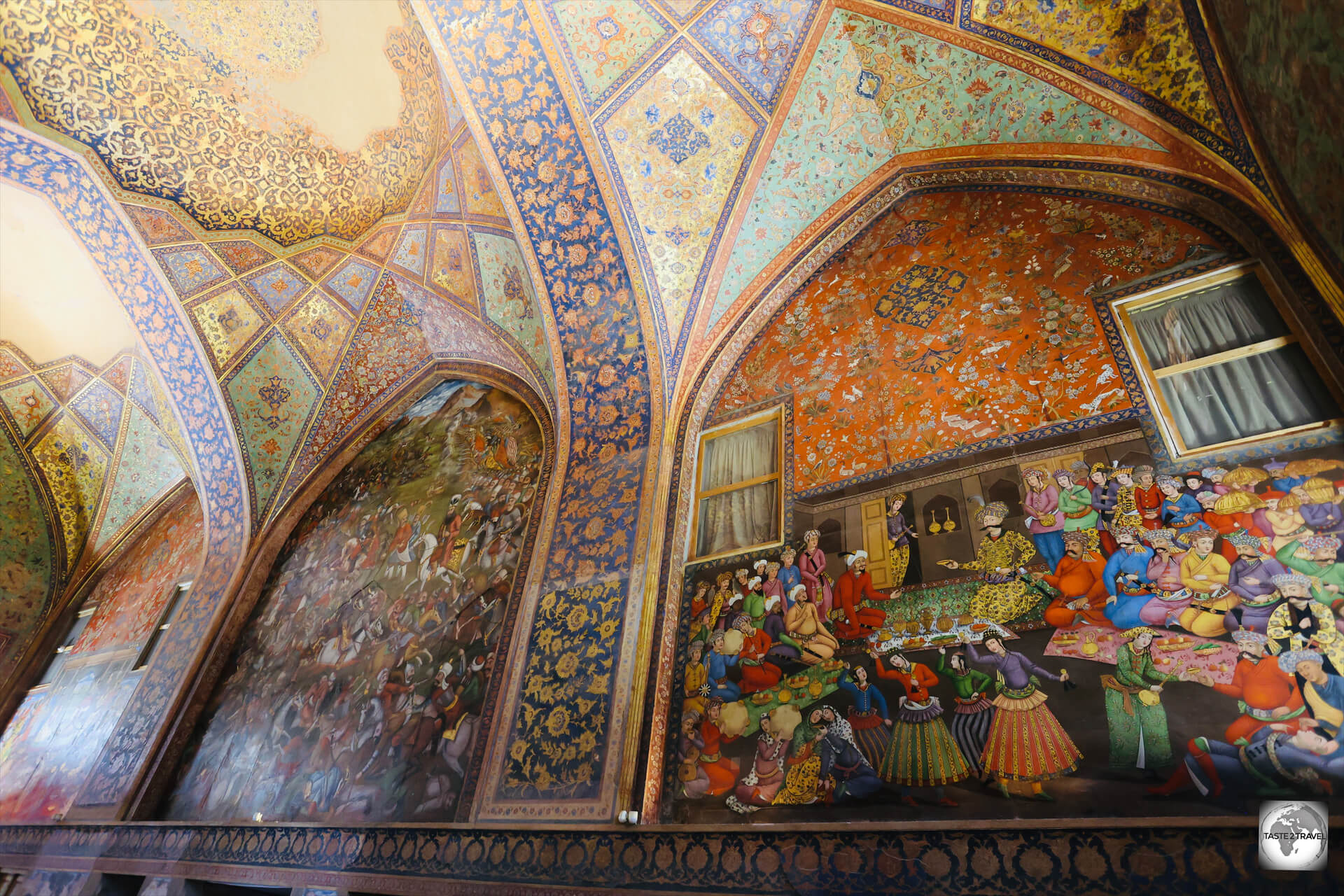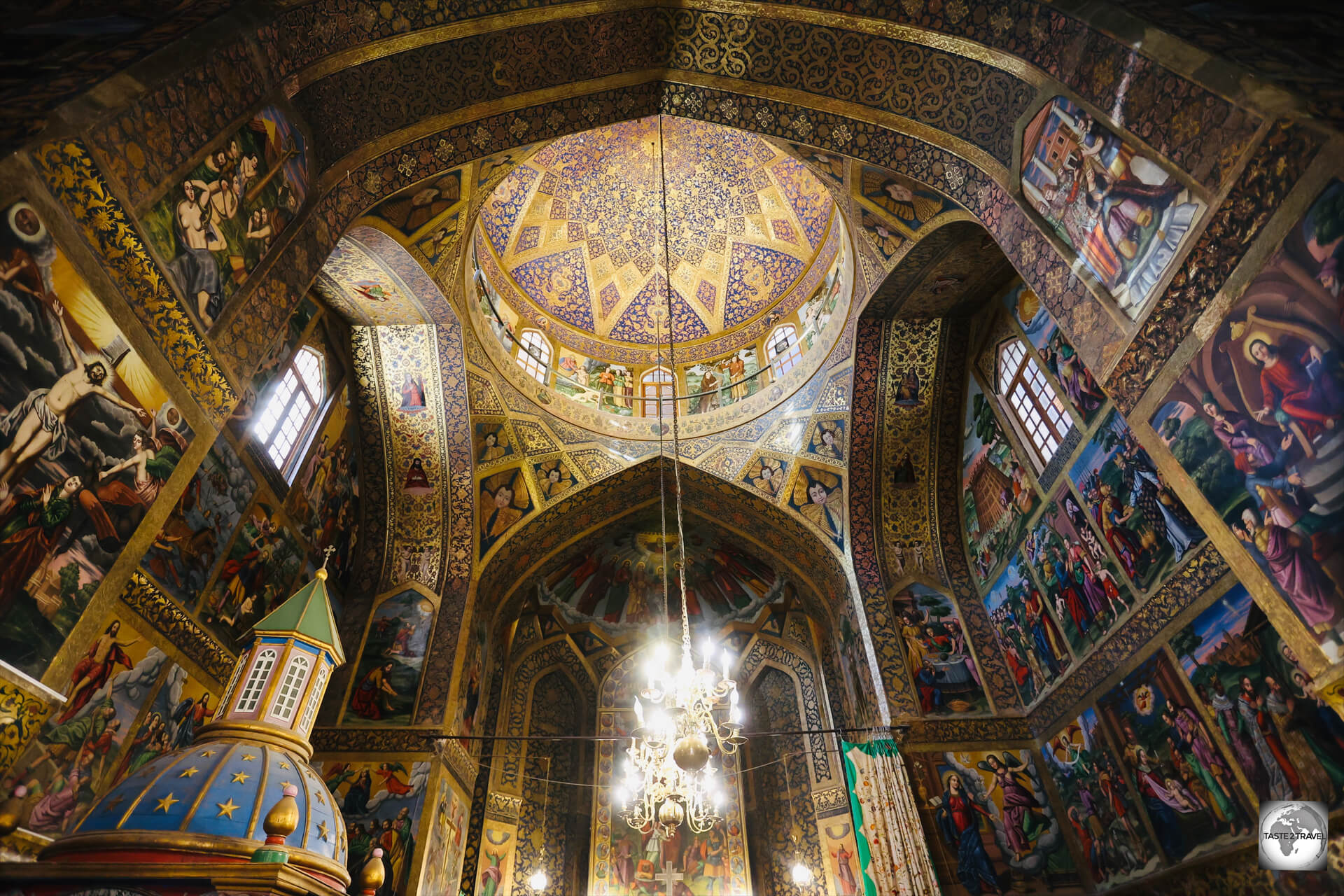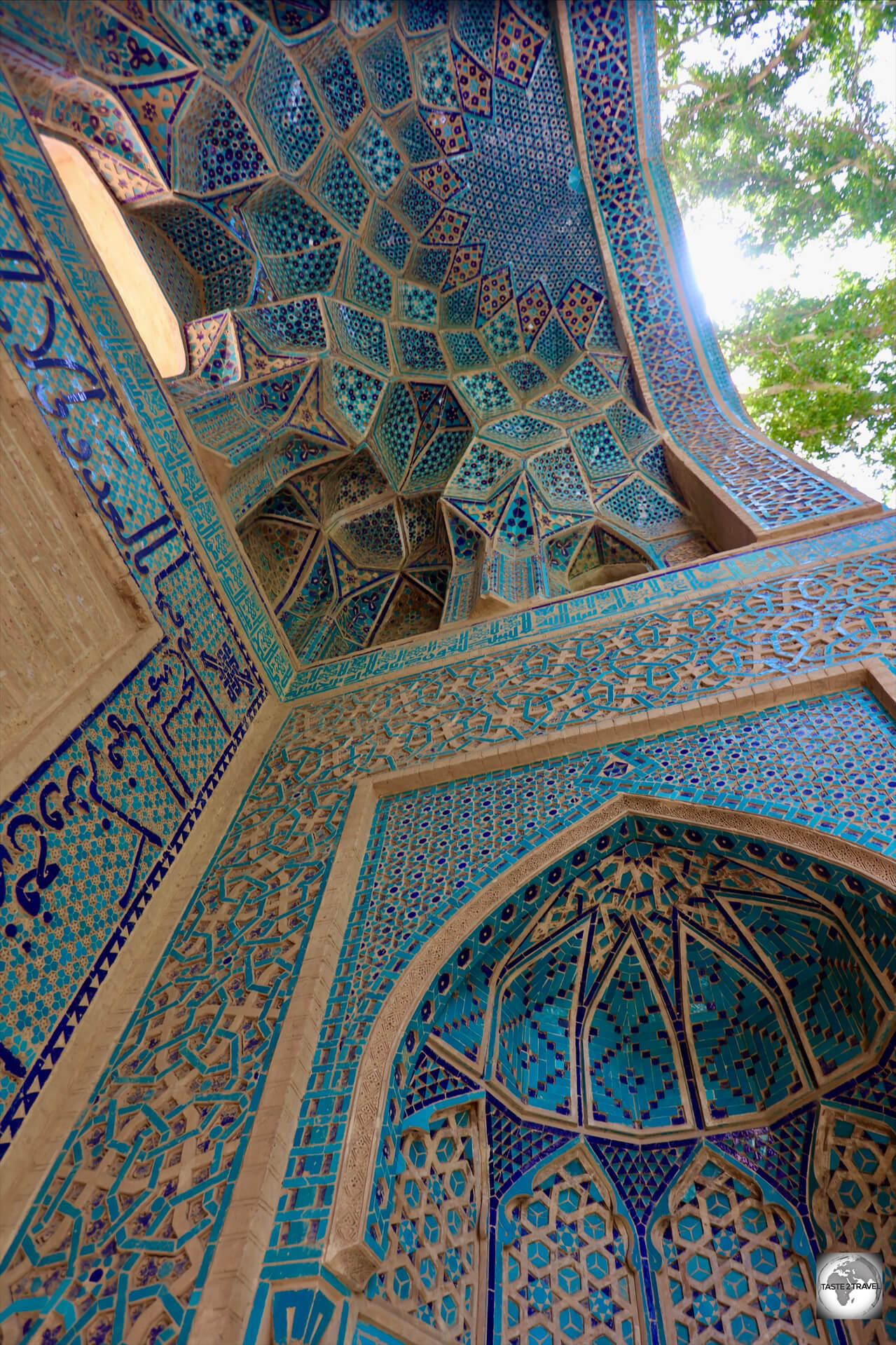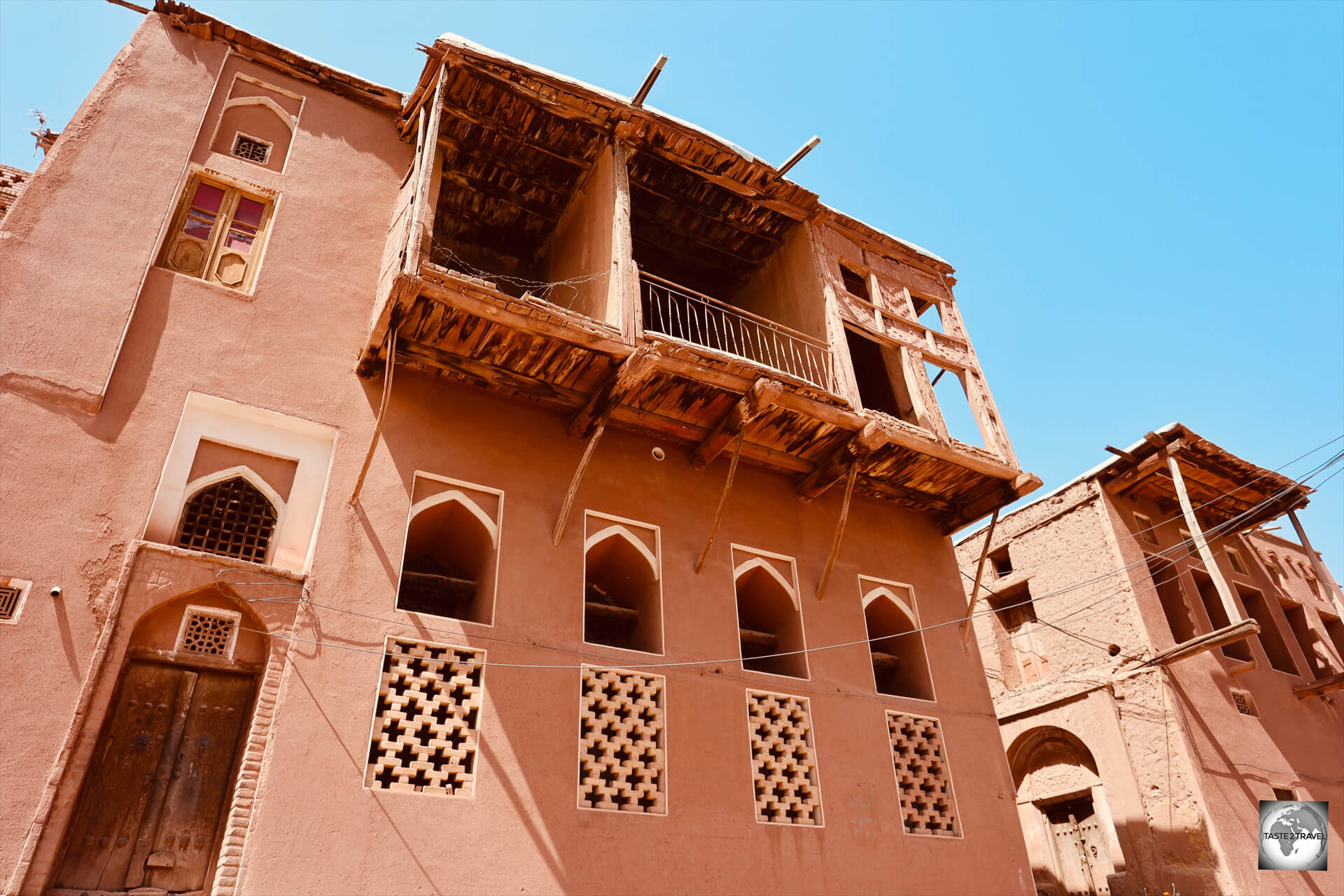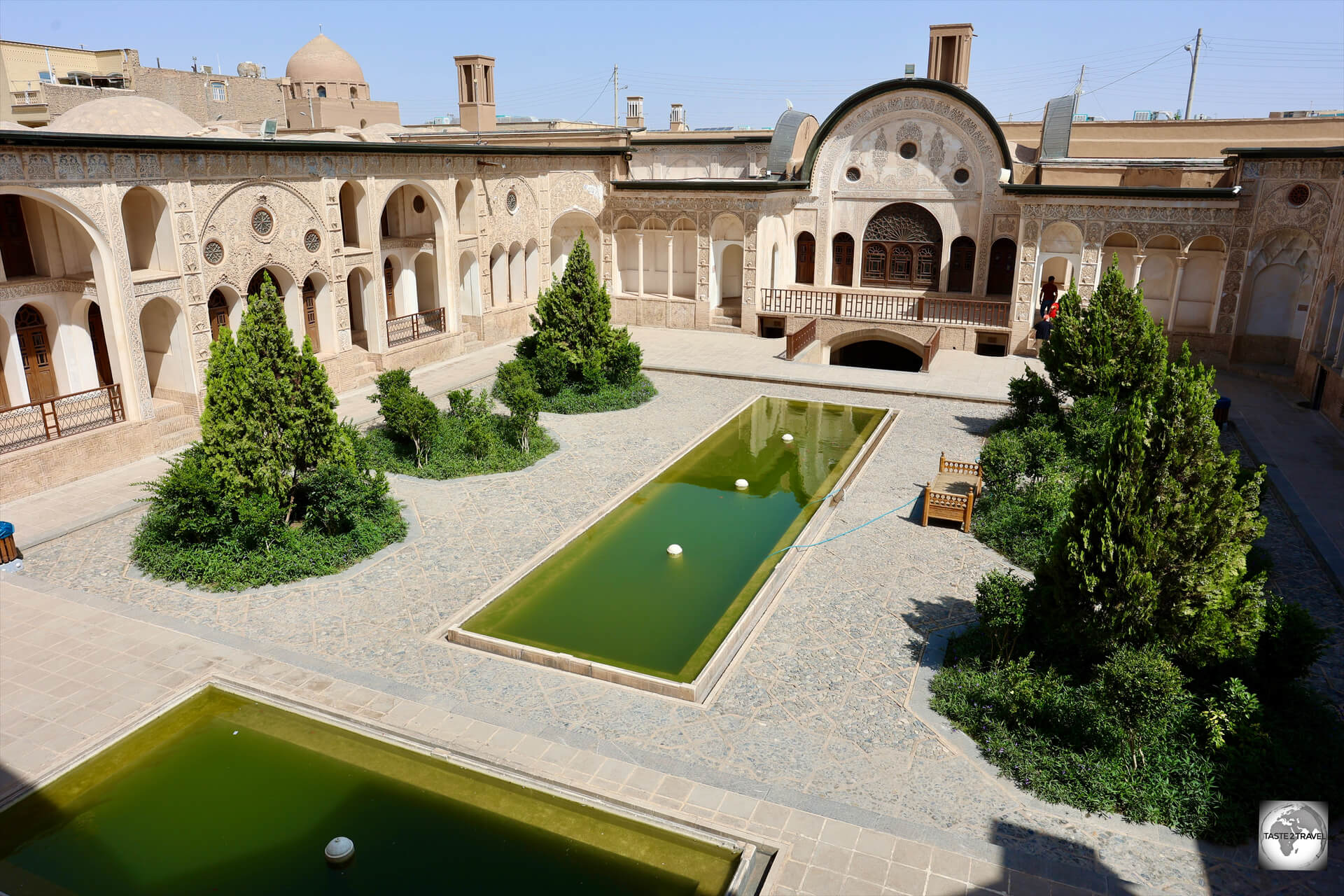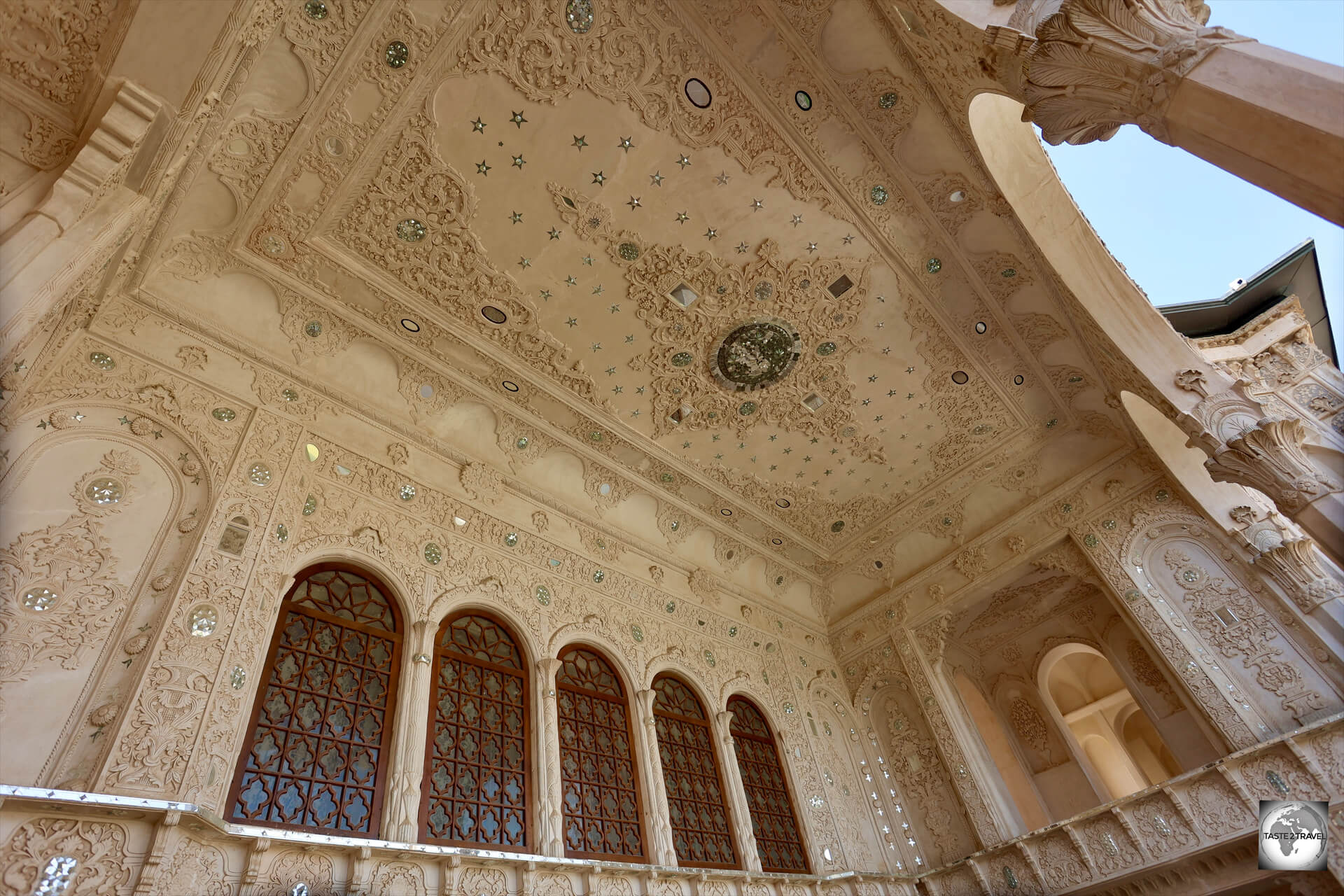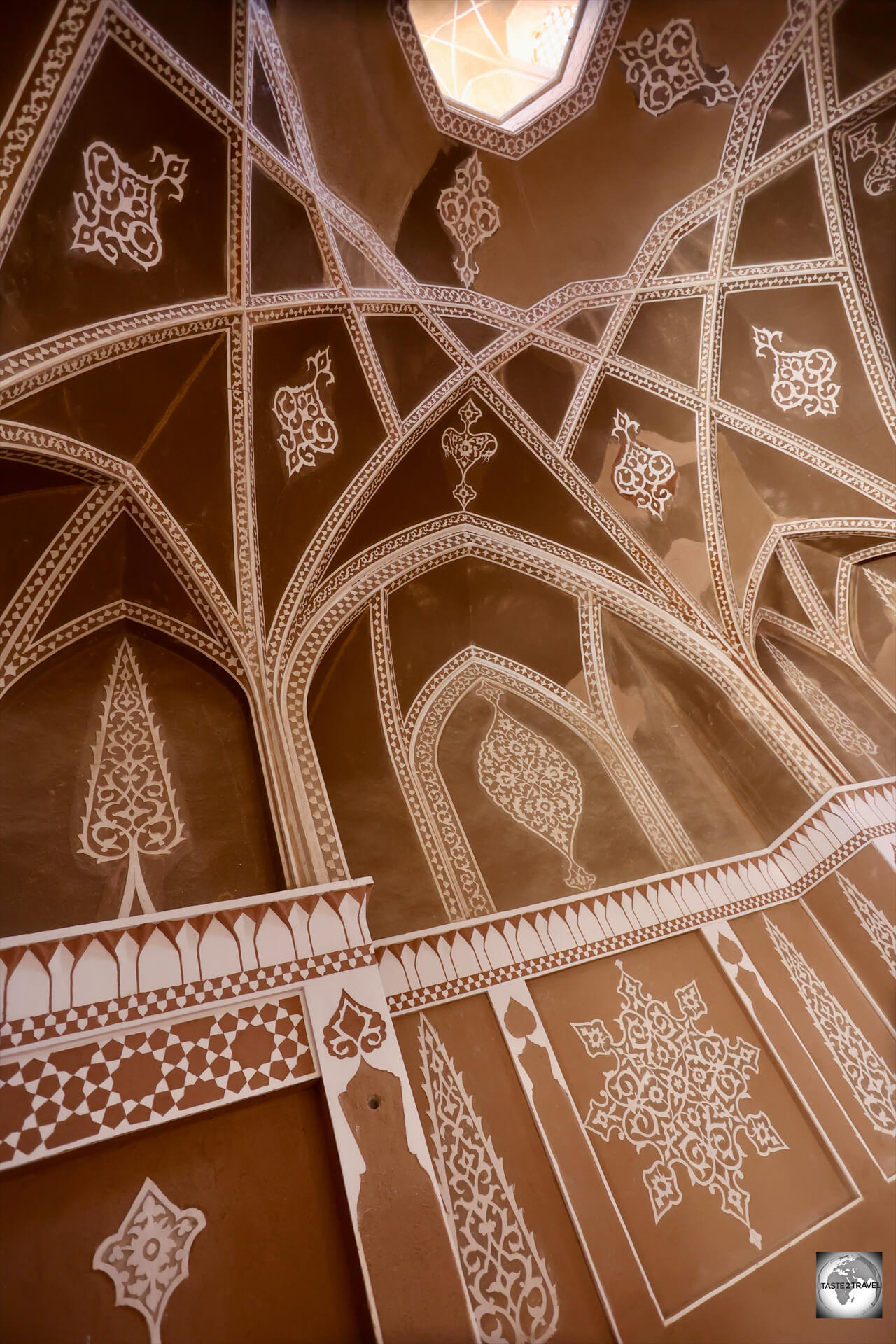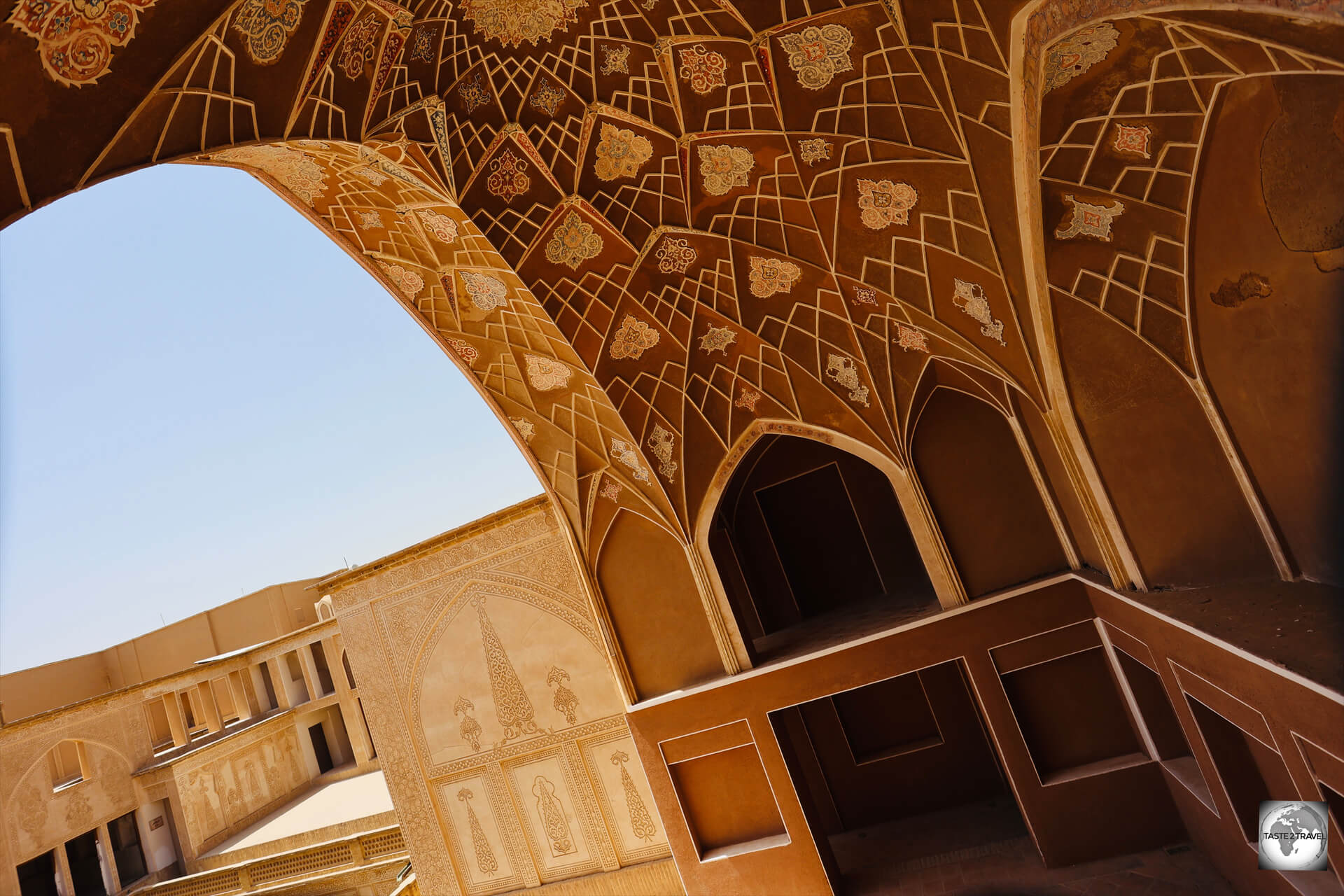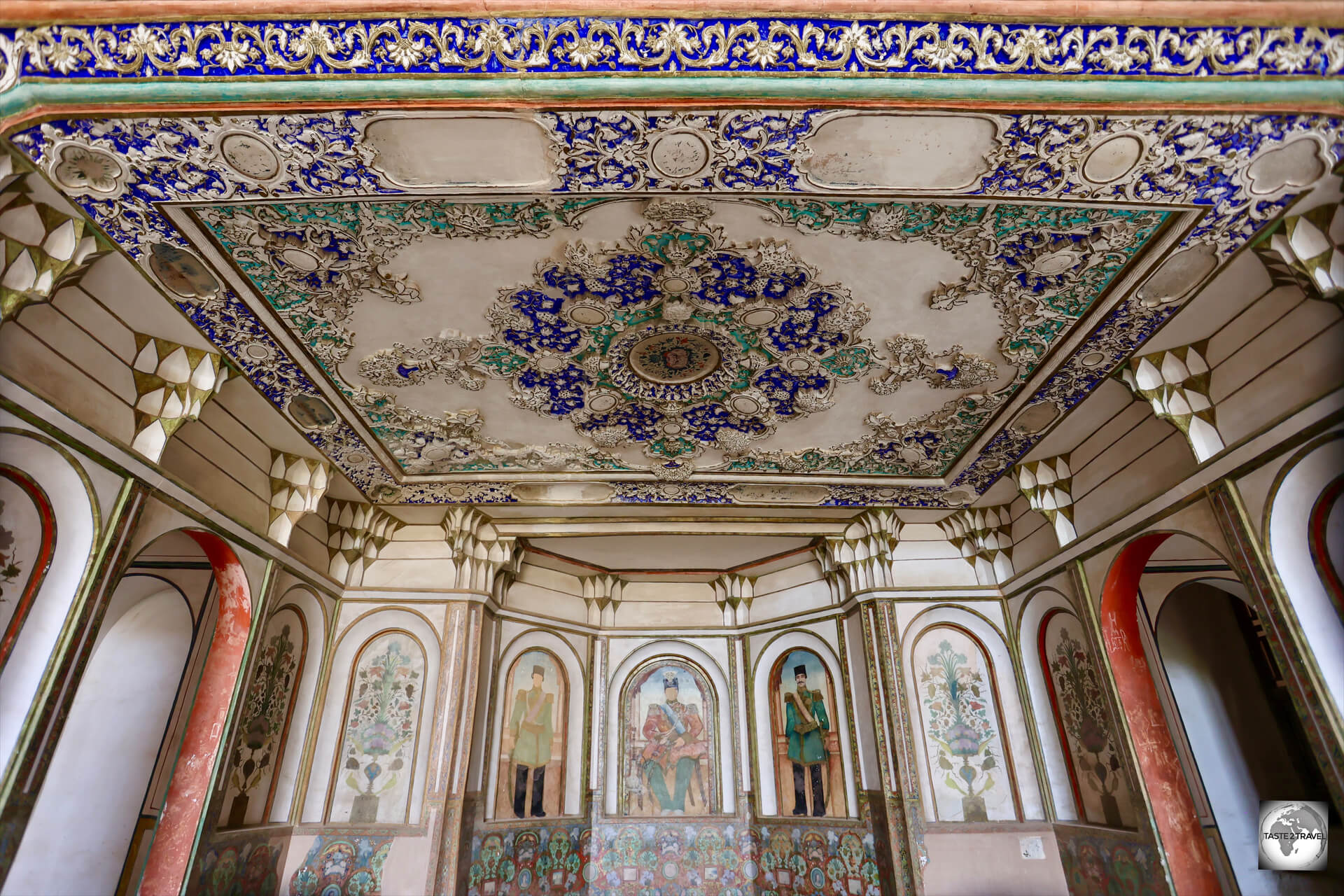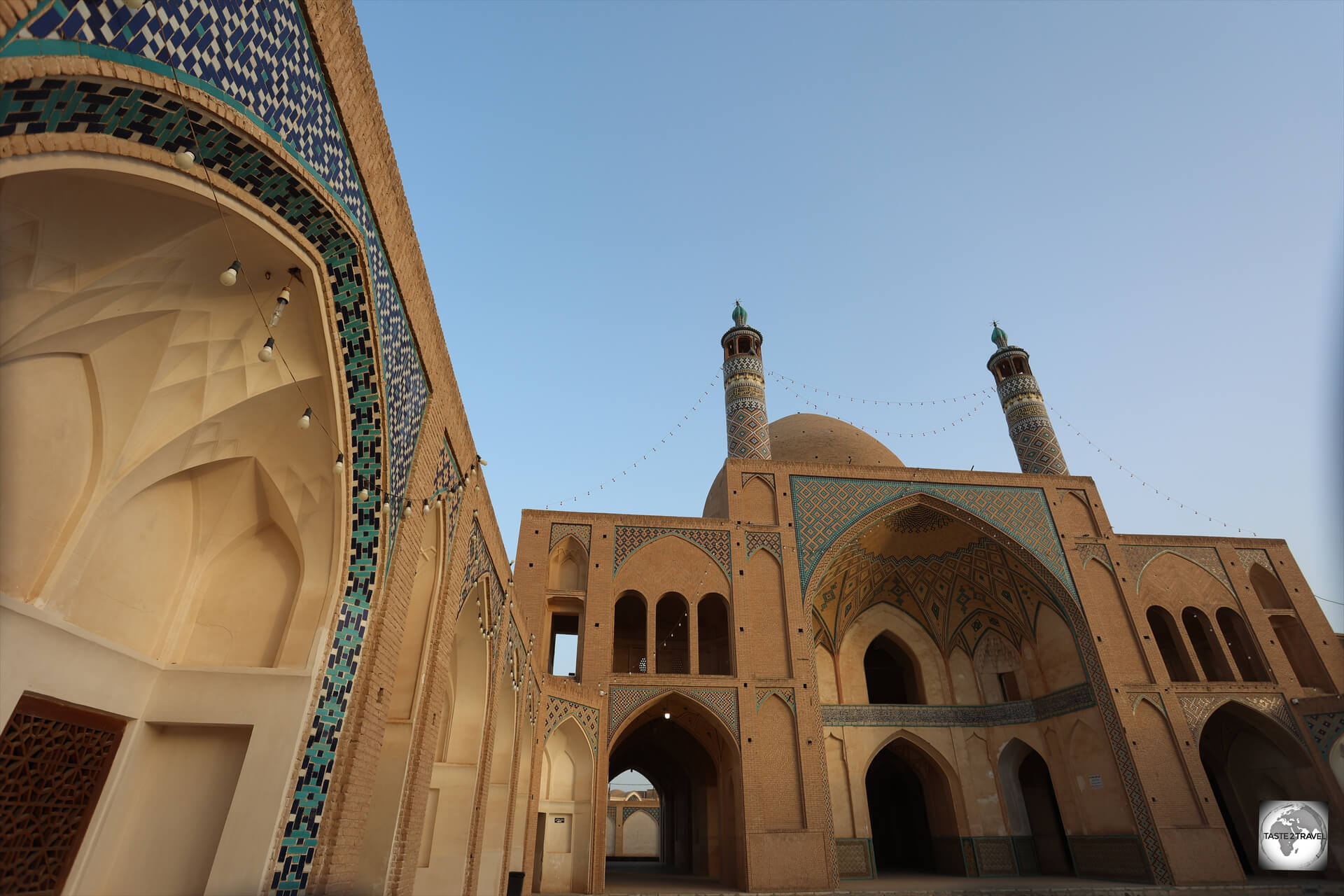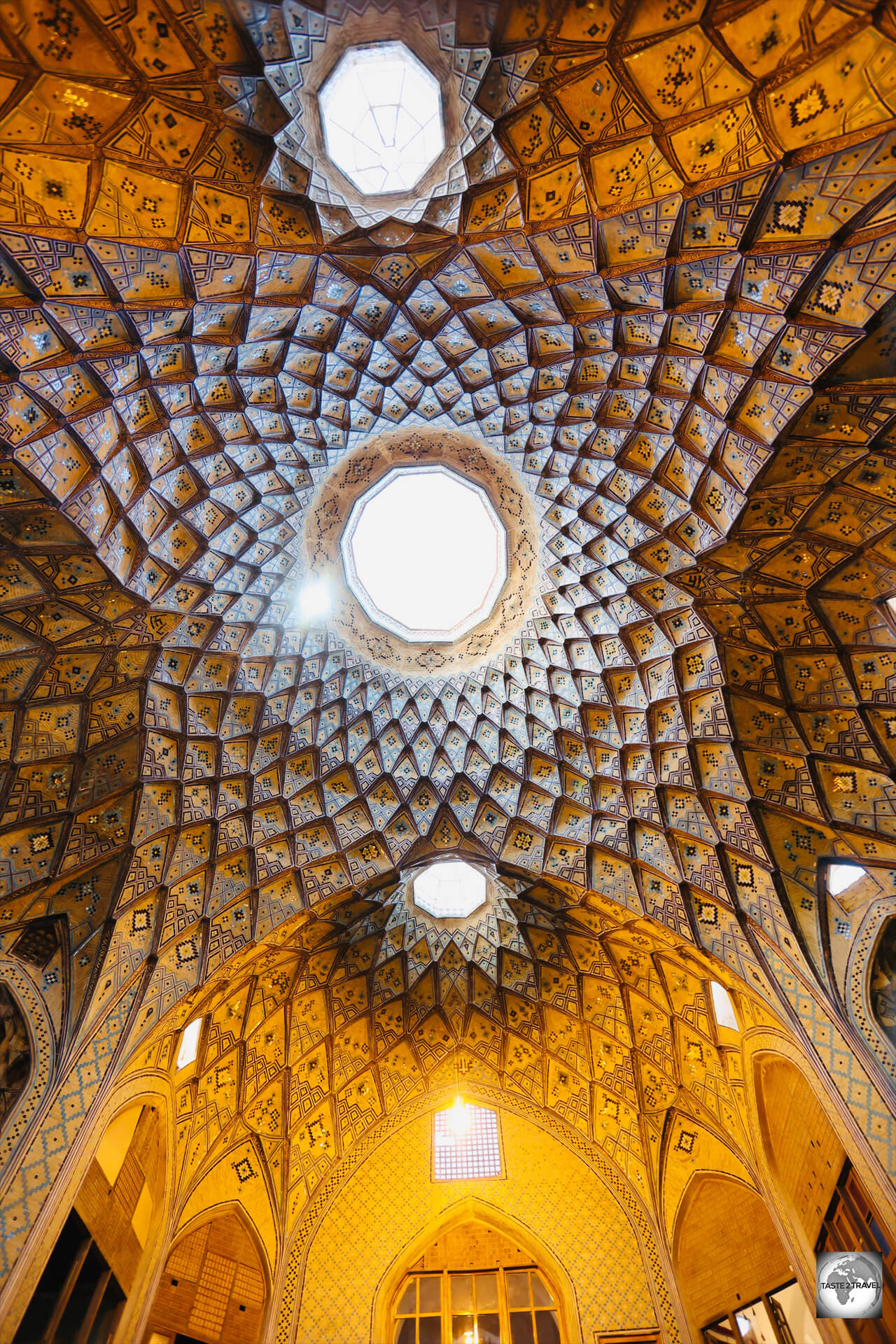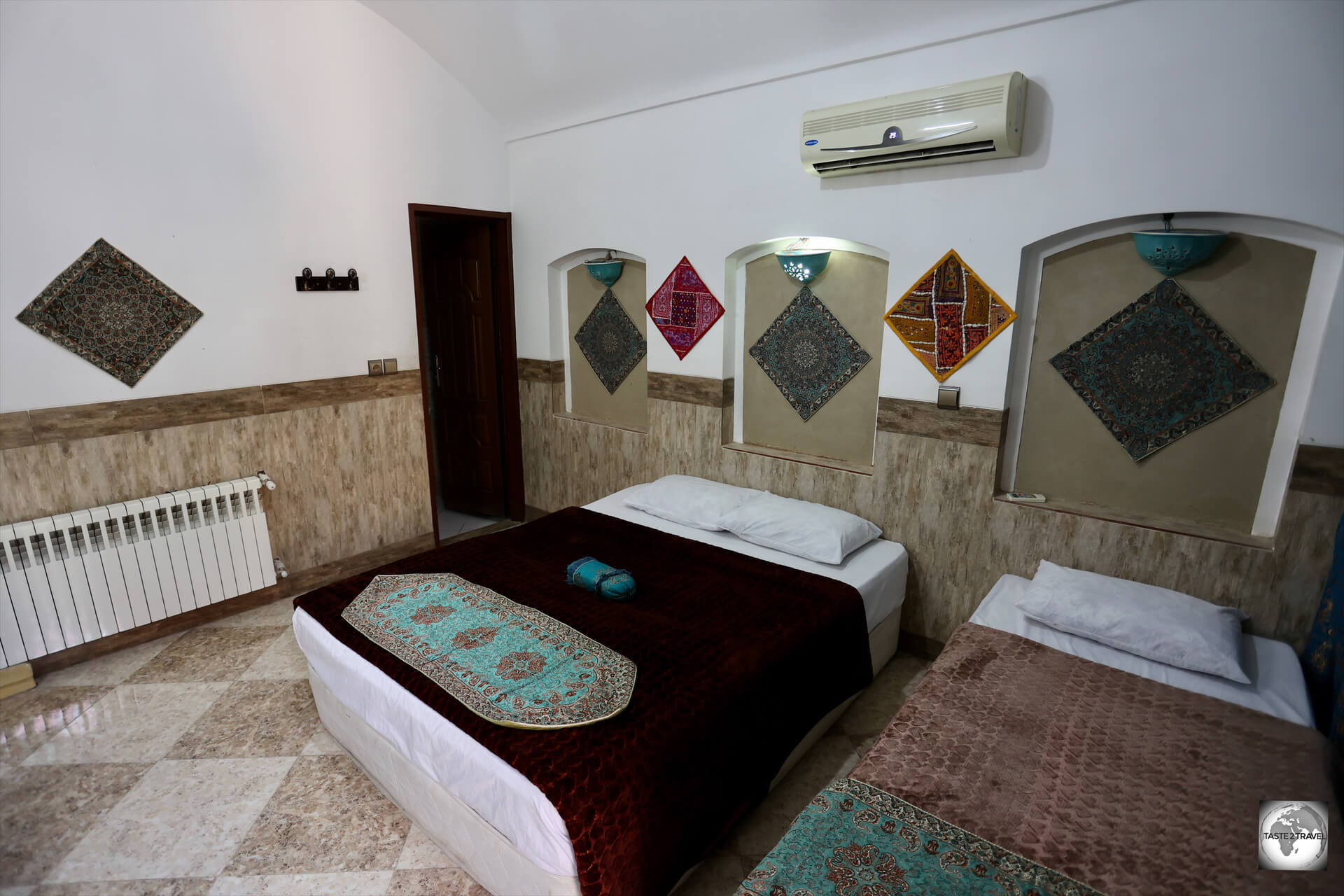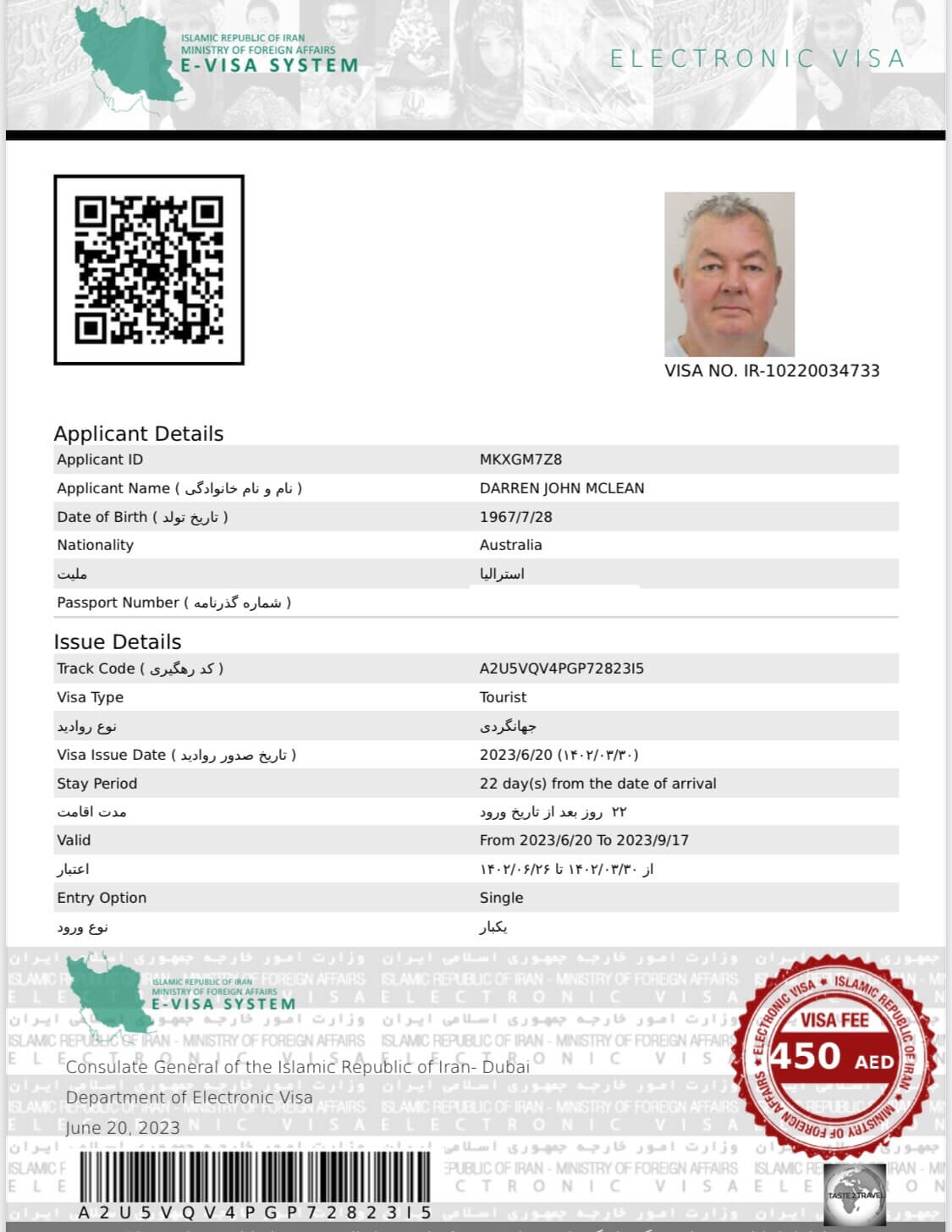Iran Travel Guide
This is an Iran Travel Guide from taste2travel.com
Date Visited: May 2023
Introduction
Welcome to my Iran Travel Guide!
I recently travelled to Iran for 3-weeks, traversing what is known as the ‘Classic Route‘, travelling from Shiraz, north to Tehran, stropping at Yazd, Esfahan (Isfahan), Kashan and Tehran.

A view of the spectacular dome at the Sheikh Lotfollah Mosque in Esfahan, one of many outstanding sights in Iran.
During my time in the country, I travelled with an amazing freelance Iranian guide, Esmaeil Shahsavar (aka Essi), who made my trip so much more memorable than if I had travelled by myself!
Essi is a proud Iranian who is passionate about Iran’s history, culture and society. Through him, I was introduced to many remarkable people and places, which allowed me to gain insights into Iran that wouldn’t be available to me as a regular tourist.
I highly recommend engaging the services of a local guide who is passionate and knowledgeable. I have included contact details for Essi in the ‘Tour Guide‘ section below.
Did you know? Iran is home to 27 UNESCO World Heritage Sites, making it one of the top 10 countries in terms of UNESCO sites.
In so many ways, Iran has been a cradle of civilisation for humanity. Iran is known for its ancient civilisations, stunning architecture and its influence on the greater region and beyond.
During my 3-weeks in Iran, I took 1,500 photos. In most other countries, I would take 200-300 photos in the same period of time.
Iran is one of the most surprising, authentic travel destinations anywhere on planet Earth.
Iran is unlike most countries – a fascinating travel destination which offers an overwhelming amount of sightseeing, including no less than 27 UNESCO World Heritage Sites.
As for the people, the hospitality of Iranians is legendary and I was always made to feel very welcome.
There is a vast difference between everyday Iranians and the Iranian government, whose, normally provocative, actions make the daily news cycle for all the wrong reasons.
Iranians are generally an intelligent, educated, open-minded lot who are keen to engage with the outside world.
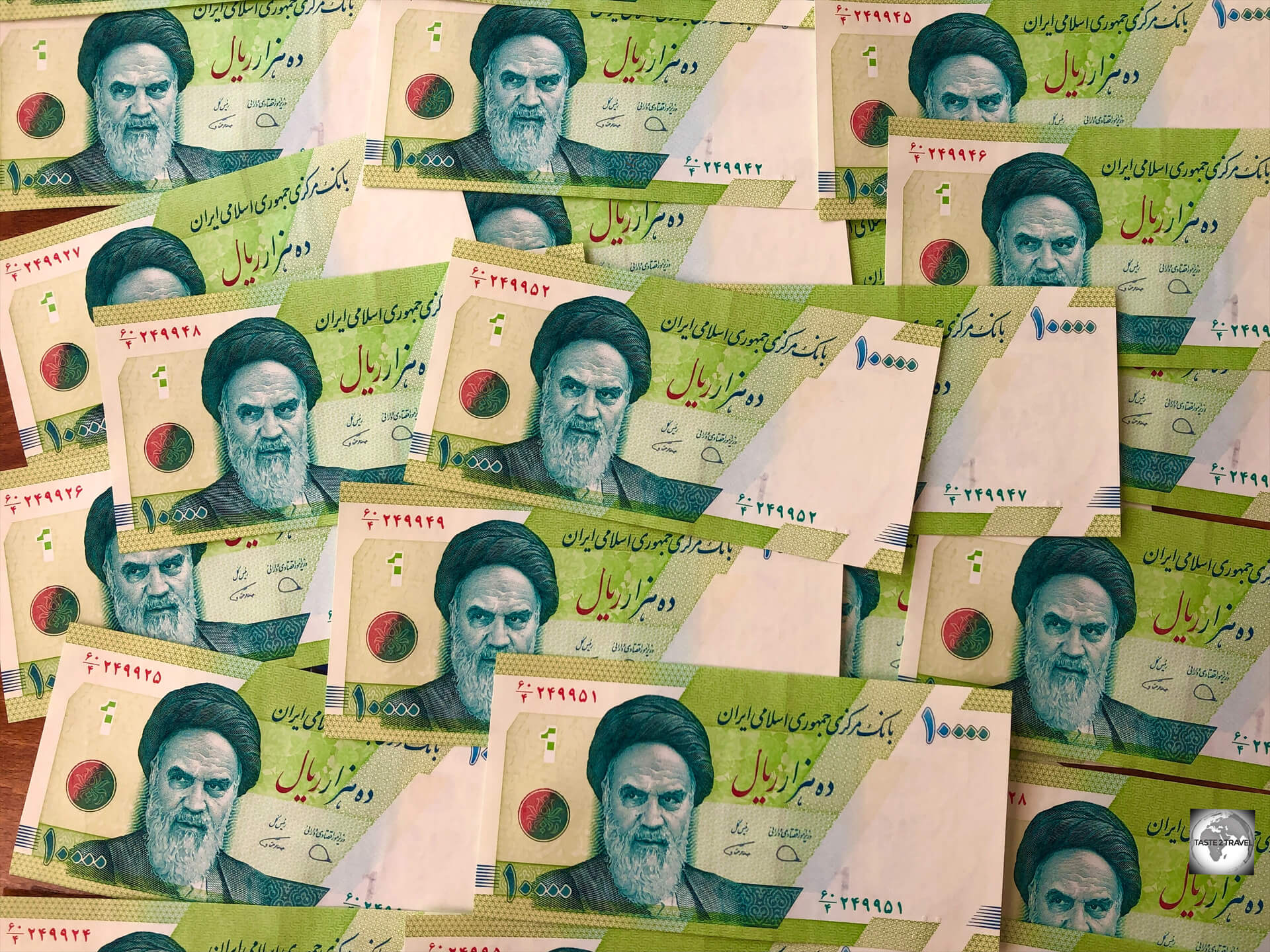
Iran rial banknotes, featuring the image of Ayatollah Khomeini, the first supreme leader of Iran.
Despite the internet being blocked by the government, most Iranians access the internet using VPN’s. Despite efforts by the government, Iranians tend to be fully informed!
Due to international sanctions, there are many restrictions imposed on Iran.
Credit cards cannot be used inside Iran, which also means that cash cannot be withdrawn from ATMs. I cover all of these monetary restrictions, and solutions, in the ‘Currency‘ section below.
Additionally, applying for a tourist visa isn’t so straight-forward and is best done using an Iranian-registered travel company. The visa application process is fully explained in the ‘Visa Requirement‘ section below.
If you have thought about visiting Iran, I would urge you to go.
I had an amazing time in the country and look forward to returning one day to continue my road-trip through this fascinating, ancient, and modern, land.
Location
Iran is located in the heart of western Asia, at a crossroads with the Middle East. Iran’s strategic location has made it an historically important crossroads for trade and cultural exchange between the East and the West.
Iran shares land borders to the north with Turkmenistan, Armenia, Azerbaijan, and the exclave of Nakhchivan (an autonomous region of
Azerbaijan).
To the northeast, Iran is bordered by Afghanistan, while to the east, it shares a long border with Pakistan. To the west, it borders Iraq.
To the southwest, Iran has a long coastline along the Persian Gulf and the Gulf of Oman. On the other side of the Persian Gulf, the same body of water is referred to as the Arabian Gulf – much to the annoyance of Iranians.
In terms of topography, Iran is very diverse, with vast mountain ranges, deserts, plateaus, and fertile valleys.
The Zagros Mountains run along its western border, while the Alborz Mountains are located in the north. Central Iran is dominated by the Iranian Plateau, which includes the Dasht-e Kavir (Great Salt Desert) and the Dasht-e Lut (Lut Desert).
The country also features several fertile plains and valleys, including the Caspian Sea (the world’s largest landlocked body of water) to the north.
People
The people of Iran, known as Iranians, are a diverse and culturally rich population with a long history dating back thousands of years.
Iran is a multi-ethnic country, and Iranians are comprised of various ethnic groups. The majority are Persian, making up about 61% of the population.
Other significant ethnic groups include Azeris, Kurds, Arabs, Lurs, Baloch, and Turkmen, among others. This ethnic diversity contributes to the cultural richness of the nation.
The official language of Iran is Persian (Farsi), and it serves as the lingua franca across the country. However, many Iranians are bilingual or multilingual, with minority ethnic groups often speaking their own languages or dialects.
Why Two Door Knockers?
Formerly, in more conservative times, traditional wooden doors in Iran featured two knockers.
The knocker on the left was used by female visitors, while the one on the right was used by male visitors.
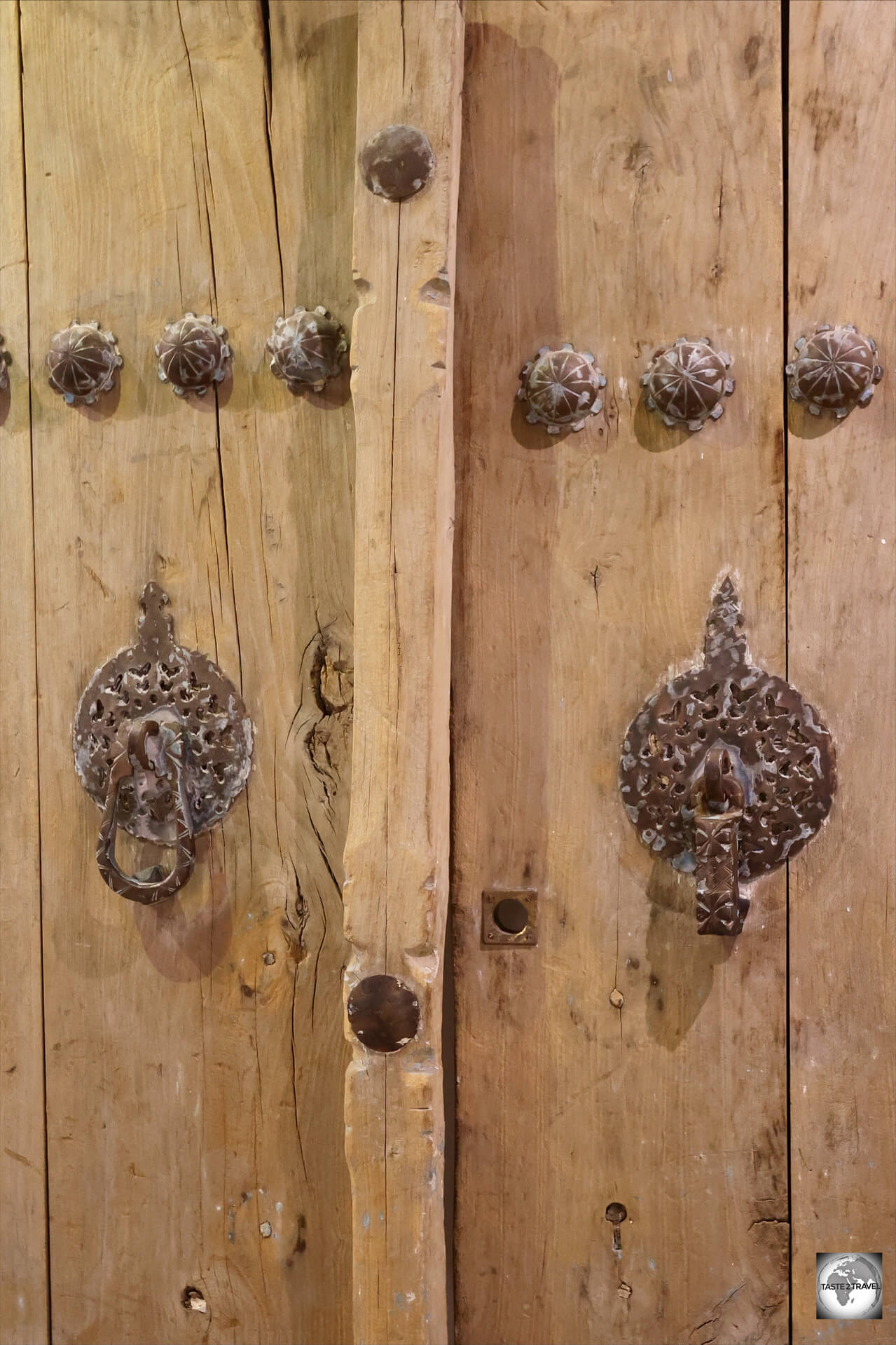
Always, the door knocker on the left is to be used by female visitors, while the one on the right is to be used by male visitors, with each producing a different sound.
This allowed householders to know the gender of the visitor before they opened the door.
This was important since it wasn’t acceptable for a male to open a door to a female visitor and vice-versa.
The predominant religion in Iran is Shia Islam. The country is home to some of the most important Shia religious sites, and religious practices play a significant role in the daily lives of many Iranians. However, there are also religious minorities in Iran, including Sunni Muslims, Christians, Jews and Zoroastrians.
Iranians have a rich cultural heritage that includes contributions to literature, poetry, art, music, and philosophy. Persian poetry, with luminaries like Rumi and Hafez, holds a special place in world literature.
Traditional Persian music, characterised by instruments like the tar and setar, is renowned for its beauty and complexity.
Iranians are known for their warm hospitality. Guests are highly esteemed in Iranian culture, and it is common for hosts to go to great lengths to make visitors feel welcome.
Iran has a strong emphasis on education, and literacy rates are relatively high. Both men and women have access to education, and women’s participation in higher education has been steadily increasing over the years.
The dress code in Iran varies, but modesty is a key consideration. Traditional clothing such as the chador, hijab, and manteau are common for women, while men typically wear long-sleeved shirts and trousers.
However, younger Iranian women are challenging the established norms, with many choosing not to wear hijab. This is a direct challenge to the conservative Islamic leaders who run the country and continues to cause friction and problems.
Flag

The flag of Iran, as souvenir fridge magnets.
The flag of Iran, also known as the Iranian Tricolor consists of three horizontal stripes of equal width, arranged from top to bottom in the following colors:
1. Green Stripe: The top stripe is green, which holds significant historical and cultural symbolism. Green has long been associated with Islam, representing growth, hope, and happiness. It is also a colour that reflects the natural landscapes of Iran, including its lush gardens and forests.
2. White Stripe: The middle stripe is white, which symbolises peace and purity. White is often seen as a color of harmony and tranquility, reflecting the desire for a peaceful coexistence among Iran’s people and with the rest of the world.
3. Red Stripe: The bottom stripe is red, a color that represents valour, bravery, and the bloodshed of those who sacrificed for Iran’s independence and freedom. It also symbolises the country’s long history of struggle against invaders and oppressors.

The flag of Iran, flying at Pasargadae.
In the centre of the white stripe, near the hoist side, there is a stylised emblem known as the “Allah-o-Akbar” emblem. This emblem features a stylised calligraphic design of the phrase “Allah-o-Akbar,” which means “God is the Greatest” in Arabic script.
The calligraphy is done in a way that it forms a stylised version of the word “Allah” (God) within the emblem.
Currency

The Iranian rial, aka toman, is the official currency of Iran.
The currency situation in Iran is especially confusing for the first-time visitor.
While the official currency is the Iranian rial (international currency code: IRR), all prices are expressed in toman. The toman is an ancient currency which has existed since 1798.
In 1932, the rial was introduced, with one toman being equal to 10 rial. Although, today, the rial is the official currency, all prices are expressed in toman.
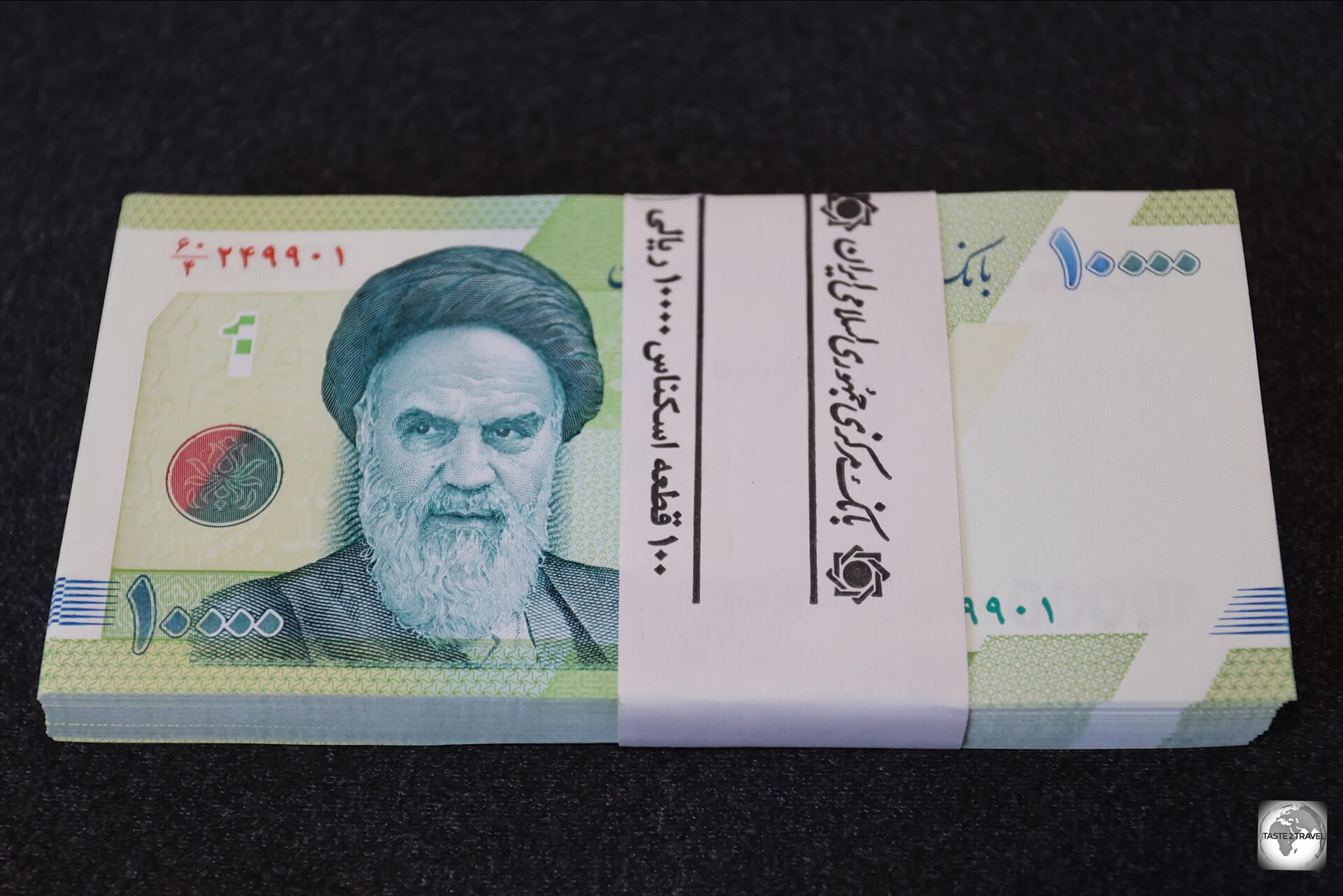
My uncirculated wad of one hundred, 10,000 Iranian rial, banknotes which I purchased from a money changer.
Iranians transact in toman, not rial, although they use rial banknotes.
What makes things confusing is that all bank notes are issued in rial, but they are used as toman. To further complicate matters, three extra zeros are omitted from the rial when converting to toman.
This means, if you purchase something which is worth 2,000,000 rial – you will pay 200,000 toman which is expressed simply as ‘200’. Very confusing for visitors.

Currently, four different versions of the 1,000,000 Iranian rial bank note are in circulation, although each is expressed as ‘100’ toman.
If that’s not confusing enough, different series of Iranian rial banknotes are in circulation at the same time. For example, there are currently four different versions of the 1,000,000 rial bank note in circulation (ss shown above).
As can be seen in the image above, the latest versions of the bank notes (right side) have the last 4 zeros of the rial amount shaded out so that the value is expressed as toman. Additionally, the toman amount of ‘100’ is clearly displayed on the notes.
As an example of an everyday transaction, if you pay for a coffee in a café, you’ll be charged 150 toman which is 1,500,000 rials.
Exchange Rate

Bank notes in Iran feature the image of Ayatollah Khomeini, the first supreme leader of Iran from 1979 until his death in 1989.
The exchange rate of the Iranian rial has experienced significant fluctuations due to economic factors and sanctions.
Currently (October 2023), USD $1 = IRR 42,250.
You can check the current exchange rate here.
Credit Cards
Due to sanctions, Iran is not part of the international bank system and as such, international credit cards cannot be used in Iran.
This also means that foreigners are unable to withdraw cash from ATMs in Iran. You will need to arrive in the country with enough USD cash (or Euro) for your entire stay.
Iranian banks do issue domestic cards to their customers, which allow Iranians to pay for purchases electronically and withdraw cash from ATM’s.
Iranians are big on electronic payments, preferring to pay for almost everything using a card, rather than carrying loads of cash.
Credit cards also cannot be used to pay for hotels in Iran and, due to sanctions, the regular online booking sites (booking.com etc.) do not list Iranian hotels.
One Iranian online accommodation provider, 1st Quest, allows you to pre-book, and pre-pay, for accommodation using your international credit card. Transactions on this site are conducted outside of Iran.
You should book all accommodation prior to arriving in Iran. Please refer to the ‘Accommodation‘ section below for more on 1st Quest.
Prepaid Tourist Card
One card option available for visitor’s is Mah Card, an Iranian debit card which can be pre-loaded with funds which saves you from carrying around piles of cash.
Due to the processing time involved in issuing the card (up to 7 days), it’s essential that you apply for this in advance of your trip.
Upon arrival in Iran, the card will be waiting for you at your nominated accommodation.
Accessing Your Home Bank
It should be noted that due to sanctions, your bank at home might be inaccessible in Iran. When I tried to login to my bank in Australia, I received a message to say that the service was unavailable in Iran due to sanctions regulations.
Costs
Travel costs in Iran are totally reasonable! As a destination, Iran offers excellent value for money.
One of the biggest bargains in Iran is petrol, which currently costs US$0.06 per litre! Some of the cheapest fuel in the world!
Travel Budgets (daily):
- Budget: US$25
- Mid-range: US$60
- Top-end: US$150
Sample costs in Iran:
- Meal for one in a budget restaurant: US$3.50
- Meal for two in a mid-range restaurant: US$23.00
- Cappuccino: US$1.25
- Coke/Pepsi (0.33L bottle): US$0.77
- Mineral Water (.5L): US$0.70
- Car with guide (per day): US$130-150
- Petrol (1L): US$0.06
- A room at a budget hostel (Yazd Friendly Hotel): US$16
- A room at a mid-range hotel (Keryas Traditional Hotel in Esfahan): US$43
- A room at a top-end hotel (Ferdowsi International Grand Hotel in Tehran): US$80
Iranian Travel Companies

Tap Persia
It goes without saying – Iran is not your usual travel destination!
Due to sanctions, and the ongoing (difficult) political environment, there are many considerations which must be made when planning a trip to Iran.
If you apply for a visa independently, there is a good chance your application will be denied.
You need to apply for a visa through an Iranian-registered travel company. For a full description of the Visa Application process, please refer to the ‘Visa Requirements‘ section below.
Because of sanctions, most international travel insurance policies do not provide coverage in Iran – you will need to purchase an Iranian travel insurance policy.
Also – credit cards cannot be used anywhere inside Iran. You cannot withdraw cash from ATMs anywhere in Iran.
However, you can apply, in advance, for an Iran Tourist Card which is an Iranian debit card which you can pre-load online and will allow you to make electronic payments throughout Iran.
All of these services are offered by the amazingly helpful folks at Tap Persia.
Tap Persia is a one-stop shop for all your Iran travel needs!
If you are planning a trip to Iran, you would be wise to first contact Tap Persia.
From their website, you can organise everything online. Their most important service is the Visa Application service.
Their service is friendly and efficient! They are the gateway to Iran for so many travellers!
1st Quest
Also because of sanctions, hotels in Iran cannot be booked using the regular online booking websites.
You can pre-book hotels online, and pay with your credit card, using 1st Quest which is Iran’s version of booking.com.
Iranian Tour Guide

“Essi is your man in Iran!”
Normally, I travel independently!
However, prior to arriving in Iran, I was introduced to a Shiraz-based tour guide, Esmaeil Shahsavar (aka Essi), through some friends who had travelled previously with him and highly recommended the experience!
Essi is a qualified tour guide who speaks perfect English. He is a proud Iranian who loves his country, its culture, history and its people!
He works both as a freelance tour guide and for established tour companies and has an expansive knowledge of the entire country. Wherever we went, he knew of hidden sights which he loved to share with me.
Video:
Video of Persepolis taken by Essi!
Essi is also a keen videographer and was always making videos of our adventures. He shares many of his videos on his Instagram account.
I contacted Essi and organised to use his services in Shiraz and onto Yazd. Beyond Yazd, I planned to travel independently to Tehran.
However, it became clear on the first day that Essi is more than just a tour guide. He has a genuine love for Iran, and is eager to share its history, culture, sights, cuisine and so much more with visitors.
Even as we drove between sights, in his clean and comfortable white Peugeot, he would play the most beautiful Iranian music and provide translation of the lyrics!
In the end, I realised my travel experience in Iran would be greatly enhanced by having Essi as my full-time guide. I agreed to travel with Essi for the 21-days I was in Iran!
During this time, I travelled what is known as the ‘Classic Route‘, starting in Shiraz, then moving on to Yazd, Esfahan, Kashan then Tehran.
In each city, I scheduled a 4-night stay which allowed time to explore the sights in and outside of each city.
At every step of the trip, Essi would surprise me by revealing dazzling sights in the most remote and unlikely locations. With him, I visited places I could never have reached with regular public transport.
In every city, Essi knew people, and introduced me to his many friends which further enhanced my travel experience.
Travelling in Iran with Essi was a no-brainer – it was a win/win situation.
The 21-days I spent travelling the Classic Route with Essi was the ultimate Iran Road Trip.
If you are planning a trip to Iran and would like to travel with a freelance guide, who will enthusiastically share his knowledge and passion for his amazing country, then Essi is your man in Iran!
Contact Details for Essi:
- Name: Esmaeil Shahsavar (Essi)
- Email: e.shahsavar90@gmail.com
- Instagram: Safarbon
- WhatsApp / Telegram Number: +98 917 610 4712
Sightseeing
Sightseeing in Iran offers a captivating journey through a land rich in history, culture, and natural beauty. Iran boasts a wide range of attractions, from ancient historical sites to stunning landscapes.
The sightseeing section follows the direction of my travel, starting in Shiraz and ending in Tehran.
Shiraz
Shiraz is known as the city of poets, literature, and gardens. One of the principal cities in Iran, Shiraz is an historic and culturally rich city located in the southern part of the country.
The city has a long and illustrious history dating back over 4,000 years. It was the capital of the Persian Empire during the Zand Dynasty in the 18th century and played a significant role in Persian culture and politics.
Shiraz is often referred to as the “City of Poets,” the “City of Gardens,” and the “City of Love” due to its association with Persian literature, lush gardens, and romantic ambiance.
Shiraz is renowned for its deep connection to Persian poetry and literature. It is the birthplace of some of Iran’s most celebrated poets, including Hafez and Saadi.
The city is known for its stunning Islamic architecture. Some of the most impressive landmarks include the Nasir al-Mulk Mosque (also known as the “Pink Mosque”) with its colorful stained-glass windows, and the Shah Cheragh Shrine, known for its dazzling mirror work and intricate tile designs.
Shiraz offers a unique blend of history, culture, and natural beauty that makes it a captivating destination for anyone interested in exploring Iran’s rich heritage. It is a city where poetry comes to life, and visitors can immerse themselves in the timeless beauty of Persian culture.
Shiraz offers many days of sightseeing both inside the city and outside, where the spectacularly pink Maharloo Lake is a truly surreal sight.
The city is the best base from which to make daytrips to the UNESCO World Heritage sites of Persepolis, Naqsh-e Rostam and Pasargadae.
Some of the sights of Shiraz include:
Nasir al-Mulk Mosque

Built during the Qajar dynasty, construction of the Nasir al-Mulk Mosque began in 1876 by the order of Mirza Hassan Ali Nasir-ol-Mulk, one of the lords of Shiraz.
Built during the Qajar dynasty, construction of the Nasir al-Mulk Mosque began in 1876 by the order of Mirza Hassan Ali Nasir-ol-Mulk, one of the lords and aristocrats of Shiraz and was completed in 1888.

The pink colour which covers the walls of the Pink Mosque was created by craftsmen who used an expensive glaze, which included gold.
The mosque is known for its many coloured glass Orsi windows and its fully tiled walls which feature a distinct pink colour.

One of the magnificent Muqarnas, a form of decorative vaulting, which is popular in Iranian-Islamic architecture, at the Nasir al-Mulk Mosque.
Craftsmen used a very expensive glaze that contained gold to colour the tiles with pink. It is said that 20 kilograms of gold was used for this process. It is for this reason that the mosque is nicknamed the “Pink Mosque”.
One of the standout architectural features at the Pink Mosque are the Muqarnas, a form of decorative vaulting, which is popular in Iranian-Islamic architecture.

A view of a Muqarna, surrounded by a sea of pretty pink tiles, at the Nasir al-Mulk Mosque in Shiraz.
In muqarnas, the surface of a vault or dome is subdivided into niche-like cells that have no load-bearing function.
Also known as stalactite vaulting or honeycomb vaulting, the example at the Pink Mosque is truly stunning.
Nasir al-Mulk Mosque is famous for its seven Orsi windows, which are made of a mixture of wood and colourful glass.
Although stained glass is mostly popular in churches nowadays, the earliest discovered was in Syria from the 7th century CE.
There is evidence of techniques and recipes for obtaining stained glass by the Persian chemist Jabir ibn Hayyan who published his techniques as early as the 8th century CE.
Photography Tips:
- The best time to photograph the Orsi windows at the Nasir al-Mulk Mosque is in the early morning – before 8am.
- The best season for photography is in winter, when the sun is low in the sky. This low angle of sunlight fills the mosque with lots of colourful light. I visited during the summer when the sun is higher in the sky and the colourful light shadows are shorter.
Orsi differs from stained glass used in many churches and Ottoman mosques which serve as illuminated images rather than a source of light.
Orsi windows are characterised for using pieces of colour glass, which are cut into different geometric shapes. Such shapes were used due to the prohibition of images and icons in Islamic art.
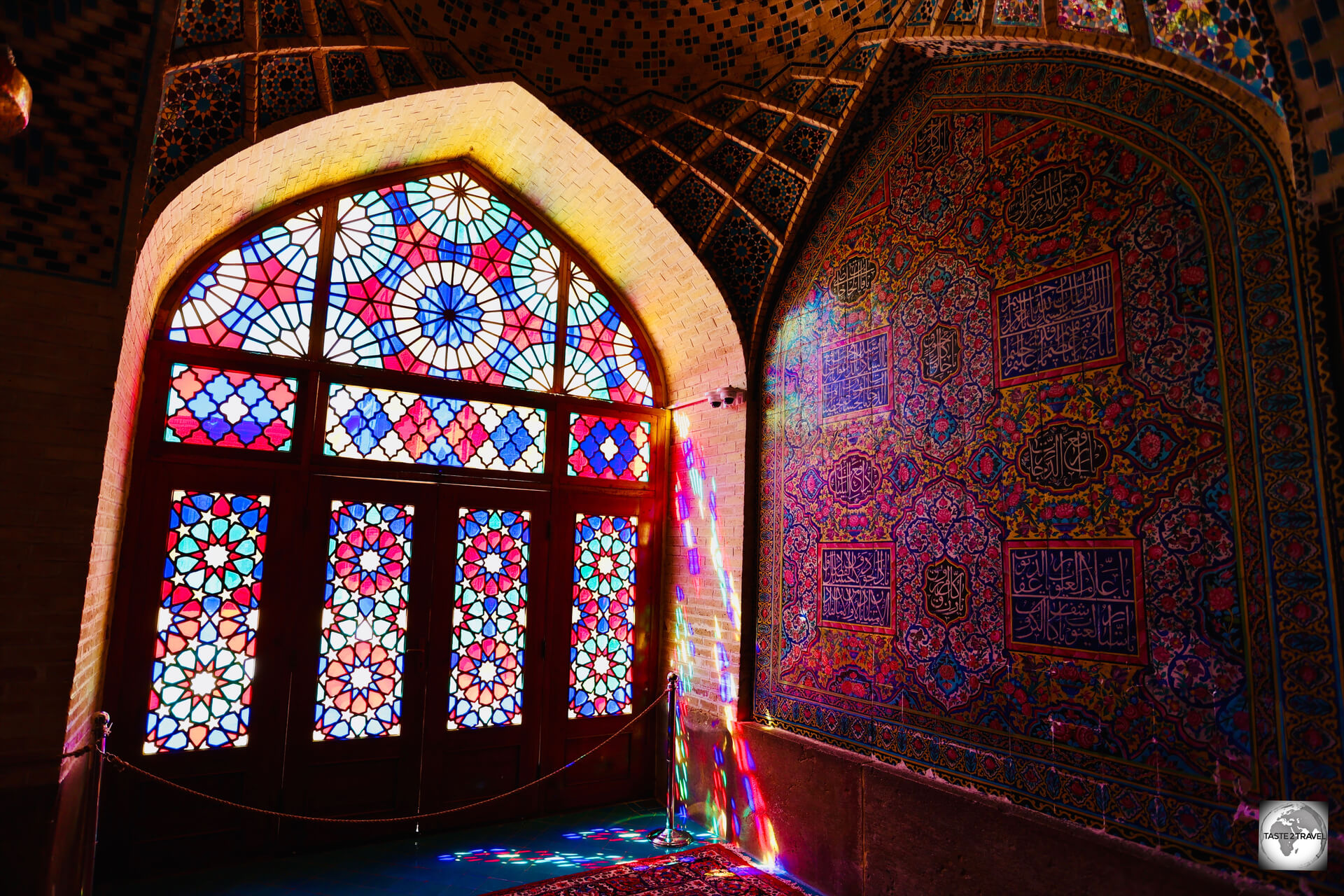
Orsi windows are characterised for using geometric shapes in their designs due to the prohibition of images and icons in Islamic art.
The main purpose of Orsi is creating colourful light on the interior of the building.
Nasir al-Mulk Mosque has seven wooden doors with colourful Orsi connecting the interior mosque to the courtyard.
Shahcheragh Shrine

A view of the Shahcheragh Shrine, the holiest shrine in the city of Shiraz, during the magical ‘golden hour’.
The Shahcheragh Shrine is the holiest shrine in the city of Shiraz and the 3rd holiest shrine in Iran.
The shrine houses the tomb of Ahmed bin Musa, the son of Musa al-Kadhim, who is known as Shah Cheragh (King of the Light) in local traditions.
The first structure over the grave of Ahmed bin Musa was built in the 13th century CE.
Like other Shia holy shrines, the interior of the shrine is decorated with a profusion of individually laid mirrors.
The mausoleum of Sayyid Ahmad is topped by a large dome which is covered in individually laid mirrors.
Visiting Tips:
- Large cameras are not allowed inside the shrine – only smartphone cameras are permitted.
- All tourists must be fully escorted by a friendly mosque guardian.
Ali Ibn Hamzeh Shrine

The Ali Ibn Hamzeh Shrine was constructed in the 10th century CE to honour a noble descendant of the prophet of Islam.
Welcome to the most tourist-friendly Islamic sight in Shiraz!
Built in Shiraz in the 10th century to honour a noble descendant of the prophet of Islam, the Ali Ibn Hamzeh Shrine is now a popular praying retreat for Muslims.
Its peaceful ambiance, soothing architecture, and welcoming attitude of its caretakers toward any kind of visitors have made this shrine an attractive destination in Shiraz.
I was made to feel welcome in the visitor’s centre, where I was offered cups of tea and biscuits.
The shrine was constructed in the 10th century CE, to honour Ali Ibn Hamzeh, who was a descendant of the prophet of Islam and is a sacred figure for Shiites.
Ali Ibn Hamzeh was prosecuted by the caliph and fled to Shiraz in 805, but after staying hidden for some time, he was finally found and killed.
In around 950, the local ruler of Shiraz built a shrine which was later developed further.
Like other Shia Holy Shrines, the interior of this shrine offers a dazzling profusion of mirror work with each thumbnail-sized fragment being installed individually.
A truly stunning sight in a country which is full of breathtakingly beautiful wonders.
Qavam House
Located in the heart of the Iranian city of Shiraz, Qavam House – also known as Narenjestan garden, is a traditional and historical house and garden.
Built between 1879 and 1886, the building preserves the elegance and refinement enjoyed by upper-class Persian families during the 19th century.
Qavam House was built during the Qajar period in the late 19th century. At that time, the Qavam family was among the political figures of Shiraz, and Qavam House served as the residential place of the Qavam family and the office for their administration.
Since the garden has an abundance of sour orange trees, people call it Narenjestan. Interestingly, the Spanish world for ‘orange’ is naranja.
The garden at Qavam House features date palms, and a large number of sour orange trees.
Persian gardens generally have a rectangular form consisting of four quarters abundant in trees and flowers, streams and pathways, ponds and fountains.

A symbol of wealth – the stunning mirrored porch at Qavam House was built during an age when only the wealthy could afford to buy mirrors.
A highlight of the house is the spectacular mirrored porch.
In the 19th century, mirrors were an expensive item to purchase, with most mirrors imported from Russia. The use of mirrors was a way for a family to indicate its wealth.
Two smaller porches feature very fine plaster stucco work.
Qavam House has elaborate architecture embellished with various Persian arts such as paintings, stucco, wood carving, stone carving, tile work, and mirror work.
In the basement of the house are some truly talented artists. One artist paints miniature images on bird feathers using a tiny brush made from cat’s fur.

This scene has been painted onto a feather, by an artist at Qavam House, using a tiny brush made from cat’s fur.
Eram Garden
Relaxing and expansive, Eram Garden is yet another UNESCO World Heritage Site and one of the most famous Persian gardens in Shiraz.
It features meticulously landscaped gardens, fountains, and historic buildings, making it a peaceful oasis within the city.
Arg of Karim Khan

Located in the centre of Shiraz, the Karim Khan Citadel was built as part of a complex during the Zand dynasty.
The Arg of Karim Khan or Karim Khan Citadel, is a citadel located in downtown Shiraz, Iran. It was built as part of a complex during the Zand dynasty (1751 to 1794).
It is named after Karim Khan Zand, and served as his living quarters. It is rectangular in shape and resembles a medieval fortress.
The dynasty, which ruled most of ancient Iran, began as a Safavid restoration but soon became an independent effort to restore peace and prosperity.
It rebuilt and rerouted trade through Iran, issued coins in the name of the Hidden Imam, and built a mosque in Shiraz, but never sought clerical endorsement of power.
Karim Khan Zand holds an enduring reputation as the most humane Iranian ruler of the Islamic era. His descendants were overthrown by the Qajars.
In the past, the citadel was sometimes used as a prison. Today, it is a museum operated by Iran’s Cultural Heritage Organization. A public park surrounds it.
Vakil Bazaar
In between all the sightseeing, the charming and historic Vakil Bazaar offers excellent shopping, especially for Persian rugs and Iranian handicrafts.
A typical Iranian bazaar, centered around an ancient “caravanserai” which was an accommodation place built for merchants travelling by camels in the past.
The bazaar features a number of leafy squares with fountains in the centre, surrounded by two-storey guest houses which are now occupied by various artisanal shops.
A great place for shopping when in Shiraz.
Vakil Mosque
The Vakil Mosque is a mosque in downtown Shiraz, situated to the west of the Vakil Bazaar next to its entrance.
This mosque was built between 1751 and 1773, during the Zand period; however, it was restored in the 19th century during the Qajar period.
Vakil means regent, which was the title used by Karim Khan, the founder of Zand Dynasty. Shiraz was the seat of Karim Khan’s government and he endowed many buildings, including this mosque.
Maharloo Lake
Located 27 kilometres southeast of Shiraz, the very pink, Maharloo Lake, is a stunning natural attraction.
If arriving into Shiraz by air, there is a good chance you’ll fly over the lake on final approach to Shiraz International Airport. Worth sitting on a window for what is a truly dazzling sight.
The aerial views included here were taken in the morning from my flight from Dubai to Shiraz.
This unique and picturesque lake is known for its striking pink hue, which results from a combination of factors, making it a popular destination for tourists and nature enthusiasts.
The intensely striking pink colour is the result of the high salinity and the presence of microorganisms, particularly algae and bacteria. These microorganisms thrive in the salty waters and produce a red pigment, giving the lake its characteristic pink and reddish tones.

The very pink, Maharloo Lake, seen from my window seat on my Flydubai flight, on approach to Shiraz International Airport.
The intensity of the pink colour can vary depending on the time of day, weather conditions, and the season. At the time of my visit, the lake was at its most ‘pink’.
Maharloo Lake is a saltwater lake, and its water has a high salinity content. The salt concentration in the lake is the primary reason behind the absence of aquatic life in its waters. The lake’s salt flats and crystalline formations along the shoreline add to its unique natural beauty.
The lake is set against a backdrop of arid desert landscapes and distant mountains, creating a stunning contrast with its vibrant pink waters.
The reflection of the surrounding mountains and the changing colors of the lake’s surface make it a popular spot for photographers and nature enthusiasts. Best photography is in the late afternoon.
A highlight of Shiraz, Maharloo Lake is a magical place where the interplay of salt, microorganisms, and changing environmental conditions creates a remarkable and visually stunning sight.
Getting There:
Located on the outskirts Shiraz, in a remote, desert setting, you will need private transport to access the lake.
I recommend travelling with Essi (Instagram: Safarbon), a native of Shiraz, and someone who knows the best photo vantage points on the lake.
Persepolis

Founded by Darius I in 518 BCE, Persepolis is a UNESCO World Heritage site and the most popular tourist attraction in Iran.
Situated on the plains of Marvdasht, 60 km (37 miles) northeast of Shiraz, Persepolis is one of Iran’s most iconic and important archaeological sites.
Not surprisingly, Persepolis is a UNESCO World Heritage site and is also the most popular tourist attraction in Iran.
Greek for “City of the Persians”, Persepolis was the ceremonial capital of the Achaemenid Empire (550–330 BCE), which was once one of the world’s most powerful empires.
The city was founded by Darius the Great in the late 6th century BCE and served as the centre for royal gatherings and celebrations. The city is known for its impressive ruins, including massive stone gateways, palaces, and intricately carved reliefs, many of which are carved from dark-grey marble.
Persepolis is renowned for its grand and imposing architecture. The site features a vast complex of palaces, halls, and other structures, primarily constructed of gray limestone.
The buildings showcase intricate carvings, colossal columns, and exquisite detailing. It featured five “palaces”, or halls, of varying size, and grand entrances.
What makes Persepolis truly striking is that the entire city, which was constructed over a period of 200 years, was built atop a 27 metre (89 ft) high, man-made, walled plinth – the ultimate landscaping project!
Access to the top of the plinth, and the site itself, is via the monumental Grand Staircase, a wide, 111-step, stone staircase. The stairs were carved from massive blocks of stone, but each step was shallow so that Persians in long elegant robes could ascend the steps gracefully.
Due to its perched setting, Persepolis looms large over the surrounding plains.

Ruins of the Gate of All Nations at Persepolis, with two heavily damaged Lamassu’s at the front of the gate.
At the top of the Grand Staircase, the entrance to Persepolis is marked by two monumental gateways known as the Gate of All Nations.
Two heavily damaged Lamassu’s still stand guard at the front of the gate. These mythical creatures. which depicted a winged creature with the bearded head of a human and the body of a bull or a lion were normally installed at city entrances as a form of protection.
These gateways served as impressive entrances to the complex and displayed the empire’s multicultural character with depictions of various nations and ethnicities bringing tribute to the Persian king.
The Apadana Palace is one of the most prominent structures at Persepolis. It was used for audiences and royal receptions. The grand staircase leading to the Apadana is flanked by rows of beautifully carved stone columns.

A bas-relief from the Apadana Palace at Persepolis, depicting delegations bringing offerings to the king.
Persepolis is adorned with numerous reliefs and inscriptions that depict scenes of Persian kings, royal processions, and tribute-bearing delegates. The inscriptions are often written in Old Persian, Elamite, and Babylonian cuneiform scripts.
As the name suggests, the Hundred-Column Hall is a vast hall supported by a forest of columns. While not actually containing 100 columns, it is an awe-inspiring structure with rows of columns that once held up the roof.
The function of Persepolis remains unclear. It was not one of the largest cities in Persia, let alone the rest of the empire, but appears to have been a grand ceremonial complex that was only occupied seasonally.

A bas-relief at Persepolis, representing a symbol in Zoroastrianism for ‘Nowruz’ – the Persian New Year!
Until recently, most archaeologists held that it was primarily used for celebrating Nowruz, the Persian New Year, held at the spring equinox, which is still an important annual festivity in modern Iran.

A perfectly preserved Huma bird column capital. This mystical bird is said to have spent its entire life flying and never came into contact with the earth’s surface.
Persepolis was once said to be the richest city under the sun.

A bas-relief from the Apadana Palace at Persepolis, depicting a delegation offering sheep to the king.
Unfortunately, the party was cut short by the arrival of Alexander the Great (who is not referred to as ‘Great’ by Iranians).
Arriving in 330 BCE, Alexander was on a mission to exact revenge against the Persians for their invasion of Greece…for the destruction of Athens, the burning of Greek temples, and all the other crimes the Persians had committed against the Greeks.
After a 4-month occupation, and looting, of Persepolis, and after one drunken party, Alexander, at the urging of the beautiful and seductive Thais, set fire to the Apadana Palace.

A bas-relief from the Apadana Palace at Persepolis, depicting delegations bringing offerings to the king.
All of this placed the Persian King, Darius III, in an untenable position. He was murdered by one of his satraps (a provincial governor in ancient Persia) only weeks later.
Getting There:

My guide, Essi, trying to keep cool on a 45-degree day at Persepolis in front of the ruins of the Apadana palace.
Located about a one-hour drive from Shiraz, the ancient city of Persepolis is a popular day trip from the city.
It’s best to travel with a knowledgeable guide who has their own transport.
I recommend travelling with Essi (Instagram: Safarbon) who is an excellent guide, a native of Shiraz, and someone who has an intimate knowledge of this part of Iran and of Persepolis.
Naqsh-e Rostam
Located just 12 kilometres (7.5 mi) northwest of Persepolis, Naqsh-e Rostam is an ancient archaeological tomb site and a UNESCO World Heritage Site.
The site is renowned for its rock-cut tombs, reliefs, and historical significance, particularly its association with the Achaemenid Empire, whose rulers built nearby Persepolis.
Naqsh-e Rostam is famous for its impressive rock-cut tombs, hewn into the cliffs of a mountain. These tombs were created for Achaemenid kings and nobility and served as their final resting places.
The four tombs are believed to be those of:
- Darius I – aka “Darius the Great” – (c. 522-486 BC)
- Xerxes I – son of Darius the Great (c. 486-465 BC)
- Artaxerxes I – 3rd son of Xerxes I (c. 465-424 BC)
- Darius II (c. 423-404 BC)
The order of the tombs follows (left to right): Darius II, Artaxerxes I, Darius I and Xerxes I.

A view of three of the tombs at Naqsh-e Rostam – from left to right: Darius II, Artaxerxes I and Darius I.
The tombs are characterised by their distinctive cross-shaped chambers, which are carved directly into the rock face.
Although closed to the public, each tomb chamber features a central chamber with smaller chambers branching off, where the remains of the deceased were likely placed.

While some of the tomb entrances feature elaborate reliefs, the panel next to the tomb of Xerxes I is blank – an ancient ‘work in progress’.
Above the tomb entrances, there are elaborate reliefs depicting scenes of royal and military triumphs, including the famous “Investiture of Ardashir I” relief, which shows the founder of the Sassanian Empire receiving the ring of kingship from the Zoroastrian deity Ahura Mazda.
Other reliefs include depictions of Achaemenid kings in audience with divine figures and their own court officials.
The reliefs at Naqsh-e Rostam provide valuable insights into the ancient Persian religion of Zoroastrianism, which pre-dates the arrival of Islam in the region. The symbolism and imagery in the reliefs are related to Zoroastrian beliefs and practices, emphasising the divine right of kings and the role of religion in the Achaemenid Empire.
During my visit, the tomb of Xerxes I was covered by scaffolding. To give a sense of scale, the height of the scaffolding was 65 metres (213 ft).

An ancient enigma – the purpose of the ‘Cube of Zoroaster’, a 5th-century B.C Achaemenid square tower remains a mystery.
Standing in front of the tombs is the mysterious Cube of Zoroaster, a 5th-century B.C Achaemenid square tower. A true enigma, the purpose of the tower is unknown.
Getting There:

My guide, Essi, buying delicious stone fruit from a roadside vendor (who is apparently a star on social media) near Naqsh-e Rostam.
Naqsh-e Rostam is located a short drive from Persepolis and can be visited on the same day trip.
Due to a complete lack of public transport, it’s best to travel with a guide who has transport.
I again recommend travelling with Essi (Instagram: Safarbon) when visiting Naqsh-e Rostam.
Pasargadae
Also, a day trip from Shiraz and yet another UNESCO World Heritage Site – Pasargadae is an ancient archaeological site which is located 135 km (a 2-hour drive), northeast of Shiraz.
Although there isn’t much to see today, the site holds immense historical significance as the first capital of the Achaemenid Empire (550–330 BCE) and is known for its historical, architectural, and cultural importance.
Pasargadae is considered to be the foundation of the Achaemenid Empire. It was founded by Cyrus the Great, one of the most celebrated figures in ancient Persian history, in the 6th century BCE.
It served as the capital of the Achaemenid Empire from the time of its founding until the capital was later moved to Persepolis by Darius the Great.
The most renowned and iconic feature of Pasargadae, and the one remaining site, is the Tomb of Cyrus the Great, which is often referred to as Cyrus’s Mausoleum.
This simple but impressive structure is a rectangular stone tomb built on a stepped platform. It is believed to be the final resting place of Cyrus, who is known for his benevolent rule and the Cylinder of Cyrus, one of the earliest declarations of human rights.
The reign of Cyrus the Great marked the beginning of a new era in ancient Persia – an era characterised by religious tolerance and the promotion of human rights.
Cyrus the Great – the founder of Human Rights!

“Cyrus the Great” truly was great!
In 539 BCE, the armies of Cyrus the Great, the first king of ancient Persia, conquered the city of Babylon (in modern Iraq).
But it was his next actions that marked a major advance for Man. He freed the slaves, declared that all people had the right to choose their own religion, and established racial equality.
These and other decrees were recorded on a baked-clay cylinder in the Akkadian language with cuneiform script. Known today as the “Cyrus Cylinder”, this ancient record has now been recognised as the world’s first charter of human rights.
It is translated into all six official languages of the United Nations and its provisions parallel the first four Articles of the Universal Declaration of Human Rights.
Cyrus was greatly loved by Persians and had the full respect of Alexander the Great who ordered his invading army not to touch Cyrus’s tomb. It is for this reason that the tomb is the one structure which remains intact today.
Getting There:
I travelled to Pasargadae on a day trip from Shiraz with my trusty guide – Essi (Instagram: Safarbon).
For lunch, we ate a traditional meal at a local family home, a short walk from Cyrus’s tomb. The family were friends of Essi – another advantage to travelling with a local guide.
Abarkuh
Ice Storage House
Rising up from the side of the road in the ancient desert town of Abarkuh is a strange, cone-shaped, mud-brick structure.
No! It’s not a strange ancient temple, or some other-worldly object, but an ingenious, ice storage house.
Popular in ancient Persia, such ice houses were built with a default structure consisting of four main parts – the shallow freezing pool, shadow-casting walls, ice storage and, of course, the conical dome.

When it was originally built, the Abarkuh ice house was completely enclosed and insulated. The hole in the ceiling dates from modern times.
Ice was produced, during the cold winter months, by pouring water into the shallow freezing pools. Overnight, ice would form. The next day, more water was added. The process was repeated each day until a thick layer of ice had formed.
This ice was then cut into slabs and stored inside the ice storage house where it would remain until it was needed during the hot summer months. Truly genius!
It is believed that such ice houses have existed in Iran since 400 BCE.
Perhaps even more peculiar than its shape are the ingredients used to make it – sand, clay, adobe, lime, egg whites, ashes and goat hair! From those ingredients, the Persians were able to make an ancient mortar called sarooj. Sarooj is water resistant and, acts as an affective insulator – ideal for storing ice.
Yadz
This desert city is known for its well-preserved historic architecture, including the Jameh Mosque, Amir Chakhmaq Complex, and traditional windcatchers.
Charming and engaging, Yazd is an historic and culturally rich city located in the middle of the desert in central Iran. The capital of the province of the same name, Yazd is known for its unique desert architecture, ancient history, Zoroastrian heritage, and distinct cultural traditions.
One of the most striking features of Yazd is its traditional desert architecture.
The city’s old town is a labyrinth of narrow, winding alleys and mud-brick buildings with distinctive badgirs (wind towers) that serve as natural air conditioning, directing cool winds into the homes during the hot summer months.
This architectural style has earned Yazd the nickname “The City of Windcatchers.”
The city of Yazd is an important centre for the Zoroastrian religion. After the Muslim conquest of Persia (633 CE), many Zoroastrians migrated to Yazd from neighbouring provinces.
By paying a levy, Yazd was allowed to remain Zoroastrian even after the Muslim conquest. Today however, most inhabitants of Yazd are Shia Muslims, although many important Zoroastrian sights remain.
Amir Chakhmaq Complex
The Amir Chakhmaq Complex, with its beautiful façade and large square, is a prominent gathering place.
Reflections shots at the Amir Chakhmaq Complex – a prominent structure in Yazd, Iran, noted for its symmetrical sunken alcoves.
The complex, which overlooks the main square of Yazd, is home to a mosque, bathhouse, a water well and various shops.
Built in the 15th century, the complex is one of outstanding aesthetics and beauty. A fitting centre piece for this desert city.
Jameh Mosque of Yazd
The Jameh Mosque of Yazd is the grand, congregational mosque of Yazd city, within the Yazd Province of Iran.
This magnificent mosque is an architectural masterpiece. It features stunning tilework, intricate geometric designs, and an exquisite portal. The mosque is one of the highest in Iran and offers panoramic views of the city from its minarets.
This 14th-century mosque was constructed on the site of a former Zoroastrian fire temple.
The standout feature of the Jameh Mosque are the twin, 52-metre-high minarets, which can be seen from anywhere in the city. They are the highest minarets in Iran.
Zoroastrian Fire Temple

The sacred Zoroastrian Fire Temple in Yazd houses a fire which has been burning continuously for more than 1,500 years.
Yazd is home to one of the world’s oldest monotheistic religions, Zoroastrianism, which originated in ancient Persia.
Zoroastrianism is an ancient Persian religion that may have originated as early as 4,000 years ago. Arguably the world’s first monotheistic faith, it’s one of the oldest religions still in existence.
The city has a significant Zoroastrian community, and important sights such as the Zoroastrian Fire Temple.
The temple houses a sacred fire (also known as Behram Fire), which has been burning continuously for more than 1,500 years, making it the longest burning flame in Iran.
The holy fire of the fire temple is in a large bronze furnace, and a person named Hirbod is responsible to keep it.
The sacred fire is installed in the temple behind an amber tinted glass enclosure. Only Zoroastrians are allowed to go to the sanctum area of the fire. Non-Zoroastrians can only view it from outside the glass chamber.
No one is allowed to breathe on the sacred fire!
Attendants, who tend to the fire to ensure it never dies, must wear white surgical gowns and masks.

The main entrance of the Zoroastrian Fire Temple features the ‘Faravahar’, a symbol from ancient Persia which represents the god of Zoroastrianism.
Adorning the main entrance of the temple is the Faravahar. a symbol from ancient Persia which features a winged sun disk with a seated male figure in the centre. It is thought to represent Ahura Mazda, the god of Zoroastrianism
Tower of Silence
Located on a hill on the outskirts of Yazd, the Tower of Silence, is a former Zoroastrian ‘sky burial’ sight which dates from 1672.
Zoroastrians believe that earth, fire and water are all holy elements, and thus do not pollute them by burying, burning or giving their dead to the water.
Instead, for many centuries, they placed their dead bodies, in rows, on the stone floor inside the tower of silence, letting vultures to consume the corpses.
In the middle of the tower exists a pit known as Ostudan where the remaining bones were placed after they are stripped of meat. The bones were then covered in lime powder which decomposed the bones.

Inside the Tower of Silence, bodies of the deceased were laid out on this pavement, where they were devoured by vultures.
The practice was banned in Iran in 1966-1967, due to hygiene reasons.
Dowlat Abad Garden

Dating from 1747 CE, and a UNESCO World Heritage Site, the Dowlat Abad Garden is a historical garden located in Yazd, Iran.
Dowlat Abad Garden is a historical garden in Yazd, Iran. The garden was created in 1747 by Mohammad Taghi Khan Bafqi who was the ruler of Yazd at the time.
He began the construction by ordering a 65-kilometre long Qanat (underground canal which transports water from distant mountains) with 5 root branches to be made to transfer water from Mehriz to the site.
The centerpiece of the garden is a 33.8 metre tall windcatcher, the tallest adobe-made windcatcher in the world.
It’s also known for its beautiful coloured-glass windows.
The 5-metre-high windows are constructed by cutting individual pieces of glass and inserted them between supporting wooden strips which act as frames for each piece of glass.
The garden was listed as a UNESCO World Heritage Site in 2011.
Traditional Bazaars
For centuries, this desert oasis city was an important trading stop on the Silk Route. Around this trading activity grew a large sprawling bazaar which covers much of the old town.
Yazd has vibrant bazaars where you can shop for handicrafts, textiles, spices, and sweets. The bazaars are not only places for commerce but also for social interaction and cultural experiences.
A great place to wander and lose yourself!
Pahlevani and Zurkhaneh
One of the highlights of the city of Yazd was being able to attend a Pahlevani and Zurkhaneh performance.
Listed by UNESCO on the “Intangible Cultural Heritage List”, Zurkhaneh is an ancient form of sport whose original purpose was to train Persian men as warriors and instill them with a sense of national pride in anticipation for the coming battles.
A combination of “gym workout meets performance art”, proceedings are led by the “morshed” who beats a drum and chants religious verses and poems.
Videos:
Videos of Pahlevani and Zurkhaneh performance in Yazd, Iran.
The Zurkhaneh venue in Yazd is housed inside an ancient water reservoir which is a short walk from the Amir Chakhmaq Complex.
Regular training sessions last about 90 mins and consist mainly of ritual gymnastic movements and strength building exercises.
The performance starts with a 10-minute workout using heavy wooden clubs, known as a ‘meel’. The largest of these clubs each weigh 20-kilograms.
With links to Sufism, participants also practice whirling, which is done in sync with the drumming.
The energy in the room was truly electric. The chanting, drumming and actions of the participants formed a powerful energy mix.
The oldest participant was in his late 70’s while the youngest was a cute little boy who could certainly whirl.
Meybod
Meybod is an historic city located in the middle of the desert, 50 kilometres north of Yazd. Meybod is one of Iran’s oldest cities, with a history dating back thousands of years.
The arid climate and desert environment have influenced the city’s architecture, lifestyle, and traditions.
Pigeon Towers
Meybod is famous for its unique pigeon towers, which were used to house pigeons and collect their droppings for use as fertiliser. These towers feature decorative designs and are a testament to the historical importance of agriculture in the region.
One such tower features 8,000 alcoves which could accommodate up to 8,000 nesting pigeon couples.
While pigeons are often seen as pests by modern day city dwellers, in ancient times pigeons were prized for one thing – their poop!
Apparently, pigeon poop is a much stronger fertiliser than regular manure.

This Pigeon tower features 8,000 alcoves which could accommodate up to 8,000 nesting pigeon couples.
The poop collected from this tower was used to fertilise gardens throughout town.
Narin Castle
Narin Castle is one of Meybod’s most famous landmarks. It is an ancient mud-brick fortification that dates back to the Sassanian era (3rd to 7th centuries CE).

Dating from the Sassanian era (3rd to 7th centuries CE), Narin Castle is one of Meybod’s most famous landmarks.
The castle served both defensive and residential purposes and offers panoramic views of the town and surrounding desert.
Caravanserai
An important trading crossroads on the ancient Silk Route, Meybod has several caravanserais (roadside inns) that were once vital for travellers and merchants on the Silk Road.
The Safavid-era Shah Abbasi Caravanserai is particularly noteworthy.
Zilou Carpets
The city of Meybod is registered by UNESCO as the city of handicrafts, and is home to the very special Zilou carpet.
Originating in Mehbod, cotton, flat-weave, Zilou carpets are uniquely reversible. they can be displayed from either side.
Carpet weavers demonstrate their skill at studios inside the Shah Abbasi Caravanserai, where souvenir carpets can be purchased.
Inexpensive carpets can be purchased from the weavers at the Shah Abbasi Caravanserai.
Naeen
Located 113 km (70 mi) northwest of Meybod, the desert town of Naeen (also spelt Naein, Nain or Na’in) is situated in Esfahan province.
Naeen is one of the oldest continuously inhabited cities in Iran, with a history dating back over 2,000 years. It has played a significant role in the cultural and architectural development of the region.
Naein has several historical caravanserais, which served as vital rest stops for travellers and merchants along the Silk Road.
Saffron Cottage Restaurant

Heaven for a travelling gourmet – the divine Saffron Cottage Restaurant in Naeen, the home of saffron-infused cuisine.
During our lunch stop in Naeen, Essi took me to a dear friend’s restaurant – Saffron Cottage – where we enjoyed a saffron-infused feast.
Located in the old part of town, inside a cool subterranean basement, away from the blistering desert heat, the restaurant is the brainchild of its enthusiastic owner, Davood, whose family owns a nearby Saffron farm.
Essi and Davood have been good friends for many years and it was nice to witness their reunion after a long separation due to the pandemic.
Saffron from the family farm can be purchased in the restaurant but can also be tasted, with almost every delicious, homemade, meal containing saffron.
Two of the highlights for me were the saffron-infused lemonade, so refreshing on a hot day, and the saffron ice-cream which is made from camels’ milk.
A memorable meal in a unique setting and all thanks to my amazing guide – Essi!
Contact: You can connect with Davood and the Saffron Cottage Restaurant through Instagram at – https://www.instagram.com/colbe_saffroni/
Esfahan
Often referred to as “Half of the World”, due to its immense architectural, artistic, and historical wealth, magnificent Esfahan, also spelt – Isfahan, is a highlight of Iran.
Esfahan is celebrated for its exceptional Safavid-era (17th century) architecture. The city’s buildings showcase exquisite tilework, Persian gardens, intricate mosaics, and stunning Persian and Islamic architectural elements.
Home to 2,220,000 souls, Esfahan is one of Iran’s oldest cities, with a history dating back over 2,500 years. It has been a prominent centre for culture, trade, and politics throughout its long history.
The city flourished between the 9th and 18th centuries. Under the Safavid dynasty, Esfahan became the capital of Persia, for the second time in its history, under Shah Abbas the Great.
It was Shah Abbas who was responsible for building many of the impressive sights which awe visitors today.
Naqsh-e Jahan Square

Sunset view of the Naqsh-e Jahan Square, the main square of Esfahan, a UNESCO World Heritage Site and once the largest square in the world.
Lying at the heart of Esfahan is the truly impressive Naqsh-e Jahan Square (translates as “Exemplar of the World“), a UNESCO World Heritage Site.
Also known as Iman Square, it was once the largest square in the world.
Today, it’s ranked as the 2nd largest square in the world – after Beijing’s Tiananmen Square – although Naqsh-e Jahan Square is much more lively, less formal and more inviting than the austere Tiananmen Square.

A view, from the balcony of the Ali Qapu Palace, of the southern half of Naqsh-e Jahan Square, the main square of Esfahan.
A magnet for tourists and locals, Iman Square is home to a sprawling bazaar and four truly spectacular sights which adorn each side of the square – the overwhelmingly large Naqsh-e Jahan Square, the stunningly beautiful Sheikh Lotfollah Mosque, the Ali Qapu Palace and the very ornate Qeysarie Gate.

A view, from the balcony of the Ali Qapu Palace, of the northern half of Naqsh-e Jahan Square, the main square of Esfahan.
The best sunset views of the square are from the terrace of the Qeysarie Café which is located on the northern side of the square. Please refer to the ‘Eating Out‘ section for more details.
Shah Mosque (Imam Mosque)

A view of the main courtyard of the Shah Mosque, where almost half a million handmade tiles were used!
Located on the southern side of Naqsh-e Jahan Square, Shah Mosque is a masterpiece of Islamic architecture, featuring stunning tilework, calligraphy, and architectural details.
In 1598, When Shah Abbas decided to move his capital to Esfahan, he commenced the largest building project ever seen in ancient Persia.
The crown jewel in this monumental project was the Shah Mosque, which would replace the older Jameh Mosque in conducting the Friday prayers.
Construction of the Shah Mosque began in 1611 under Shah Abbas, and was completed around 1630 during the rule of Shah Safi, Abbas’s successor, who ruled from 1629 to 1642.
The walls of the courtyard contain the most exquisite sunken porches, framed by painted tiles of deep blue and yellow.
During my visit, the main dome of the mosque was under renovation.

A view of the mosque with its twin turquoise minarets and the main dome, which was under renovation during my visit.
The “four-Iwan” format, which can be seen at the Shah Mosque, was a signature architectural style for mosques built during the Safavid-era. It consisted of a central courtyard with the towering gateways of the four Iwan’s on each side of the courtyard.
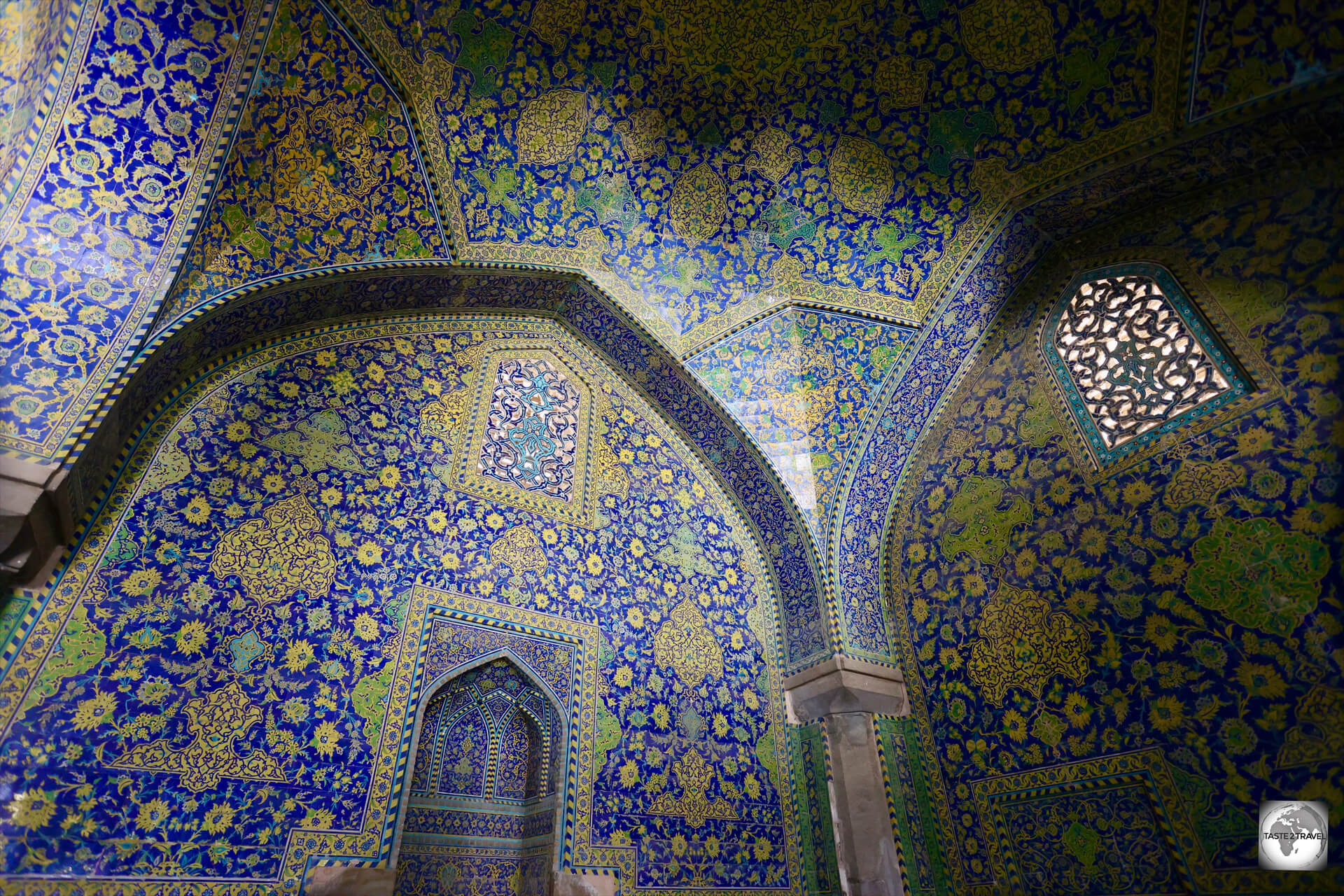
The seven colours used in the tilework at the Shah Mosque include – dark Persian blue, light Turkish blue, white, black, yellow, green and ‘biscuit’ (light golden yellow).
The splendour of the mosque is mainly due to the beauty of its seven-colour mosaic tiles and calligraphic inscriptions. The colours used for the tilework include dark Persian blue, light Turkish blue, white, black, yellow, green and biscuit (light golden yellow).

Every surface of the Shah Mosque is covered with hand-glazed tiles which feature just seven different colours.
While the tiles are predominantly blue, the walkways feature tiles of cooler, yellowy-green shades.
As with the nearby Sheikh Lotfollah Mosque, the architect employed an L-shaped vestibule to account for the difference between the direction of qibla (Mecca), and the gateway of the mosque on the main square.

This view of the Shah Mosque shows the main entrance (left) on the Naqsh-e Jahan Square, with the mosque offset 45-degrees to face Mecca.
This simple architectural trick subtlety changes the orientation of visitors by 45-degrees.

A view of one of the lofty, tiled, domes, inside the main prayer hall at the Shah Mosque in Esfahan.
Like the other monuments on the square, the Shah Mosque is listed as a UNESCO World Heritage Site.

The Shah Mosque is a huge structure, reportedly constructed using 18 million bricks and 475,000 tiles.
The Shah Mosque is a huge structure, said to contain 18 million bricks and 475,000 tiles.
Apart from the main mosque, the Shah Mosque complex includes two madrasa’s (religious schools) which face onto leafy courtyards.
Sheikh Lotfollah Mosque

A highlight of Esfahan, the magnificent Sheikh Lotfollah Mosque is known for its impressively tiled interior.
Situated on the eastern side of Naqsh-e Jahan Square, Sheikh Lotfollah Mosque is known for its delicate and intricate tilework, especially its dome.
Yet another UNESCO World Heritage Site, the Sheikh Lotfollah Mosque is considered a masterpiece of Iranian architecture.
Of the four monuments that dominated the perimeter of the Naqsh-e Jahan Square, this one was the first to be built.
Construction of the mosque started in 1603 and was finished in 1619.
It was built by the chief architect Mohammadreza Isfahani, during the reign of Shah Abbas I of Persia.
The purpose of this mosque was for it to be private to the royal court – unlike the Shah Mosque, which was meant for the public. For this reason, the mosque does not have any minarets and is smaller.
It was not until centuries later, when the doors were opened to the public, that ordinary people could admire the effort that Shah Abbas had put into making this a sacred place for the ladies of his harem, and the exquisite tile-work, which is far superior to that covering the Shah Mosque.
The creation of the calligraphy and tiles, which exceed, in both beauty and quality, anything previously created in the Islamic world, was overseen by Master calligrapher Ali Reza Abbasi.
The tilework on the interior side of the dome seems to lead the eye upwards toward its centre, as the rings of ornamental bands filled with arabesque patterns become smaller and smaller.
The monument’s architect was Mohammad-Reza Isfahani, who solved the problem of the difference between the direction of qibla (Mecca), and the gateway of the building on the square, by devising an L-shaped connecting vestibule between the entrance and the enclosure. This simple architectural trick changes the orientation of visitors by 45 degrees.

Because it was built as a private mosque for the royal court, the Sheikh Lotfollah Mosque lacks a minaret.
The design of the tiles on the interior side of the dome seems to lead the eye upwards toward its centre, as the rings of ornamental bands, filled with arabesque patterns, become smaller and smaller.
One of the design highlights for me was the incredible turquoise cable molding of each supporting archway. Thirty-two lozenges diminish in size as they approach the centre of each arch.
A truly outstanding beauty of Islamic architecture.
Ali Qapu Palace

Located on the western side of Naqsh-e Jahan Square, Ali Qapu Palace is a UNESCO World Heritage Site.
Located on the western side of Naqsh-e Jahan Square, Ali Qapu Palace is known for its ornate architecture and beautiful music hall.
A former imperial palace, it once served as the official residence of Persian Emperors of the Safavid dynasty.

The Ali Qapu Palace once served as the official residence of Persian Emperors of the Safavid dynasty.
UNESCO inscribed the Palace and the Square as a World Heritage Site due to its cultural and historical importance.
The palace is forty-eight metres high and there are six floors, each accessible by a difficult spiral staircase.
Sweeping views of the square are offered from the 5th floor balcony.
Qeysarie Gate

The stunning view of the Naqsh-e Jahan Square in Esfahan, from the private loft room at the top of Qeysariye Gate.
Qeysarie gate, which was built in the 17th century during the Safavid era, is an historical gate at the main entrance of the Bazaar of Isfahan and Qeysarie Bazaar in Isfahan, Iran.
The gate is located on the northern side of the square – the only cardinal point on the square which doesn’t feature a magnificent monument.
The gate originally had three floors, but the third floor was later destroyed. Today, a private loft room occupies the 3rd floor of the gate.

The best sunset views over Naqsh-e Jahan Square (the main square of Esfahan) are from the terrace of the Qeysariye Café.
The friendly staff at the Qeysariye Café can provide access to this private room which is accessed from the roof of the café.
For the best sunset views in town, you cannot beat the terrace of the Qeysariye Café which overlooks Naqsh-e Jahan Square.
This is where all the photographers congregate in the late afternoon, waiting to capture the magic which unfolds as the sun sets behind the square.

The evening view of the bustling Naqsh-e Jahan Square in Esfahan, from the terrace of the Qeysariye Café.
While the café also boasts a museum, the real highlight is hidden away up on the roof!
If you ask the friendly staff nicely, they’ll possibly provide access to a private room which is located in the loft of the Qeysariye Gate. This is the main gate on the north side of Naqsh-e Jahan Square.
The panoramic view from this private room is one of the best in Esfahan and you’ll most likely have it all to yourself!
Traditional Handicrafts
Esfahan is known for its traditional handicrafts, including exquisite Persian carpets, intricate miniature paintings, and fine silverware and copperware.
The galleries which line the sides of Naqsh-e Jahan Square are home to a warren of shops selling artisanal wares, rugs and traditional handicrafts.
Jameh Mosque of Esfahan

A UNESCO World Heritage Site, the ancient Jameh Mosque, one of the first mosques built in Iran, features a central courtyard surrounded by four Iwans.
Historic Esfahan is brimming with UNESCO World Heritage Sites.
One such site, which is hidden away in the back laneways of Esfahan Bazaar, is the incredibly beautiful and very old Jameh Mosque, which dates from around 771 CE.
The mosque is the result of continual construction, reconstruction, additions and renovations on the site from around 771 CE to the end of the 20th century.
As with many mosques in Iran, it is believed that the Jameh Mosque is built on top of a former Zoroastrian fire temple.
One of the first mosques to be built in ancient Persia, Jameh Mosque is one of the largest and most important monuments of Iranian-Islamic architecture in Iran and certainly a significant sight of interest.

Detail of the Muqarna, which adorns the ceiling of the southern Iwan at the Jameh mosque in Esfahan.
The southern Iwan of the courtyard (leading to the mihrab) was distinguished from the other Iwans by being larger and by being embellished with large tiers of muqarnas.
The oldest part of the mosque complex is the ancient hypostyle hall which dates from the 8th century CE.
The hypostyle hall is comprised of many rows of square, baked brick pillars. The reason for the square pillars was that it was easy to lay carpets on the floor of the prayer hall, whereas laying carpets around rounded pillars is much more difficult.
The pillars of the hypostyle hall support a vaulted ceiling which is festooned with many different styles of domes, all built using baked bricks.

A view of the domed ceiling of the hypostyle hall at the Jameh Mosque, all of which was constructed from baked bricks.
Throughout its history, most rulers of ancient Persia continued to expand and improve the Jameh Mosque.
The one notable exception was Shah Abbas I who was more preoccupied with his new constructions around the Naqsh-e Jahan Square, especially the Shah Mosque.
The mosque today is an amalgamation of different styles and periods coalesced into one building, the details of which cannot always be easily dated. It’ a real mish-mash of architectural styles and influences.
Not easy to find, unless you are being guided by Essi of course, the Jameh Mosque is now thoroughly enmeshed with the surrounding structures of the bazaar and the old city.
Chehel Sotoun Palace

Yet another UNESCO World Heritage Site, Chehel Sotoun was built during the Safavid dynasty, during the reign of Shah Abbas II in the 17th century.
A UNESCO World Heritage Site, Chehel Sotoun is an historic palace located a short walk from Naqsh-e Jahan.
The name “Chehel Sotoun” translates to “Forty Columns” in Persian, referring to the twenty slender wooden columns that are reflected in the pool in front of the palace, creating the illusion of forty columns.

A view of the entrance pavilion at Chehel Sotoun Palace, which is supported by twenty wooden columns.
Chehel Sotoun was built during the Safavid dynasty, specifically during the reign of Shah Abbas II in the 17th century. The architectural style reflects the grandeur and opulence of the Safavid era, characterised by the use of intricate tilework, frescoes, and symmetrical designs.
The palace is set within a large garden, and in front of the main building, there is a reflecting pool. The reflection of the palace and the surrounding trees in the pool is what gives the palace its name.
The main hall of the palace is adorned with impressive frescoes and murals depicting historical and mythological scenes. These paintings showcase court ceremonies, battles, and scenes from Persian literature.

The main hall of the palace is adorned with impressive frescoes and murals depicting historical and mythological scenes.
The palace served as a venue for official receptions and state functions during the Safavid era. It was a place where the Shah would entertain foreign dignitaries and ambassadors.
The historical significance of Chehel Sotoun is tied to its role in the political and cultural life of the Safavid court.
Armenian Quarter
Esfahan has a vibrant Armenian community, and the Armenian Quarter is known for its historical churches, including Vank Cathedral with its stunning frescoes and artifacts.
Vank Cathedral, or the Holy Saviour Cathedral, is an Armenian Cathedral which lies at the heart of the Armenian district of New Julfa.
The cathedral was established in 1606, built by the hundreds of thousands of Armenians who were forcibly resettled by Shah Abbas I in his new capital as part of his scorched-earth policy in Armenia during the Ottoman War of 1603-1618.
As part of Abbas’s forced resettlement of peoples from within his empire, as many as 300,000 Armenians (primarily from Jugha) were resettled in Esfahan during Abbas’ reign.

The walls of Vank Cathedral are painted with frescoes, some of which depict tortures inflicted upon Armenian martyrs by the Ottoman Empire.
In Esfahan, he ordered the establishment of a new quarter for these resettled Armenians from Old Julfa, and thus the Armenian Quarter of Isfahan was named New Julfa (today one of the largest Armenian quarters in the world).
The church also features an Armenian museum and memorial to the Armenian genocide.
Outside, the streets of New Julfa are lined with Armenian cafes, restaurants and shops.
Historic Bridges

The Allahverdi Khan Bridge, popularly known as Si-o-se-pol (bridge of thirty-three arches), which spans the, normally dry, Zayanderud river in Esfahan.
Esfahan is renowned for its historical bridges, including the Si-o-Se-Pol and the Khaju Bridge.
The Allahverdi Khan Bridge, popularly known as Si-o-se-pol (bridge of thirty-three arches) is the largest of the eleven historical bridges on the Zayanderud, the largest river of the Iranian Plateau.
The bridge was built in the early 17th century to serve as both a bridge and a dam. It is a popular recreational gathering place, and is one of the most famous examples of Iran’s Safavid architecture.
These bridges serve as both functional crossings over the Zayandeh Rud River which is normally dry.
Esfahan Music Museum

The guide from the Esfahan Music Museum (left), and my regular guide, Essi, holding a very long Iranian horn instrument,
Located in the new part of town, the Esfahan Music Museum is a privately-run museum showcasing over 300 traditional Iranian musical instruments in a sleek gallery.
The museum is operated by enthusiastic and talented music students who provide fully guided tours with lots of demonstrati0ns on the different instruments.
A fascinating insight into the rich musical culture of Iran.
Located in Hasht Behesht Garden, entrance costs US$6, which includes a private concert at the conclusion of the guided tour.
Natanz
Located in the desert, 135 km north of Esfahan, the sleepy, oasis town of Natanz (pop: 14,000) is a garden town with a history dating back 2,500 years.
Jameh Mosque
A highlight of Natanz is the ancient Jameh Mosque which dates from the 11th century (CE).
It features a 37-metre-high minaret and the tomb of the 8th century mystic, Sheikh Nour al-Din Abdolsamad Isfahani Natanzi.
The dome of the mosque, which is currently being renovated, was built in the 11th century, while other sections were constructed in the 14th century.
Natanz Fire Temple
Behind the mosque are the remains of an ancient Zoroastrian Fire Temple which dates from the Sasanian era (224–651 CE).
Very little remains of the structure.
Natanz Nuclear Facility
In modern times, Natanz has gained international attention due to the Natanz Nuclear Facility, the largest such facility in the country, which is known for Iran’s nuclear enrichment activities.
The facility includes an underground uranium enrichment plant and has been a subject of international scrutiny and negotiations.
The facility lies on the side of the highway, north of Natanz, on the road to Kashan.
Strictly – no photos allowed as you pass the facility!
Abyaneh

Located in the desert, halfway between Esfahan and Kashan, the village of Abyaneh is famous for its ochre red mud-brick houses.
Located in the mountains, between Esfahan and Kashan, the remote desert village of Abyaneh (population: 300) is famous for its ochre red mud-brick houses.
This ancient village, which has largely preserved its culture, language, architecture, costume and traditional rituals over the centuries, remains largely unaffected by the modern world.
Abyaneh is often referred to as an “ancient living museum” due to its history, which dates back over 2,000 years.
The village has been continuously inhabited, making it one of Iran’s oldest settlements.
Abyaneh’s distinctive red mud-brick houses, known as “kharanegh,” are designed with thick walls to withstand harsh weather conditions, including heavy snowfall in winter and scorching heat in summer.
The reddish hue of the buildings comes from the local clay and is a defining characteristic of the village.
The villagers in Abyaneh often wear traditional clothing, which includes colourful and ornate dresses for women and white garments for men.
Abyaneh is known for its local handicrafts, including intricate traditional embroidery and textiles, which can be found in the village’s shops and market stalls.
Kashan
Located 2,5 hours (209 km) north of Esfahan, and 250 km south of Tehran, the city of Kashan has a history dating back over 7,000 years, making it one of Iran’s, and the world’s, oldest continually inhabited cities.
For millennia, Kashan has served as an important centre for trade, culture, and craftsmanship along the Silk Road.
Trade bought great wealth to the city and some of this wealth was channeled into grandiose mansions in the ultimate game of “keeping up with the Joneses“.
Today, Kashan is known for its truly opulent historic houses known as “Kashan traditional houses” that showcase exquisite stucco work, elegant courtyards, and beautiful windcatchers (badgirs) designed to provide natural cooling.
No expense was spared when it came to building the finest of mansions for the city’s ruling class.
Tabatabai House
One such mansion is Tabatabai House, which was built for the wealthy Tabatabai family.
The house was built around 1880, during the reign of the Qajar dynasty. It is one of the most prominent historic houses of Kashan and Iran.
Tabatabai House was designed by famed Persian architect Ali Maryam, who later designed nearby Borujerdi House.
A renowned architect, Ali Maryam, was responsible for designing many of the fine buildings which, today, draw the tourist hordes to Kashan.
Tabatabai House covers nearly 5,000 square metres and includes 40 rooms, four courtyards, four basements, three windcatchers, gardens and ponds.
The house is decorated with stone reliefs, stucco, and stained glass. A truly dazzling sight!
Abbassian House
Located a short walk from Tabatabai House, Abbassian House is another fine example of a grand Kashan mansion.

Built for a wealthy glass merchant, Abbassian House is one of the finest of Kashan’s historical mansions.
Haj Mohammad Ibrahim, a well-known glass merchant, commissioned this house in 1836.
The architectural style of Abbasian House is like other traditional houses in Kashan, with buildings arranged around a central courtyard.
Common to houses built in Kashan, Abbasian House is placed below ground level. Therefore, visitors descend into the property when entering.
This simple design trick allowed buildings to be closer to the subterranean aqueduct and it insulated the building during summer and winter.
Construction took 20 years, with hundreds of craftsmen creating what has been nominated as the most beautiful Iranian-Islamic residential building in Iran.
The sprawling property is comprised of five, multi-level, courtyards and multi-story buildings which have been decorated with plaster reliefs, mirror work, and stained-glass.
The structure of Abbasian House consists of several floors, courtyards, and buildings. The whole complex is finely decorated with Orsi windows, mirrors and plaster reliefs.

Abbassian House consists of several courtyards and multistorey buildings, and is decorated with plaster reliefs, mirror-work, and stained glass.
There are traces of original Iranian-Islamic architecture in every corner of the house.
You can see it in the original designs, plaster patterns, and various decorations of this house.
Its beauty is stunningly eye-catching. That’s why it is considered to be one of the most beautiful Iranian-Islamic residential buildings ever to be built.
Borujerdi House
Also in the same neighbourhood, Borujerdi House was constructed in 1857, by everyone’s favourite architect Ali Maryam, for Seyyed Mehdi Borujerdi, a wealthy merchant.
The mansion, which was built in the name of love, is decorated with stucco, glass work, and mirror work, and features frescoes by prominent painter Kamal-ol-Molk.
Seyyed fell in love with a girl from the affluent Tabatabai family, who lived nearby in the fanciest mansion in town. To impress her family, Seyyed built this mansion for his would-be bride.
With no expense spared, construction took 18 years and employed 150 craftsmen. Love knows no bounds!
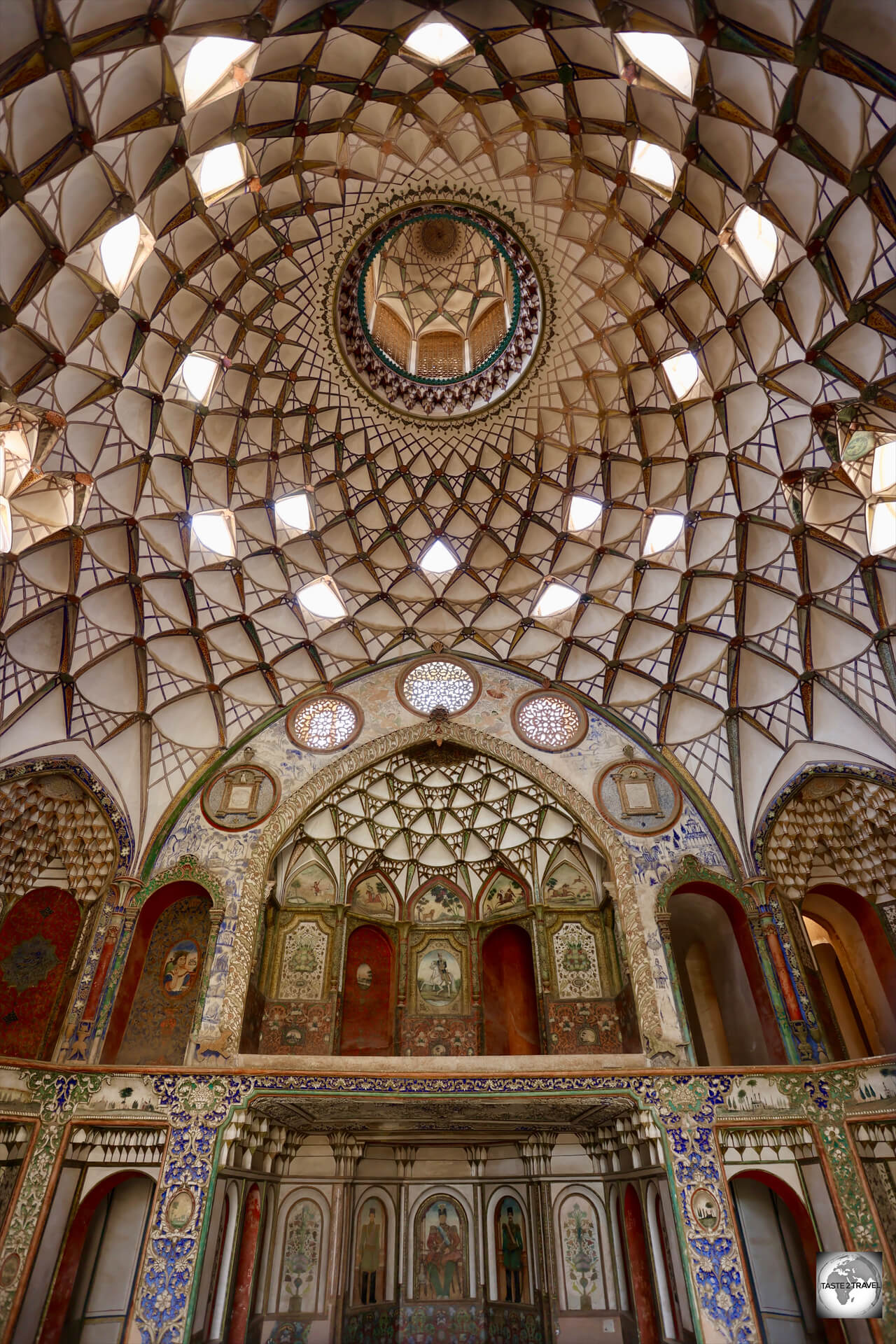
The bride came from the affluent Tabatabai family, for whom the architect had built the nearby Tabatabai House several years earlier.
To ensure success for his project, and ultimately the approval of the bride’s father, Borujerdi commissioned the architect, Ali Maryam, to build his magnificent mansion. Conveniently, Ali Maryam had also built the Tabatabai family mansion several years earlier.
In the end, the bride was happy, Mr Tabatabai gave approval for the wedding and the couple lived happily ever after in their fancy love pad.
Sultan Amir Ahmad Bathhouse

The Sarbineh (dressing hall) at the Sultan Amir Ahmad Bathhouse in Kashan features a large octagonal hall and has an octagonal pool in the middle, separated by 8 pillars from the outer section.
The exquisitely designed Sultan Amir Ahmad Bathhouse, also known as the Qasemi Bathhouse, is an ancient Persian hammam located in the heart of historic Kashan.

Constructed in the 16th century, the opulent Sultan Amir Ahmad Bathhouse features exquisite design details.
Constructed in the 16th century, during the Safavid era, the bathhouse sustained damage in 1778 as a result of an earthquake and was renovated during the Qajar era.

The interior of the Sultan Amir Ahmad Bathhouse is decorated with turquoise and gold tilework, plasterwork, brickwork, as well as artistic paintings.
The bathhouse is named after Imamzadeh Sultan Amir Ahmad, whose mausoleum is nearby.
The bathhouse is known for its beautiful turquoise and gold tile work.
The roof of the bathhouse is made of multiple domes that contain convex glasses to provide sufficient lighting to the bathhouse while concealing it from the outside.
Agha Bozorg Mosque

Built in the 18th century, a unique feature of the Agha Bozorg Mosque in Kashan is its sunken courtyard.
Agha Bozorg Mosque is an historical mosque, located in the heart of Kashan old town.

Thanks to the work of Ali Maryam, design elements from the Agha Bozorg Mosque can be seen elsewhere in Kashan.
This 18th-century complex is a fine example of Islamic architecture, with a mosque, a madrasah (religious school), and a beautiful sunken courtyard adorned with intricate tilework and calligraphy.
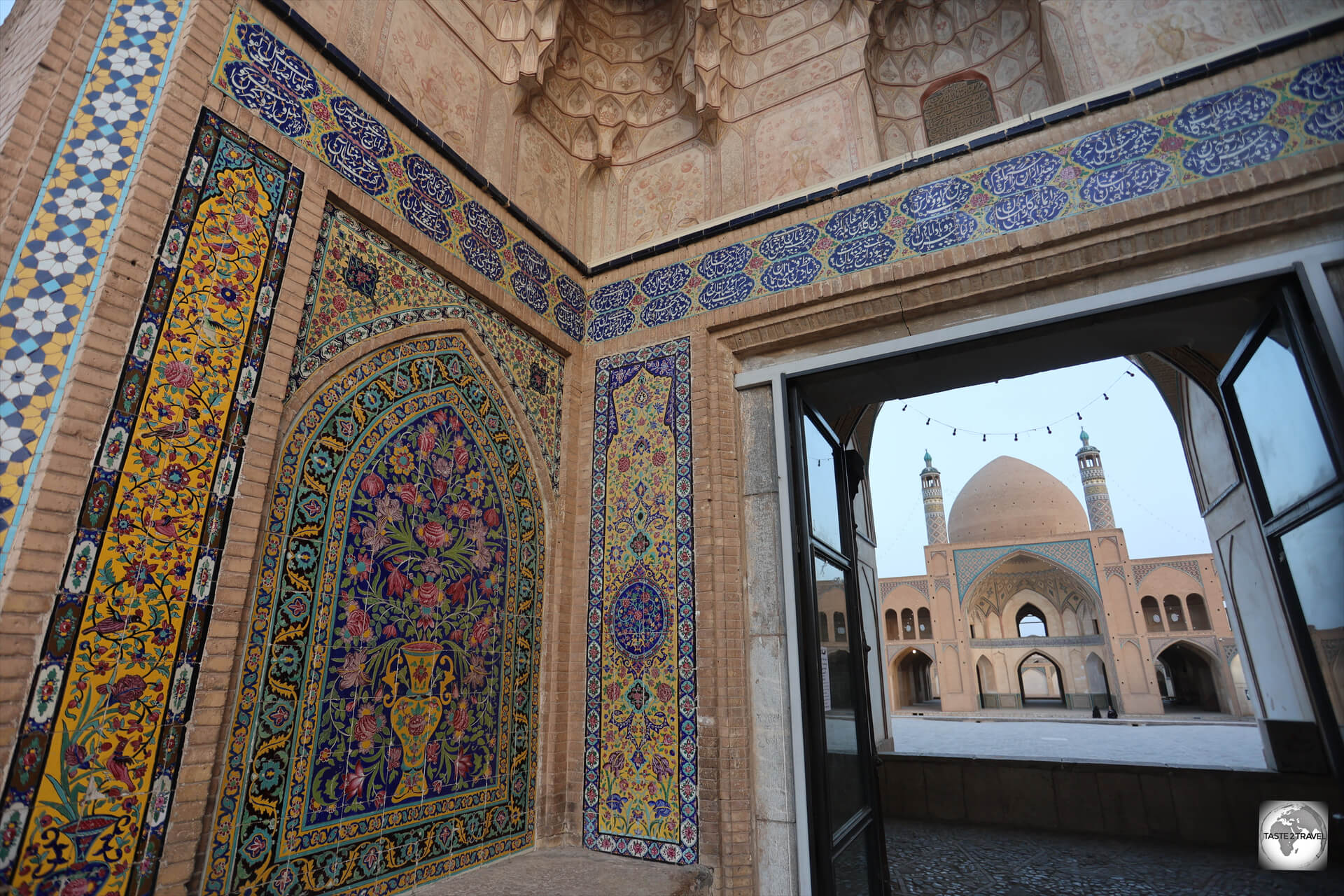
Ali Maryam, who designed many of the most beautiful mansions in Kashan, started his career as an architect at the Agha Bozorg Mosque.
The layout of the mosque is unique in that it sits above a subterranean, tree-lined, courtyard. This sunken space, which is cooler in the intense summer heat, is home to a Madrasah.
The mosque has been described as “the finest Islamic complex in Kashan and one of the best of the mid-19th century”.
It was here where Ali Maryam, who designed many of the most beautiful mansions in Kashan, started his career as an architect.
Kashan Bazaar
Kashan’s historic bazaar is a sprawling, vibrant, marketplace where you can shop for textiles, spices, carpets, ceramics, and local handicrafts.
A truly ancient bazaar which dates from the Seljuk era (10th -11th century CE), the covered laneways of Kashan bazaar sprawl for several kilometres throughout downtown Kashan.
A highlight of Kashan bazaar is Aminoddole Plaza, a former caravanserai and one of several plazas in the grand Bazaar of Kashan, Iran.
The plaza was designed primarily for commerce, but in recent times has been used for important religious ceremonies. It used to be an important trading place on the Silk Road.
Aminoddole Plaza was designed by the famed Persian architect – Ali Maryam (of course!) whose many magnificent designs transformed Kashan.
Fin Garden
Located on the outskirts of Kashan, this UNESCO World Heritage-listed Persian garden is one of Kashan’s most famous attractions. It features lush gardens, reflecting pools, and historic pavilions, making it a tranquil oasis in the desert landscape.
Rosewater Production
Kashan is famous for its rosewater, which is extracted from the fragrant rose petals grown in the surrounding region. The rosewater is used in culinary and cosmetic products and is an important part of local culture.
Shops throughout town distill and sell huge quantities of fragrant rosewater.
Each morning at breakfast, the hotel staff served me a large glass of ice-cold rosewater. It was a refreshing start to the day, with the desert heat already topping 40-degrees.
Tehran

Government propaganda, which does not correspond with the sentiments of ordinary Iranians, adorns a building in Tehran!
Finally, to Tehran, the capital city, and largest city, of Iran.
The last stop on my 3-week meandering odyssey with my guide Essi. We had covered so much since leaving Shiraz and I had taken about 1,500 photos. Truly extraordinary!
Bustling Tehran (the traffic is intense) is located in the north-central part of the country and serves as the political, economic, cultural, and transportation hub of Iran.
Home to 8.6 million souls, Tehran is a sprawling metropolis with a rich history, a diverse population, and a wide range of attractions and activities.
Compared to other cities in Iran, Tehran is young – at just over 200 years old. Despite its youth, Tehran grew significantly in the 19th and 20th centuries, particularly during the Qajar and Pahlavi dynasties.
It became Iran’s capital in the late 18th century and has played a central role in the country’s political and cultural development.
Tehran is home to numerous museums and cultural institutions, including the National Museum of Iran and the Golestan Palace Complex.
Golestan Palace

A UNESCO World Heritage Site, Golestan Palace was built in the 16th century as part of the royal palace complex for the Qajar dynasty.
Golestan Palace is the one site in the capital which is listed by UNESCO as a World Heritage Site.
The palace was built in the 16th century, renovated in the 18th century and finally rebuilt in 1865. It is the former official royal Qajar complex in Tehran.

Golestan Palace consists of gardens, royal buildings, and collections of Iranian crafts and European presents from the 18th and 19th centuries.
One of the oldest historic monuments in Tehran, Golestan Palace belongs to a group of royal buildings that were once enclosed within the mud-thatched walls of Tehran’s arg (“citadel”).
Golestan Palace consists of gardens, royal buildings, and collections of Iranian crafts and European presents from the 18th and 19th centuries.
This historic palace complex in the heart of Tehran features beautifully decorated halls, gardens, and museums, offering visitors a glimpse into Iran’s royal history.
One of the highlights of Golestan Palace is the spectacular Marble Throne terrace, which was built between 1747-1751, by the order of Fath Ali Shah of the Qajar dynasty.
The terrace is adorned by paintings, marble-carvings, tile-work, stucco, mirrors, enamel, woodcarvings, and lattice windows. The Marble Throne terrace embodies the finest of Iranian architecture.
The centre piece of the terrace is the famous Marble Throne, which is made from yellow marble from Yazd Province. The throne consists of sixty-five pieces of marble, and was designed by Mirza Baba Naqash Bashi (“head painter”) of the Qajar court.
Coronations of the Qajar kings and formal court ceremonies were held on this terrace. The last coronation to be held at the Marble Throne was the coronation of Reza Shah of the Pahlavi dynasty, in 1925.
National Museum of Iran
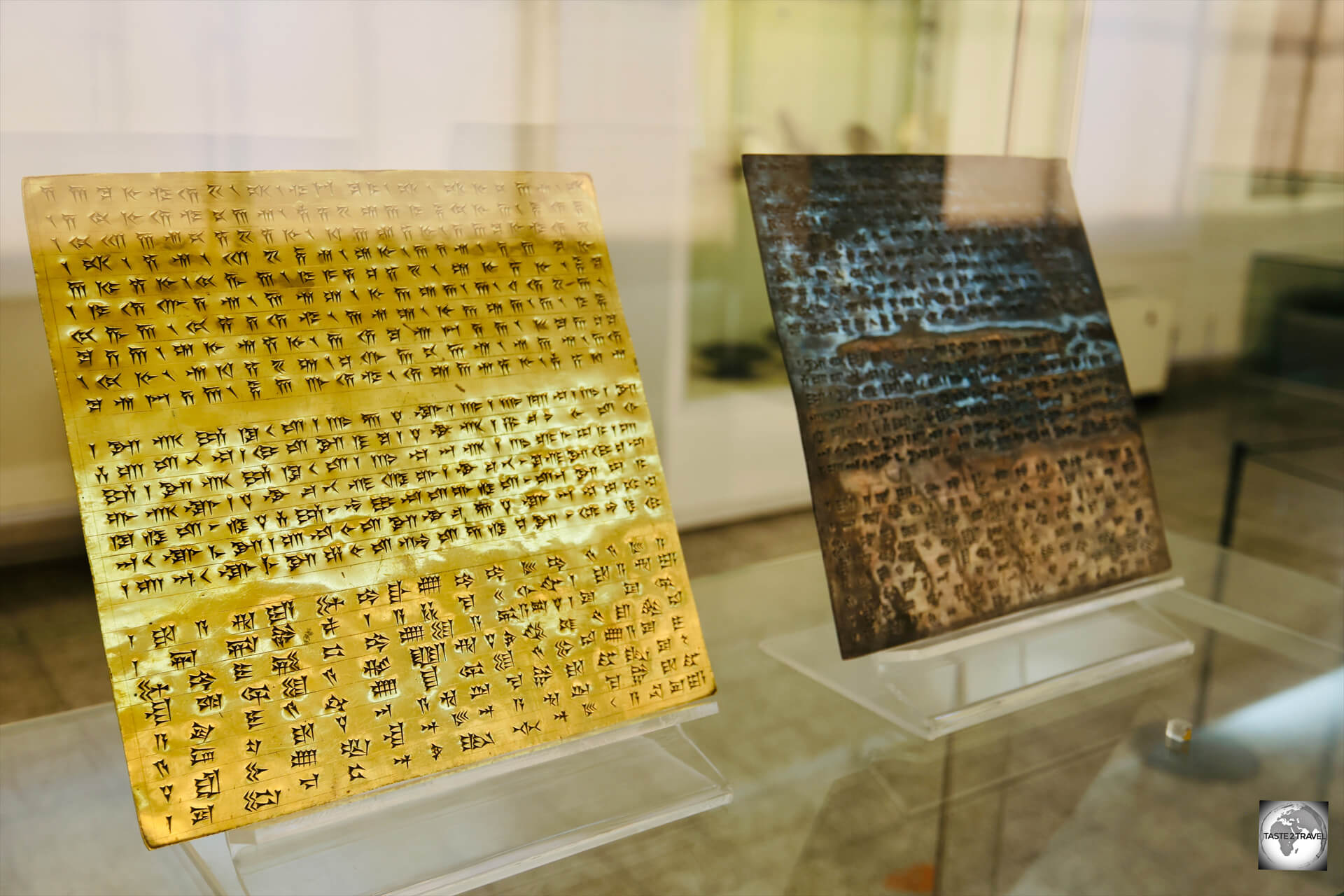
The gold and silver foundation tablets of the Apadana Palace in Persepolis, a highlight of the National Museum of Iran.
Located a short walk from Golestan Palace, the National Museum of Iran is one of the oldest and most significant museums in the country.
It houses a vast and diverse collection of artifacts, spanning several millennia of Iran’s rich history and cultural heritage.
A highlight of the museum are two foundation tablets, one in gold and the other in silver, from the Apadana Palace in Persepolis.
Found in stone boxes in 1933, they contain a trilingual inscription by Darius I (r. 522-486 BCE) in Old Persian, Elamite and Akkadian, which describes his Empire in broad geographical terms.
The museum is situated in two separate buildings: the Museum of Ancient Iran and the Museum of the Islamic Era.
Azadi Tower
The Azadi Tower, also known as the Freedom Tower, is one of Tehran’s iconic landmarks. It was built to commemorate the 2,500th anniversary of the Persian Empire and offers panoramic views of the city from its observation deck.
It is one of the landmarks of Tehran, marking the west entrance to the city, and is part of the Azadi Cultural Complex, which also includes an underground museum.
The tower is about 45 metres (148 ft) tall and is completely clad in cut marble.
It was commissioned by Mohammad Reza Pahlavi, the last Shah of Iran, to mark the 2,500-year celebration of the Persian Empire and completed in 1971.
It also serves as the country’s “kilometre zero”
Accommodation

Due to sanctions, accommodation in Iran cannot be booked online using the usual booking services such as booking.com, hotels.com, Expedia etc.
One Iranian company – 1st Quest – fills this void by allowing you to book hotels, online, in advance, using a credit card.
This is an invaluable service since you need to specify on your Iranian visa application, your exact itinerary, including hotel names for each day you will be in Iran. For more on the visa application, please refer to the ‘Visa Requirement‘ section below.
Prepaying accommodation also removes a major expense which will save your precious USD cash reserves while in the country.
Shiraz
While in Shiraz, I stayed at Taha Traditional Hostel, which I booked online through 1st Quest.
Taha Traditional Hostel is located in the heart of Shiraz old town.
Built around a leafy courtyard, this old stone building is about 150 years old and dates to the Qajar dynasty.
Taha Hostel features 2 buildings with 20 basic rooms – ideal for budget travellers!

My typical Iranian breakfast, which was served each morning in the leafy courtyard of the Taha Traditional Hostel in Shiraz.
My simple double room cost €30 per night which included a traditional breakfast, which was served in the courtyard outside my room.
This is a budget hotel, although the room rate is a little high for what is being offered.
One recommendation from my guide Essi (a native of Shiraz) is the excellent Zandiyeh Hotel which is a deluxe option in downtown Shiraz.
Yadz
While in Yadz, I stayed at the comfortable Yazd Friendly Hotel, which I booked online through 1st Quest.
Yazd Friendly Hotel provides accommodation in a traditional hotel in the heart of Yazd Old Town. From the hotel, all the sights of Yazd are a short stroll away!
My simply furnished, spacious, double room cost just €16 per night which included a delicious traditional breakfast, served in the courtyard directly outside my room.
Of all my hotels in Iran, the Yazd Friendly Hotel provided the best value.
A budget hotel, Yazd Friendly Hotel provides a total of 10 ensuite rooms which are clean and spacious.
All rooms open onto the tranquil, leafy, central courtyard which is where a scrumptious breakfast is served each morning.
Esfahan
While in Esfahan, I stayed at the excellent Keryas Traditional Hotel, which I booked online through 1st Quest.
Of all my hotels in Iran – Keryas Traditional Hotel was my favourite!
My beautiful, spacious double room cost €43 per night which included an amazing buffet breakfast in the courtyard directly outside my room.
The hotel is centrally located next to Naqsh-e Jahan Square and directly behind the iconic turquoise dome of the Shah Mosque.
From the excellent service, which is provided by the enthusiastic staff, to the deluxe, spacious rooms which line the central courtyard, to the amazing buffet breakfast is served each morning in the courtyard – life at the Keryas Traditional Hotel is very relaxed and easy!
After breakfast, where I recommend the small pancakes with locally made jam and sour cream, you only need to step outside to find yourself in the heart of historic Esfahan.
Kashan
While in Kashan, I stayed at Falahati House, which I booked online through 1st Quest.
Housed in a recently renovated Kashan historic house, the staff, rooms and ambience ticked all the boxes.
My comfortable double room cost €44 per night which included a very good breakfast in the, refreshingly cool, subterranean restaurant.
However, it’s all about location, location, location!
Unfortunately, Falahati House is in the wrong location, being situated about 2 km south of the main tourist area and well away from any shops or cafes. There is nothing in the immediate area which would appeal to visitors!
For this reason, I would recommend booking something closer to the historic houses’ neighbourhood, where there are many fine hotels, cafes and restaurants.
Tehran

My hotel in Tehran, the Ferdowsi International Grand Hotel is considered to be one of the finest hotels in Iran.
While in Tehran, I stayed at the Ferdowsi International Grand Hotel, which I booked online through 1st Quest.
Although this is considered to be one of the top hotels in Iran, it would be rated as an average hotel in other parts of the world. The rooms, and facilities, are old and dated and the hotel is in need of a complete renovation.
However, it’s in an unbeatable location, being just a short stroll from the main sights of Golestan Palace and the Iran National Museum.
My comfortable double room cost €77 per night which included a buffet breakfast.
Strangely, there is a complete lack of restaurants and cafes anywhere near the hotel. What you will find in the surrounding neighbourhood are many shops selling automotive spare parts, hardware, toilets and bathroom accessories.
Eating Out
Like the cuisines of neighbouring countries, the cuisine of Iran reflects the influences of various civilisations that have occupied or traded with the region over centuries.
As with other countries in the region, grilled meat, particularly kebabs, is a significant part of Iranian cuisine. Popular varieties include koobideh (minced meat kebabs), barg (grilled lamb or beef fillets), and joojeh (grilled chicken).
Most meals are served with fresh, tasty salads and freshly baked flatbreads – which are normally served straight from the tandoor (‘Tanur‘ in Iran) oven.
Spices form an integral part of Iran cuisine, especially saffron, for which Iran is famous.
Saffron
Saffron is a highly prized spice in Iranian cuisine, used for its distinct flavour and colour.
A great place to sample saffron-infused cuisine is the Saffron Cottage restaurant in Naeen where the owner, Davood prepares the most delectable dishes using saffron from his family’s farm.
Davood is a good friend of Essi, so if you are travelling with Essi, you will no doubt end up at the Saffron Cottage for lunch.
Rosewater
Rosewater holds cultural and culinary significance in Iranian cuisine. It is an essential ingredient in various Persian dishes, both sweet and savory. Rosewater adds a distinctive floral aroma and flavour to dishes, enhancing their overall taste.
In Turkey, Rosewater it is most commonly used to flavour Turkish Delight!
The main centre of Rosewater production is the town of Qamsar, which is located 30 km south of Kashan. Rosewater is produced in more than 1500 traditional distilleries in Qamsar, with much of it being sold in shops in Kashan.
Qamsar’s rosewater is made from a special rose called “damask rose”. It has a very distinctive flavour and is used heavily in Iranian cuisine and sweets. It is also used as a perfume among Muslims.
Rosewater from Qamsar has a special spiritual status too—it is used, each year, to wash the Kaaba shrine in Mecca, one of the most sacred sites in Islam.
Carrots Galore!
Carrots appear in the most unlikely foods in Iran.
While the rest of the world has carrot cake, Iranians prefer to serve their carrots in an ice-cream float!
Yes – Ab Havij Bastani is an ice cream float using carrot juice and is very popular in Iran. It is quite tasty and oddly refreshing on a 40-degree day.
The most popular jam in Iran is carrot jam. It was served at every hotel I stayed at and was often the only choice of jam.
Faloodeh

Faloodeh, seen here in Shiraz, is a sorbet ice cream which is mixed with vermicelli rice noodles and rose water.
Also worth a special mention is Faloodeh, an ancient Persian sorbet ice cream which is made of such unusual ingredients as vermicelli rice noodles, rose water, lime juice, and different syrups.
Restaurants
Shiraz
Kateh Mas Restaurant

Delicious Iranian food, featuring Persian rice with crispy Tahdig, served at the excellent Kateh Mas Restaurant in Shiraz.
Hidden away, underneath one of the main streets of downtown Shiraz, the Kateh Mas Restaurant serves excellent Iranian cuisine with the most amazing ‘doogh‘ (a salty yoghurt drink which is known as ‘Ayran‘ in Turkey).
Live folk music is provided at meal times which adds to the atmosphere.
During my several visits, I was the only foreigner in attendance, with all other tables full of Iranian families who were enjoying the food and music.
All meals are served with Persian rice with crispy Tahdig, which is undoubtedly the most delicious and popular dish in Persian cuisine. Think of fluffy rice which is then flipped upside down to reveal a crispy golden crust at the top.
Truly delicious!
Cave Restaurant @ Bakuya Restaurant Complex

The Cave Restaurant is perched inside the hillside Bakuya Restaurant Complex, offering panoramic views of Shiraz and traditional Iranian cuisine.
Yadz
Fazeli Café
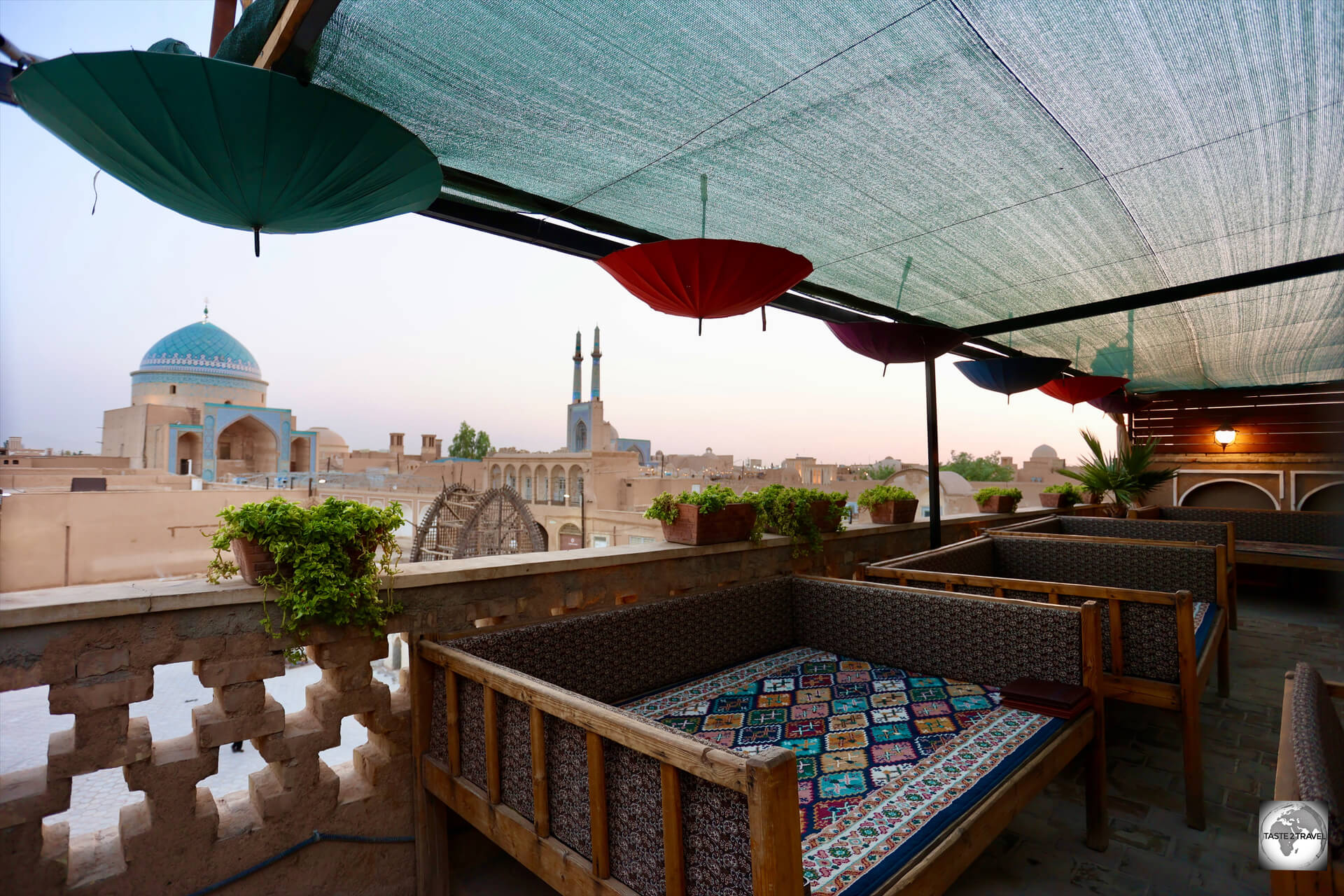
The rooftop terrace of the Fazeli Café offers good Iranian cuisine and unbeatable views of Yazd old town.
Located in the heart of Yazd old town, on the rooftop of the Fazeli Hotel, the Fazeli Café serves typical Iranian cuisine and deliciously refreshing drinks with an unbeatable view of Yazd old town.
This is the best place in town for sunset drinks – although without alcohol of course!
Esfahan
Mirza Soleiman Khan Rahnejat Mansion

The very popular ‘Mirza Soleiman Khan Rahnejat Mansion’ Restaurant, in Esfahan old town, serves very tasty Iranian cuisine.
Located in a laneway, a short walk from the main square, the very popular Mirza Soleiman Khan Rahnejat Mansion Restaurant serves the most delicious Iranian food in a cool, leafy garden.
The restaurant, which was fully renovated in 2017, is housed in a European-style mansion which was built during the Qajar era.
Kashan
Abbasi Teahouse and Restaurant
Occupying the basement of Abbasi house, this family-run restaurant is justly popular with visitors.
Traditional seating is arranged around a fountain and the menu features equally traditional dishes, such as kebabs and roasted vegetables and stews.
The restaurant has a collection of all world flags and will ensure visitors dine with their national flag.
Cafés
While tea is the drink of choice among Iranians – always served with a stick of crystallised sugar – coffee is becoming more popular among the youth of Iran.
Due to sanctions, Iran has been spared from the onslaught of international coffee shop chains. Instead, the Iranians have created their own coffee shops, which are so much better than any of the international chains.
While travelling in Iran, I was able to find excellent coffee in most towns.
Shiraz
Youlep Café

Located in the heart of Shiraz old town, the very popular Joulep Café serves excellent coffee and food.
Located on a square in Shiraz old town, next to the Vakil Mosque, the Joulep Café serves very good coffee, delicious cakes and food.
The café, and the square, are a great place to relax during sunset, after a busy day of sightseeing in historic Shiraz.
Yadz
Papasi Café

Located in the heart of Yazd old town, the Papasi Café serves excellent coffee and food in a beautifully styled environment.
While there are many places for coffee in Yazd, there is only one Papasi Café.

Being spoilt, with amazing coffee and a very personalised chocolate cake, at the truly divine Papasi Café in Yazd.
Located in the heart of the old town, a short walk from the Jameh Mosque, this café offers excellent coffee, cakes, and food, all served by the friendliest of staff in a beautifully styled environment.
Highly recommended!
Esfahan
Big and cosmopolitan Esfahan is brimming with excellent cafés. Caffeine addicts are spoilt for choice with excellent cafes located in most neighbourhoods.
Radio Café
The centrally located Radio Café was one of many favourite cafés in Esfahan.
Centrally located a short walk from the main sights, such as Naqsh-e Jahan Square and Chehel Sotoon Palace, this modern café offers excellent coffee, very good international food and a wonderful ambience.
Some reviewers on TripAdvisor claim that this café serves the best coffee in Esfahan, I’m a very fussy coffee drinker and I concur!
Naqsh-e Jahan Square Cafés

One of many cafes, which are hidden away inside the shopping galleries which line Naqsh-e Jahan Square in Esfahan.
Tucked away, inside the shopping galleries which line Naqsh-e Jahan Square, there are a couple of funky, cavernous cafes which offer a respite from souvenir shopping.
Kashan
Dopaza Café
Both Essi and I agreed that our favourite café in Kashan was the hip and funky Dopaza Café. We would start each day by first having a coffee, or two, at this convivial café.
With almost all reviews on TripAdvisor rating the café as ‘excellent’, you know you are in good hands.
Avgoon Café

A view of the stunning interior of the Avgoon Café, which is located in the refreshingly cool basement of the Ameriha Hotel in Kashan.
Located around the corner from the Dopaza Café, the opulent Avgoon Café is located in the basement of the Saraye Ameriha (Ameriha Hotel) in Kashan.
Hotels in Kashan often locate their restaurants and cafes underground, where it is so much cooler.
This sprawling mansion was originally built as a family residence during the Zand dynasty (1751-94 CE) for Agha Ameri, the governor of Kashan. The property has now been restored and transformed into a beautiful boutique hotel.
Being the largest traditional house in Kashan, it has several interior and exterior yards, each consisting of pools and many rooms. It also has the highest wind catcher in Kashan.
Bars
Forget it! Alcohol is strictly banned in the Islamic Republic of Iran!
Prior to departing from Dubai International Airport on my Flydubai flight to Shiraz, the captain announced that no alcohol was allowed to be carried on the flight to Iran!
Upon arrival at Shiraz airport, all bags were x-rayed to ensure compliance!
Visa Requirements
Introduction
The Visa Policy of Iran has been relaxed in recent years and now allows most nationalities to apply for an “e-Visa”. I use quotes here because the Iranian e-Visa isn’t really an e-Visa!
As is typical of Iran, this “e-Visa” hasn’t simplified the visa process but has just added an additional layer to the original process.
The Iranian e-Visa is an electronic visa in name only!
Once you apply for the e-Visa, if successful, you will receive a ‘Visa Authorisation‘ letter via email from your sponsoring company.
You then must present yourself, along with the Visa Authorisation letter, at a (pre-designated) Iranian embassy/ consulate where you must then join the line to apply for a traditional visa.
No Passport Stamps
Being mindful of the fact that some countries, notably the United States, refuse admission to those who have travelled to Iran, the government of Iran does not stamp passports.
They also only provide a visa in the form of an electronic document – no visa is placed in your passport.
At the end of your visit, there will be no proof in your passport that you visited Iran.
However, if you cross a land border from a neighbouring country, you will have a passport stamp from the neighbouring country.
Visa Sponsorship
Twice before, many years ago, I had lodged my own applications for an Iranian visa at two different embassies. Both times, after many days of waiting, my applications were denied with no explanation given.
Today, if you apply independently for a visa, there is a good chance it will be denied.
The ensure a successful outcome, you need to apply for a visa through an Iranian-registered travel company.
I applied online though Tap Persia and received my Visa Authorisation letter in about 3 days.
The process through Tap Persia is very simple:
- Fill in the online visa application form.
- Pay TAP Persia’s service fee of €28 (this is not the visa fee – just the service fee charged by Tap Persia).
- Receive the Visa Authorisation Letter in 3-5 business days.
- Collect (and pay) for your visa at your pre-selected embassy/airport.
A remarkable and efficient service, and the only way to ensure success when applying for an Iranian visa!
Visa Application Requirements
In order to apply for an Iranian visa through Tap Persia, you will need to submit the following:
- A copy of the photo page of your passport.
- A day-by-day Travel Planner which states where you’ll be each day and the name of your accommodation each evening. You can pre-book accommodation, online, using the services of 1st Quest.
- A copy of a valid travel insurance policy which provides coverage in Iran. Due to sanctions, Iran is generally excluded from international travel insurance policies. You can purchase an inexpensive policy for Iran through Tap Persia.
- You will need to pre-select the visa collection location, which will be either an embassy/ consulate or at an airport on arrival. Your Visa Authorisation letter will state where the visa can be issued. Since I applied from Dubai, I nominated the Iranian consulate in Dubai, where the application process took several hours. I received my actual visa the following day via email. Your visa will be issued only for the number of days specified on your application. My 22-day visa cost me 450 AED (US$122).
As I mentioned before – this is hardly a typical e-Visa process, but rather a traditional visa application process which has been dressed up as an e-Visa!
At the end of the day, you still need to go and join the long lines at the embassy/ consulate in order to receive your visa!
Getting There
Air
Despite US-imposed sanctions, the aviation market in this country of 88-million people is thriving with numerous airlines and many international gateways to choose from.
Daily flights depart for most Iranian airports from both the major hubs of Dubai International Airport (aka The World’s Hub) and Istanbul International Airport.
From Dubai, the excellent, flydubai, offer daily services to many cities in Iran. I flew from Dubai to Shiraz with flydubai, a short hop of 75-minutes, which offered spectacular views of the incredible Maharloo Lake on final approach to Shiraz.
At the end of my trip. I flew from Tehran to Istanbul with Turkish Airlines.
Due to sanctions, Iranian-based carriers are unable to purchase new, western made, aircraft to update their aging fleets.
Ageing fleets, coupled with poor safety regulations, has resulted in a series of aviation disasters and incidents in Iran. Because of this, in the last 25 years there have been 17 plane crashes, and 1500 deaths. From 2000 to 2006, 11 Iranian plane crashes claimed about 700 lives.
Airlines
There are currently 16 Iranian commercial airlines in operation, with Mahan Air being the largest carrier. Mahan Air currently operates flights to domestic destinations and international destinations, serving 44 destinations in 10 countries.
The oldest airline is the government-owned Iran Air (website is normally down) which has been in operation since 1944. As of 2023, it operates scheduled services to 72 international destinations.
A 2nd, smaller, government-owned carrier is Meraj Airlines which offers international connections to neighbouring countries such as Turkey, Iraq, Lebanon and Syria.
International Airports
Iran boasts no less than nine international airports that serve as major gateways for international travel and facilitate connections with cities around the world.
Following is a summary of Iran’s international airports, with a link to Wikipedia pages which list the connections for each airport.
- Tehran Imam Khomeini International Airport (IATA: IKA): Located approximately 30 kilometres southwest of Tehran, Imam Khomeini International Airport is Iran’s primary international gateway and one of the busiest airports in the country.
- Tehran Mehrabad International Airport (THR): Mehrabad Airport, situated within Tehran city limits, primarily handles domestic flights. It serves as a secondary airport for the capital city.
- Shiraz International Airport (SYZ): Located in the southern city of Shiraz, this airport serves as a key international gateway to Iran’s historical and cultural attractions. It offers international flights to destinations in Asia and the Middle East.
- Esfahan International Airport (IFN): Esfahan International Airport, located in central Iran, provides international connections to nearby countries and serves as a convenient entry point for travelers exploring the historic city of Isfahan.
- Mashhad International Airport (MHD): Mashhad, in northeastern Iran, is a major pilgrimage destination for Shia Muslims. Mashhad International Airport offers international flights to accommodate pilgrims and tourists visiting the city’s religious sites.
- Tabriz International Airport (TBZ): Tabriz International Airport is situated in the northwest of Iran, near the border with Turkey. It handles international flights to destinations in Turkey and the Middle East.
- Kish International Airport (KIH): Located on Kish Island in the Persian Gulf, this airport serves as a major gateway for tourists and travellers visiting the island’s resorts and attractions. It offers international connections, primarily to neighboring countries, notably Dubai. The airport offers a 14-day visa-free entry to foreign citizens who enter from a foreign country, and remain on Kish Island.
- Bandar Abbas International Airport (BND): Bandar Abbas International Airport, situated in the southern coastal city of Bandar Abbas, provides international flights, particularly to destinations in the Persian Gulf region.
- Ahvaz International Airport (AWZ): Ahvaz International Airport is located in the southwestern province of Khuzestan. It offers international flights to regional destinations.
Following are detailed descriptions of the three main international airports in Iran:
Tehran Imam Khomeini International Airport (IATA: IKA):
It offers a wide range of international flights and serves as a major hub for both domestic and international travel.
The following airlines offer flights to/ from Tehran Imam Khomeini International Airport:
- Aeroflot – flies to/from Moscow–Sheremetyevo
- Air Arabia – flies to/from Abu Dhabi, Sharjah
- AnadoluJet – flies to/from Ankara, Istanbul–Sabiha Gökçen
- Ariana Afghan Airlines – flies to/from Kabul, Mazar-i-Sharif
- Armenia Airways – flies to/from Yerevan
- ATA Airlines – flies to/from Baghdad, Istanbul, Najaf, Tbilisi
- Austrian Airlines – flies to/from Vienna
- Buta Airways – flies to/from Baku
- Caspian Airlines – flies to/from Ankara, Damascus, Istanbul, Najaf
- Cham Wings Airlines – flies to/from Damascus
- China Southern Airlines – flies to/from Ürümqi
- Conviasa – flies to/from Caracas, Damascus
- Emirates – flies to/from Dubai–International
- Fly Arna – flies to/from Yerevan
- Fly Baghdad – flies to/from Baghdad, Najaf
- flydubai – flies to/from Dubai–International
- FlyOne – flies to/from Yerevan
- Iran Air – flies to/from Baku, Beirut, Cologne/Bonn, Frankfurt, Hamburg, Istanbul, Karachi, Kuwait City, London–Heathrow, Milan–Malpensa, Mumbai, Najaf, Paris–Charles de Gaulle, Rome–Fiumicino, Vienna
- Iran Airtour – flies to/from Denizli, Dubai–International, Istanbul, Najaf, Yerevan
- Iran Aseman Airlines – flies to/from Baghdad, Istanbul, İzmir, Najaf, Tbilisi
- Iraqi Airways – flies to/from Baghdad, Najaf
- Jazeera Airways – flies to/from Kuwait City
- Kish Air – flies to/from Almaty, Najaf
- Kuwait Airways – flies to/from Kuwait City
- Lufthansa – flies to/from Frankfurt
- Mahan Air – flies to/from Ankara, Baghdad, Bangkok–Suvarnabhumi, Beijing–Capital, Beirut, Damascus, Delhi, Dubai–International, Erbil, Guangzhou, Istanbul, Kabul, Kirkuk, Lahore, Mazar-i-Sharif, Moscow–Sheremetyevo, Moscow–Vnukovo, Najaf, Shanghai–Pudong, Shenzhen, Sulaimaniyah
- Meraj Airlines – flies to/from Baghdad, Beirut, Damascus, Istanbul, Moscow–Vnukovo, Najaf
- Nordwind Airlines – flies to/from Moscow–Sheremetyevo, Saint Petersburg
- Oman Air – flies to/from Muscat
- Pegasus Airlines – flies to/from Ankara, Istanbul–Sabiha Gökçen
- Qatar Airways – flies to/from Doha
- Qeshm Air – flies to/from Ankara, Denizli, Dubai–International, Istanbul, Muscat, Najaf, Tashkent,[19] Tbilisi, Yerevan
- SalamAir – flies to/from Muscat
- Sepehran Airlines – flies to/from Tbilisi, Yerevan
- Somon Air – flies to/from Dushanbe
- Taban Air – flies to/from Baghdad, Istanbul, Muscat, Najaf
- Turkish Airlines – flies to/from Istanbul
- Varesh Airlines – flies to/from Dushanbe, Najaf, Tbilisi, Yerevan
- Zagros Airlines – flies to/from Najaf, Tashkent, Tbilisi
Shiraz International Airport (IATA: SYZ):
The following airlines offer flights to/ from Shiraz International Airport:
- Air1 Tehran – flies to/from Mehrabad
- Air Arabia – flies to/from Sharjah
- Asa Jet – flies to/from Tehran–Mehrabad
- ATA Airlines – flies to/from Kish, Mashhad, Tabriz, Tehran–Mehrabad
- Caspian Airlines – flies to/from Asaluyeh, Mashhad, Tehran–Mehrabad
- Chabahar Airlines – flies to/from Tehran–Mehrabad
- flydubai – flies to/from Dubai–International
- FlyPersia – flies to/from Abadan, Asaluyeh, Chabahar/Konarak, Isfahan, Kish, Mashhad, Qeshm, Tehran–Mehrabad
- Iran Air – flies to/from Ahvaz, Bandar Abbas, Bandar Lengeh, Doha, Dubai–International, Isfahan, Kish, Kuwait City, Lamerd, Mashhad, Qeshm, Tehran–Mehrabad
- Iran Airtour – flies to/from Istanbul, Kish, Mashhad, Tabriz, Tehran–Mehrabad
- Iran Aseman Airlines – flies to/from Abadan, Ahvaz, Asaluyeh, Bandar Abbas, Isfahan, Kish, Mashhad, Rasht, Sari, Tabriz, Tehran–Mehrabad, Zahedan
- Jazeera Airways – flies to/from Kuwait City
- Karun Airlines – flies to/from Ahvaz, Bahregan, Bandar Abbas, Kharg, Lavan, Mahshahr, Sirri Island, Tehran–Mehrabad
- Kish Air – flies to/from Asaluyeh, Kish, Mashhad, Muscat, Tehran–Mehrabad
- Kuwait Airways – flies to/from Kuwait City
- Mahan Air – flies to/from Ahvaz, Kerman, Tehran–Mehrabad
- Oman Air – flies to/from Muscat
- Pars Air – flies to/from Ahvaz, Isfahan, Kermanshah, Mashhad, Muscat, Najaf, Tabriz, Tbilisi,[4] Tehran–Mehrabad
- Pouya Air – flies to/from Bandar Abbas, Rasht, Tehran–Mehrabad
- Qatar Airways – flies to/from Doha
- Qeshm Air – flies to/from Dubai–International, Isfahan, Kish, Mashhad, Muscat, Noshahr, Qeshm, Sohar, Tehran–Mehrabad
- Saha Airlines – flies to/from Asaluyeh, Kish, Lavan, Mashhad, Tehran–Mehrabad
- SalamAir – flies to/from Muscat, Sohar
- Sepehran Airlines – flies to/from Mashhad, Tehran–Mehrabad
- Taban Air – flies to/from Kish, Mashhad, Muscat, Sohar, Tehran–Mehrabad
- Turkish Airlines – flies to/from Istanbul
- Varesh Airlines – flies to/from Mashhad, Sari, Tehran–Mehrabad
- Zagros Airlines – flies to/from Mashhad, Tehran–Mehrabad
Esfahan International Airport (IATA: IFN):
The following airlines operate scheduled services to/from Esfahan International Airport:
- Asa Jet – flies to/from Chabahar/Konarak, Mashhad, Tehran–Mehrabad
- ATA Airlines – flies to/from Kish, Mashhad, Tabriz, Tehran–Mehrabad
- Caspian Airlines – flies to/from Asaluyeh, Kish, Mashhad, Najaf, Tehran–Mehrabad
- flydubai – flies to/from Dubai–International
- FlyPersia – flies to/from Mashhad, Tehran–Mehrabad
- Iran Air – flies to/from Bandar Abbas, Dubai–International (resumes 1 November 2023),[2] Kuwait City, Mashhad, Shiraz, Tehran–Mehrabad
- Iran Airtour – flies to/from Mashhad, Tehran–Mehrabad
- Iran Aseman Airlines – flies to/from Abadan, Ahvaz, Bandar Abbas, Mashhad, Najaf, Rasht, Sari, Tabriz, Tehran–Mehrabad
- Karun Airlines – flies to/from Ahvaz, Bahregan, Bandar Abbas, Kharg, Lavan, Mahshahr, Sirri Island, Tehran–Mehrabad
- Kish Air – flies to/from Bandar Abbas, Kish, Mashhad, Tehran–Mehrabad
- Mahan Air – flies to/from Asaluyeh, Kerman, Mashhad, Tabriz, Tehran–Mehrabad
- Meraj Airlines – flies to/from Asaluyeh, Kish, Mashhad, Najaf, Qeshm, Tehran–Mehrabad
- Pars Air – flies to/from Aghajari, Asaluyeh, Shiraz, Tehran–Mehrabad
- Pouya Air – flies to/from Tehran–Mehrabad
- Qatar Airways – flies to/from Doha
- Qeshm Air – flies to/from Kish, Mashhad, Qeshm, Tehran–Mehrabad
- Saha Airlines – flies to/from Asaluyeh, Mashhad, Tehran–Mehrabad
- Taban Air – flies to/from Mashhad, Tehran–Mehrabad
- Turkish Airlines – flies to/from Istanbul
- Varesh Airlines – flies to/from Kish, Mashhad, Najaf, Qeshm, Sari, Tehran–Mehrabad
- Zagros Airlines – flies to/from Ahvaz, Kish, Mashhad, Tehran–Mehrabad
Airport Transport
Affordable taxis are available from all airports in Iran.
If you have arranged to travel with a guide (Essi is your man in Iran!), your guide will be waiting for you at the airport.
Land
Iran shares land borders with seven countries, acting as a link between the Middle East, Central Asia, and South Asia.
Iran’s western border is primarily with Iraq. This border stretches for approximately 1,458 kilometres (905 miles). It runs through mountainous regions, plateaus, and plains in both countries.
Iran shares a border with Turkey in the northwest, spanning approximately 499 kilometres (310 miles). The border traverses mountainous terrain and is a significant gateway for trade and transportation.
Iran’s short border with Armenia lies in the northwest and stretches for around 35 kilometres (22 miles) through mountainous terrain.
In the north, Iran shares a border with Azerbaijan, which includes both land and water borders (on the Caspian Sea). The land border extends for approximately 765 kilometres (475 miles) and runs through mountainous terrain.
Iran’s northeastern border is with Turkmenistan and spans about 992 kilometres (616 miles). This border runs through desert and semi-arid regions and serves as a significant crossing point for trade and commerce into what is the most closed country in the region.
Iran’s eastern border is with Afghanistan and is approximately 936 kilometres (582 miles) long. The border traverses mountainous terrain and arid regions. It is an important transit route for goods and people, including lots of Afghan refugees escaping from Taliban rule.
In the southeast, Iran shares a border with Pakistan that extends for about 959 kilometres (596 miles). The border crosses arid and mountainous areas and is a significant route for trade and travel between the two countries.
Sea
Persian Gulf
International ferries connect Iran to nearby countries around the Persian Gulf. For a complete schedule, and to make a booking, you should consult the Iran Ferry Booking page on the Tap Persia website.
Caspian Sea
To the north, Iran has a coastline along the Caspian Sea, which is shared with several countries, including Russia, Kazakhstan, Turkmenistan, and Azerbaijan.
The Caspian Sea is the world’s largest inland body of water, and Iran’s coastline spans approximately 740 kilometres (460 miles).
Getting Around
While Iran offers the usual range of public transport options, I travelled entirely with my guide Essi, in his trusty Peugeot.
We drove from Shiraz to Tehran, following the ‘Classic Route‘, making overnight stops at Yazd, Esfahan, Kashan and finally Tehran.
I highly recommend travelling with a nonweldable, local guide.
That’s the end of my Iran Travel Guide. If you wish to leave any feedback or comments, you can do so using the form below or through my Contact page.
Safe Travels!
Darren
Further Reading
Other taste2travel travel guides from the region include:
- Afghanistan Travel Guide
- Azerbaijan Travel Guide
- Kazakhstan Travel Guide
- Kyrgyzstan Travel Guide
- Tajikistan Travel Guide
- Turkmenistan Travel Guide
- Uzbekistan Travel Guide
Author: Darren McLean
Darren McLean is an Australian, full-time, digital nomad who has spent 37 years on a slow meander around the globe, visiting all seven continents, 192/ 193 UN countries and 245/ 251 UN+ countries and territories.
He founded taste2travel to pique one’s curiosity and inspire wanderlust.




